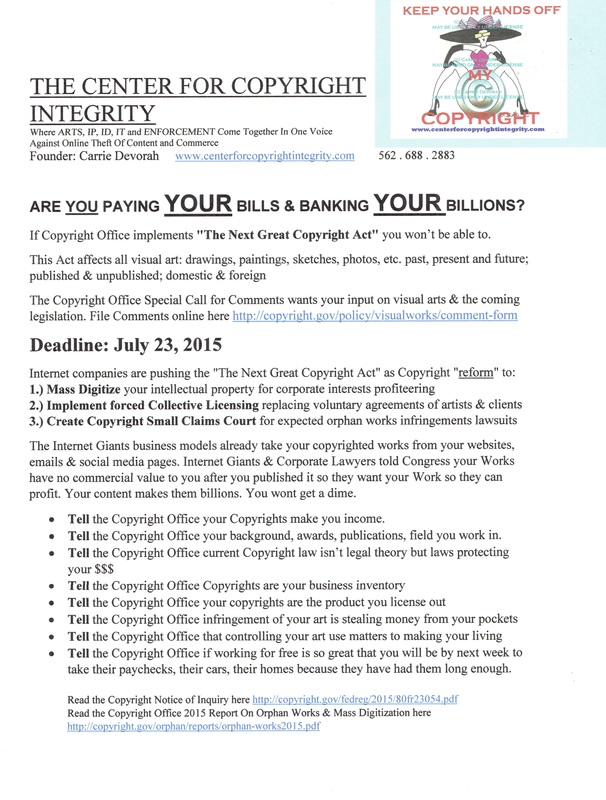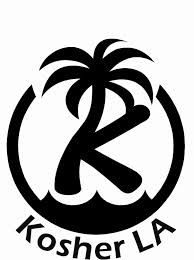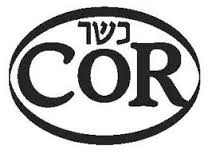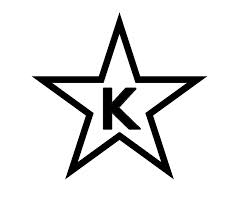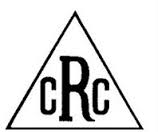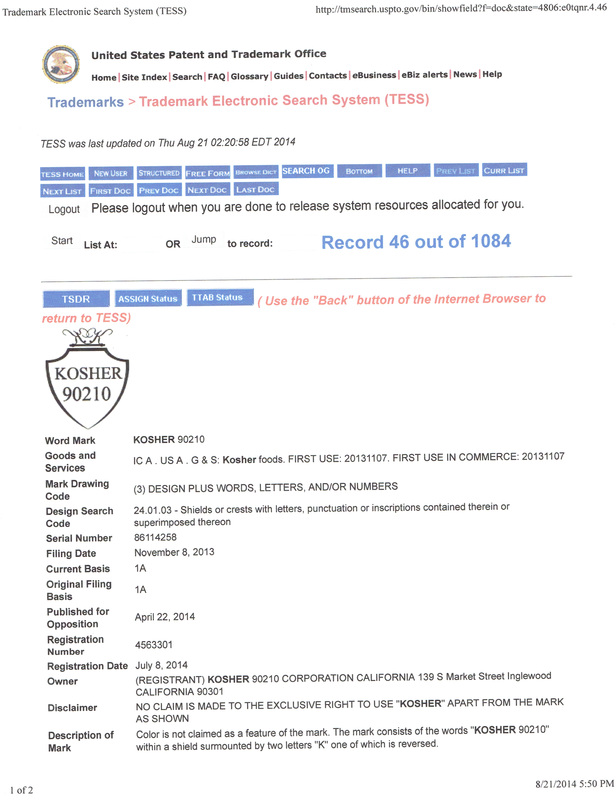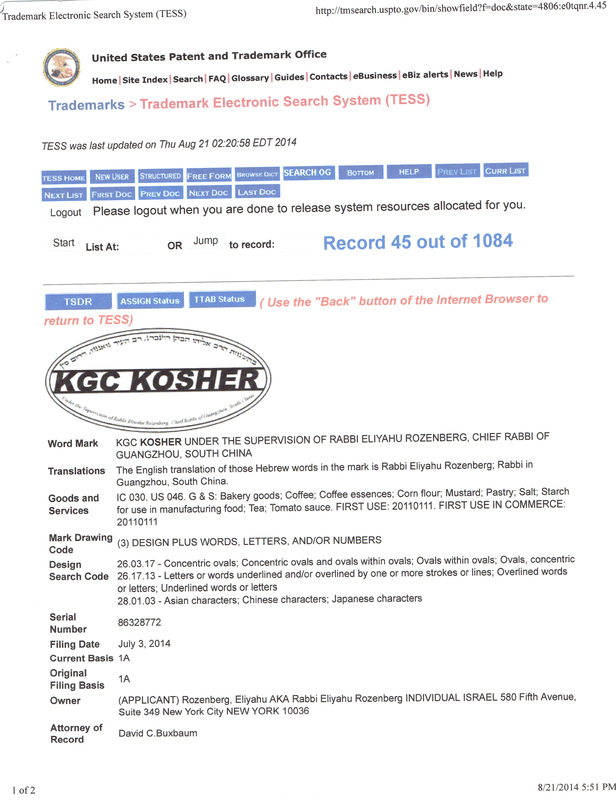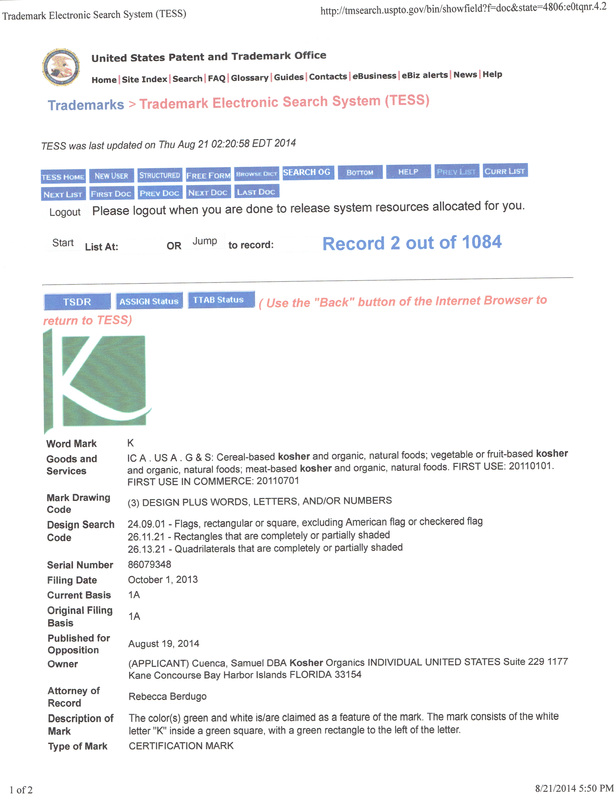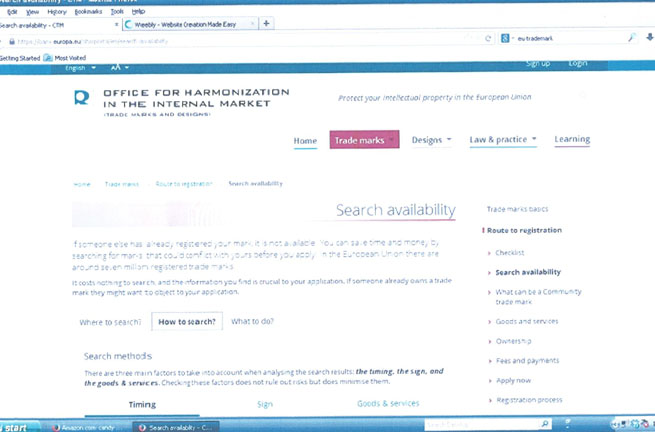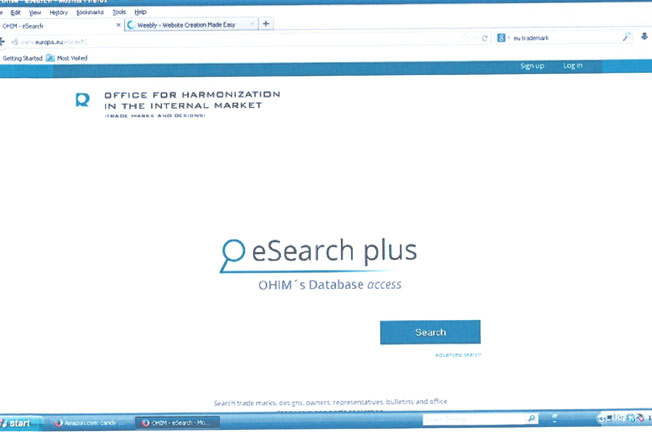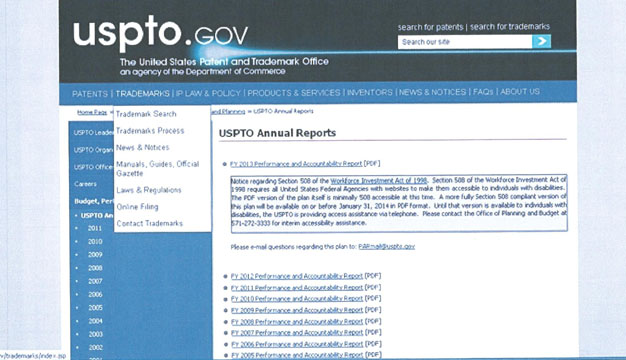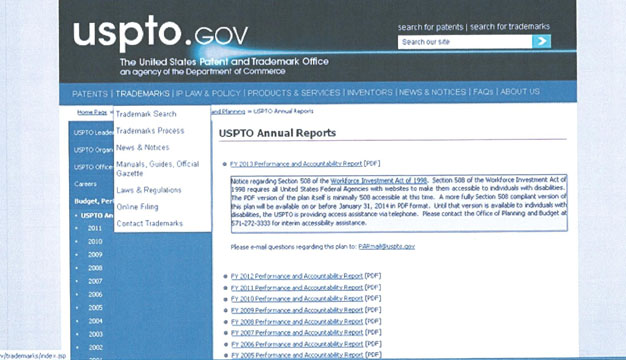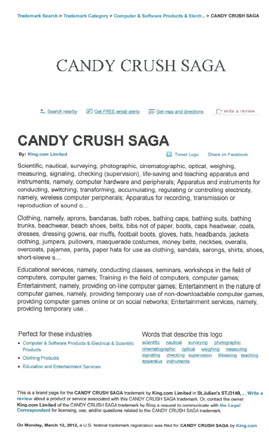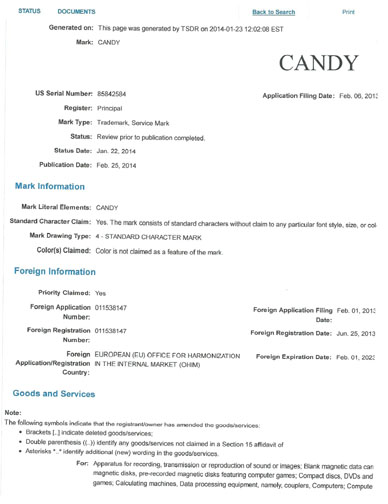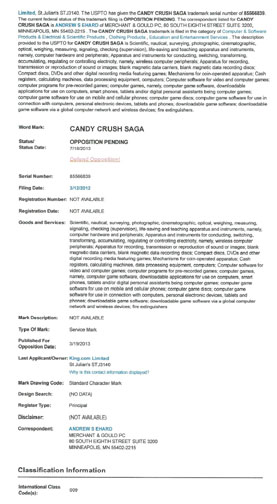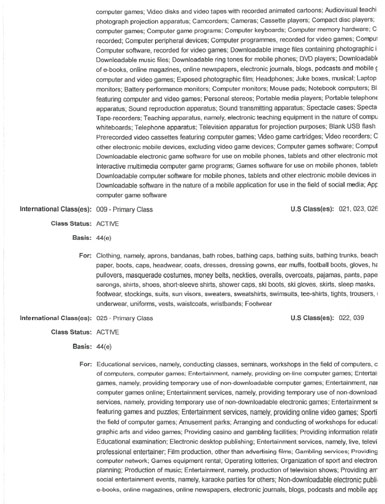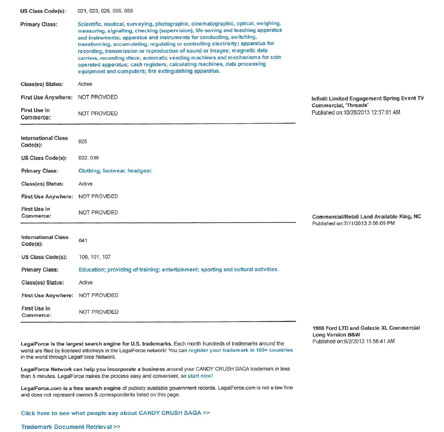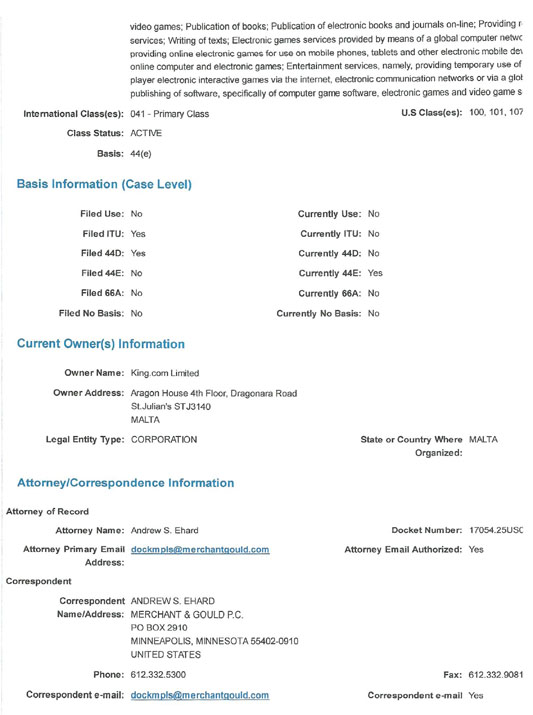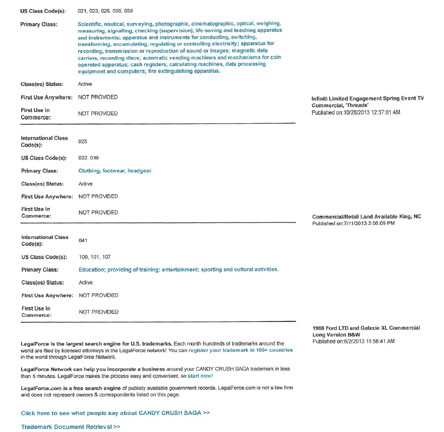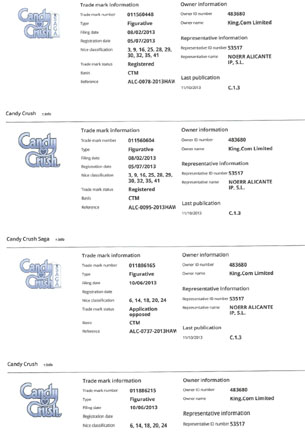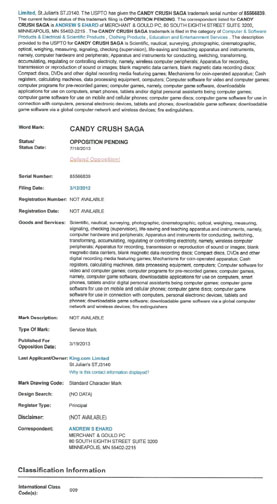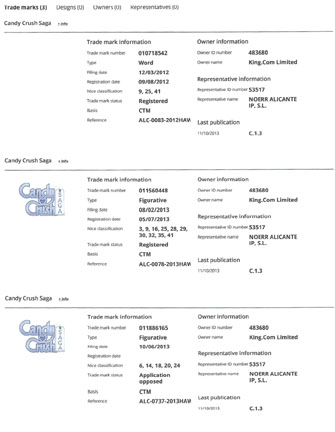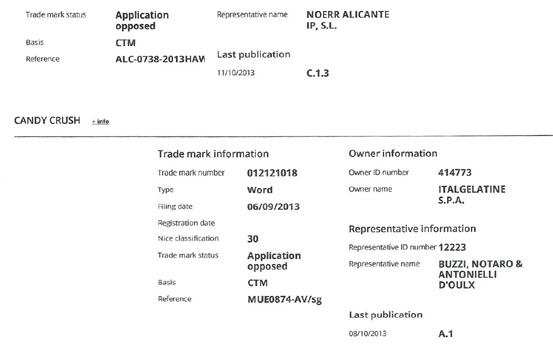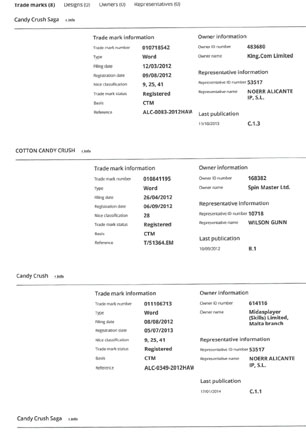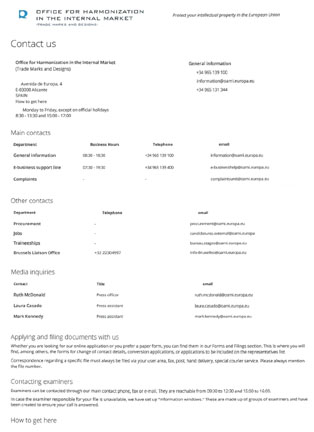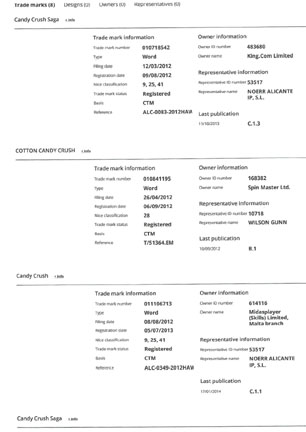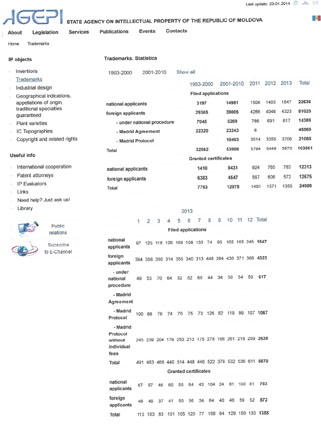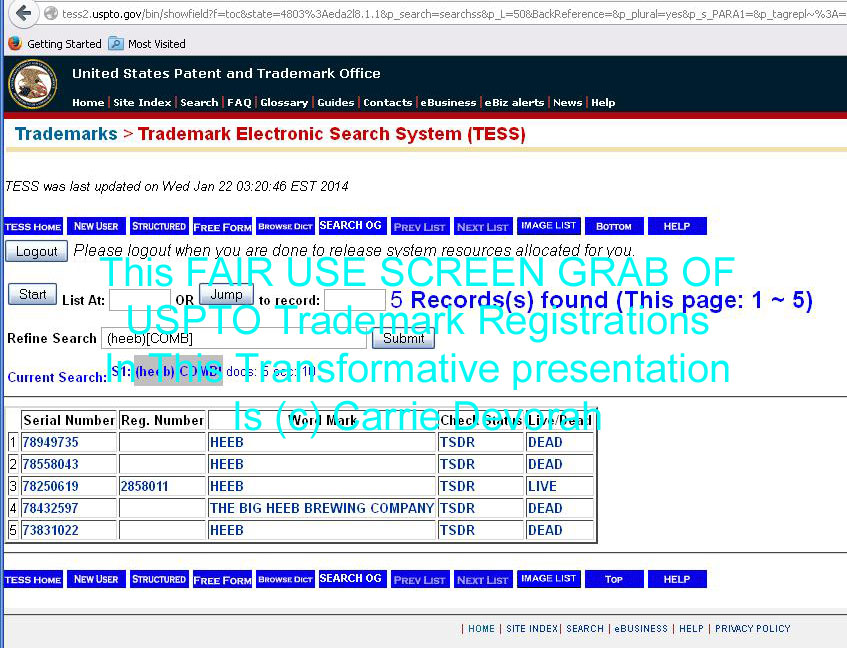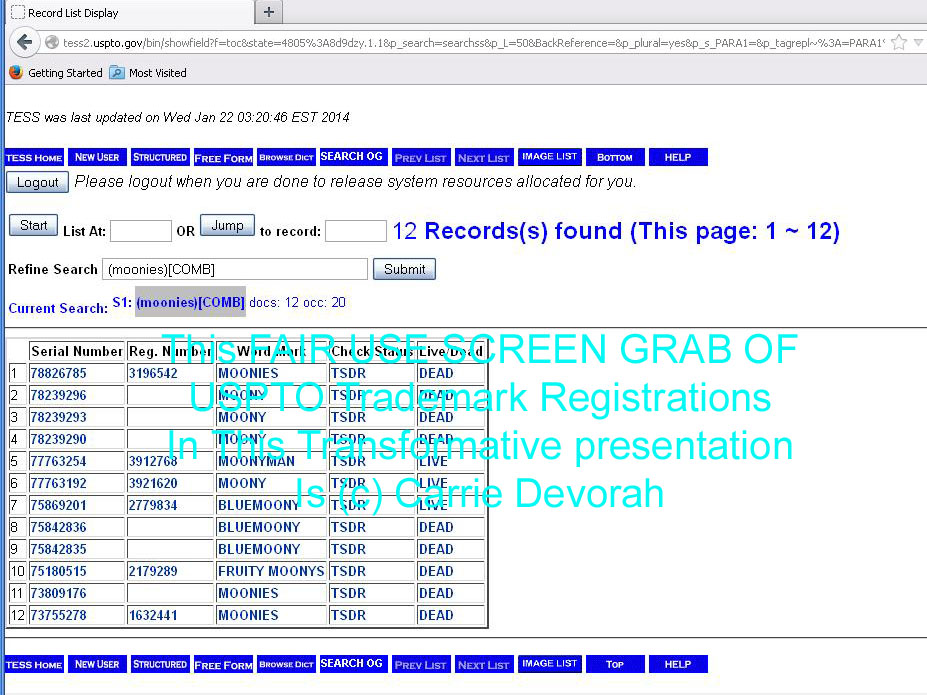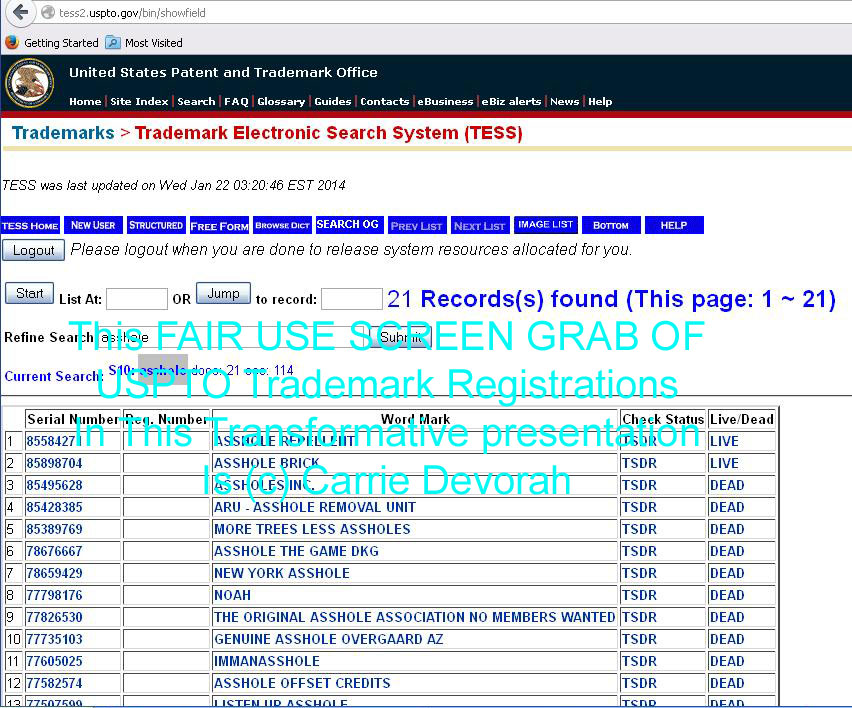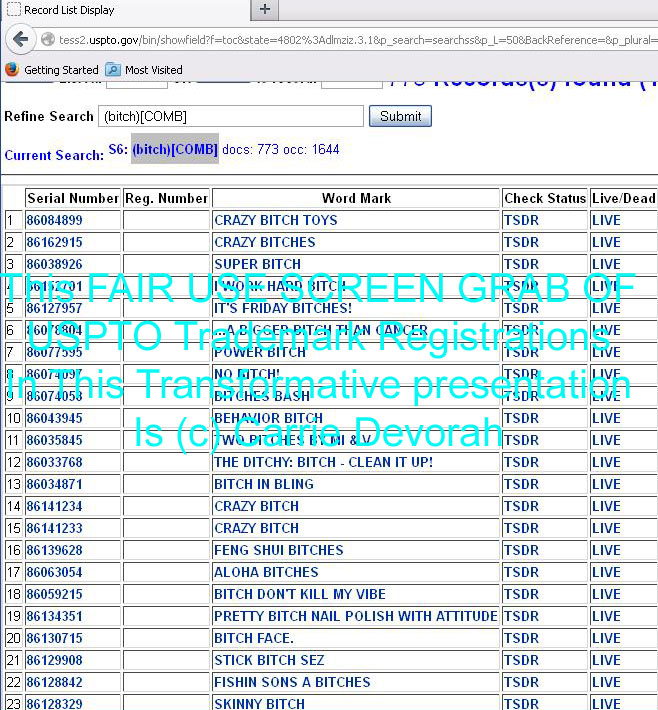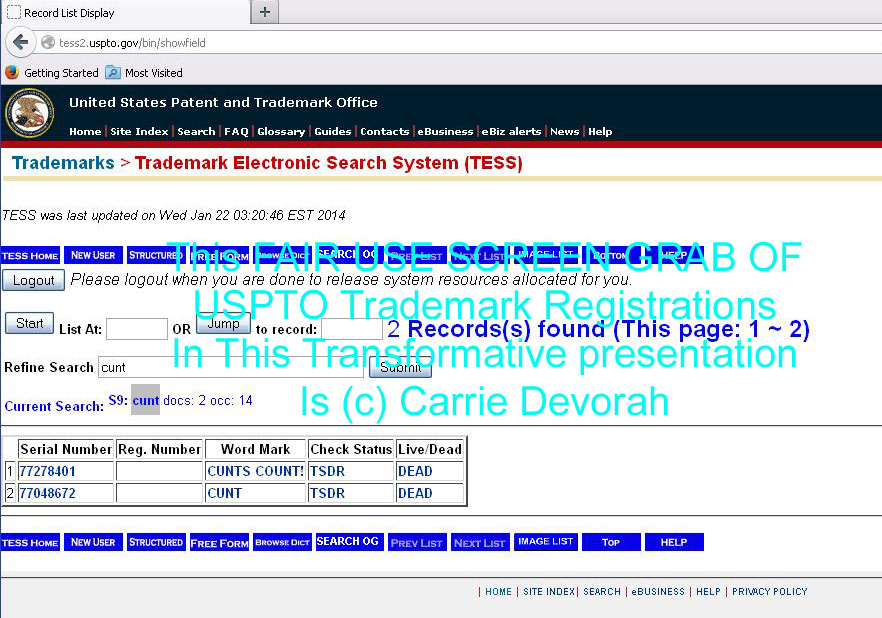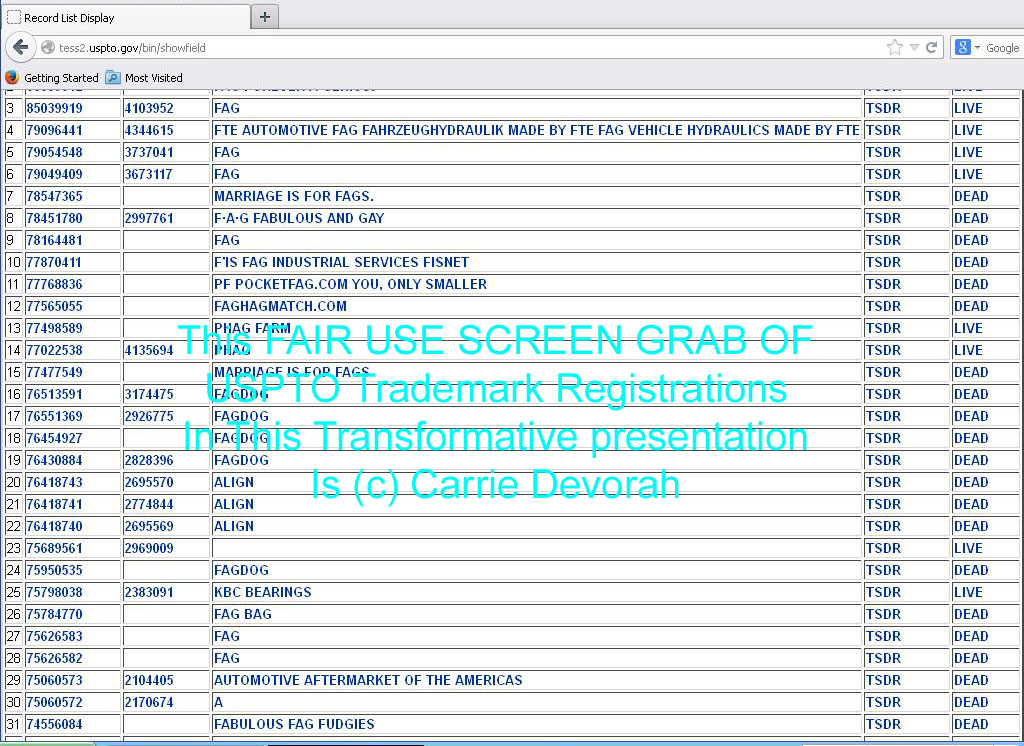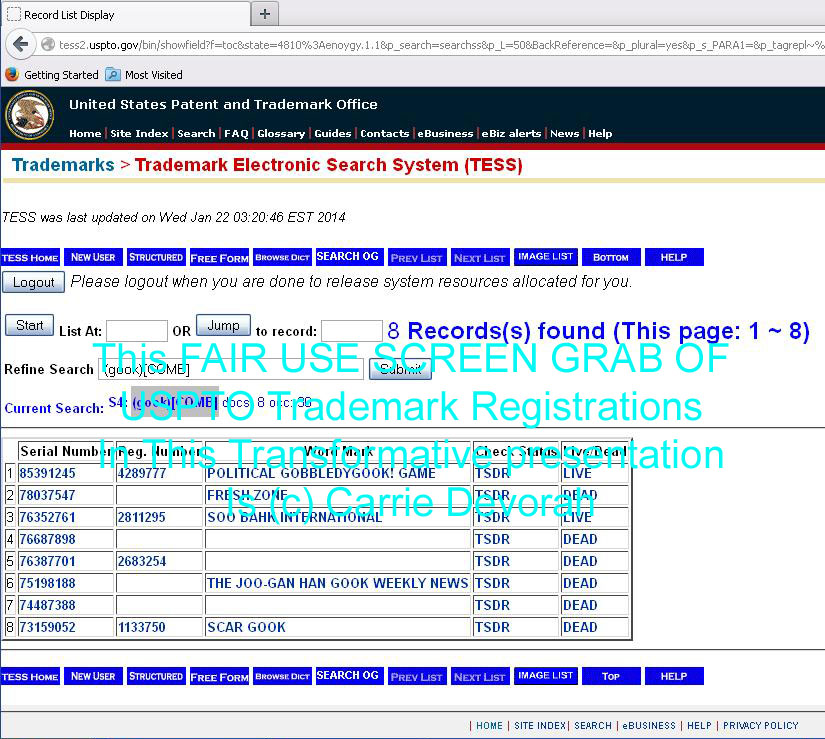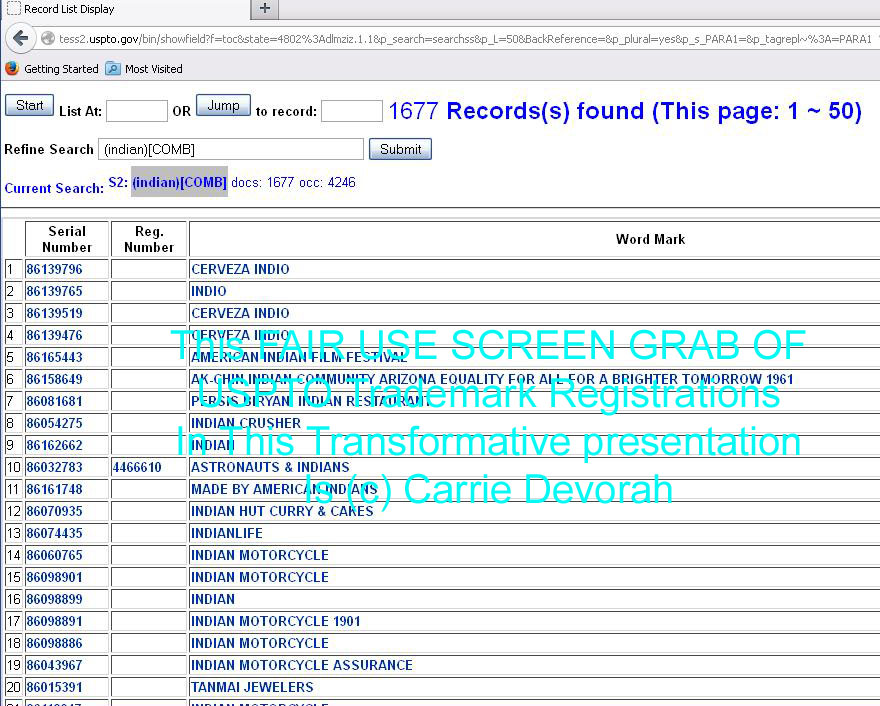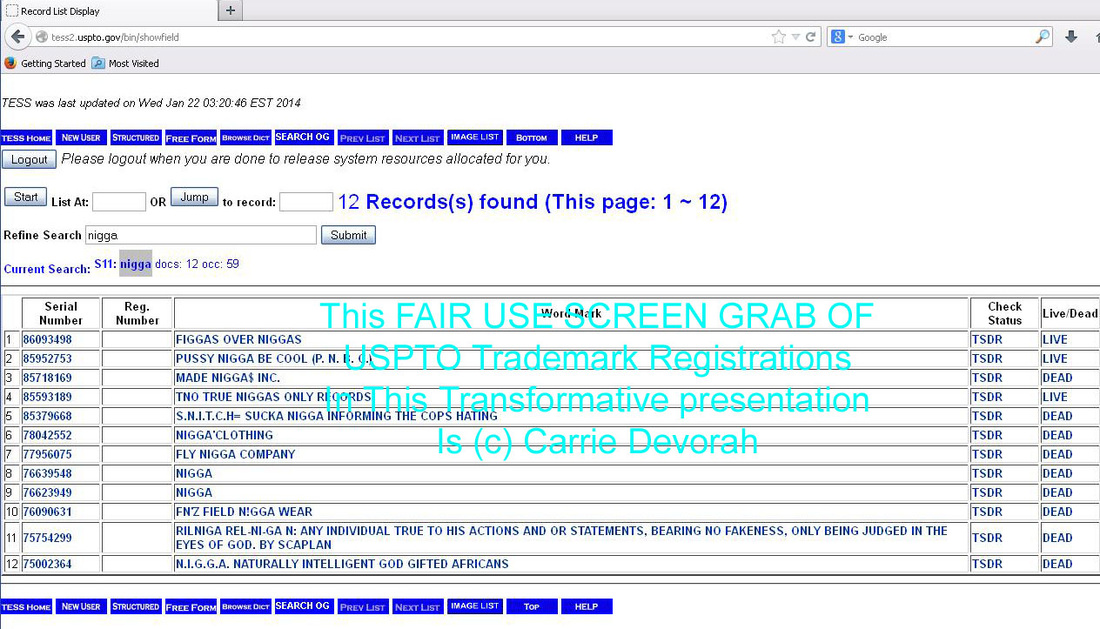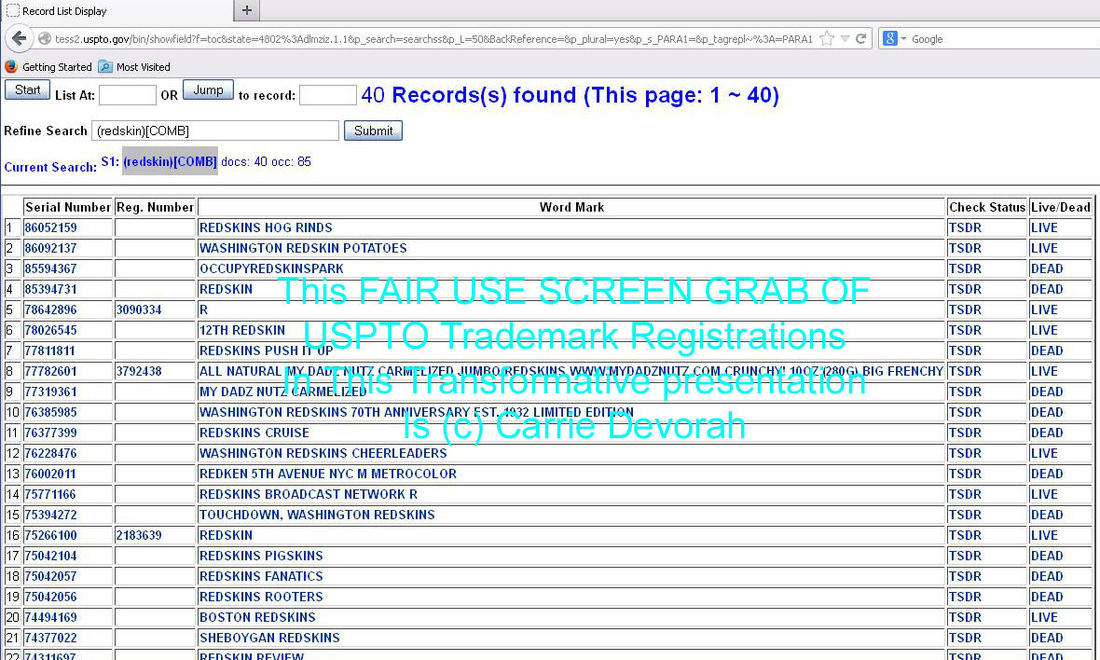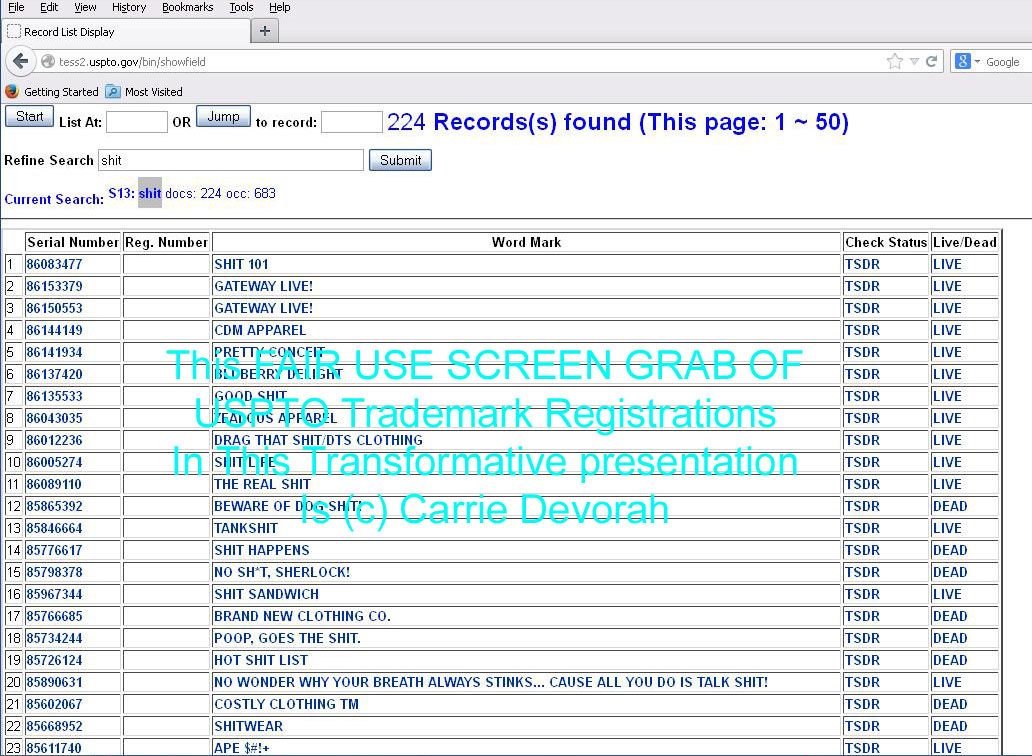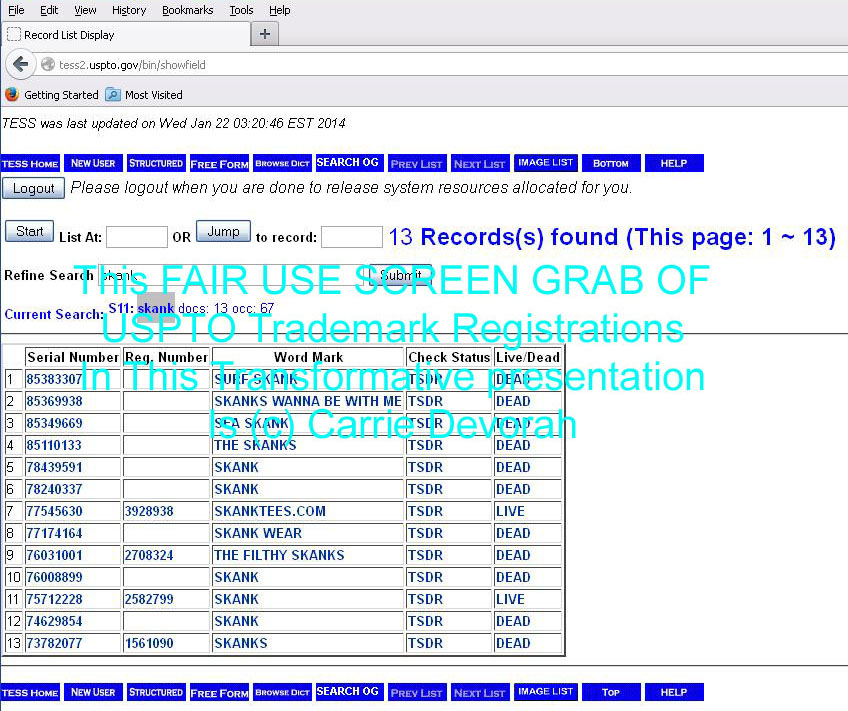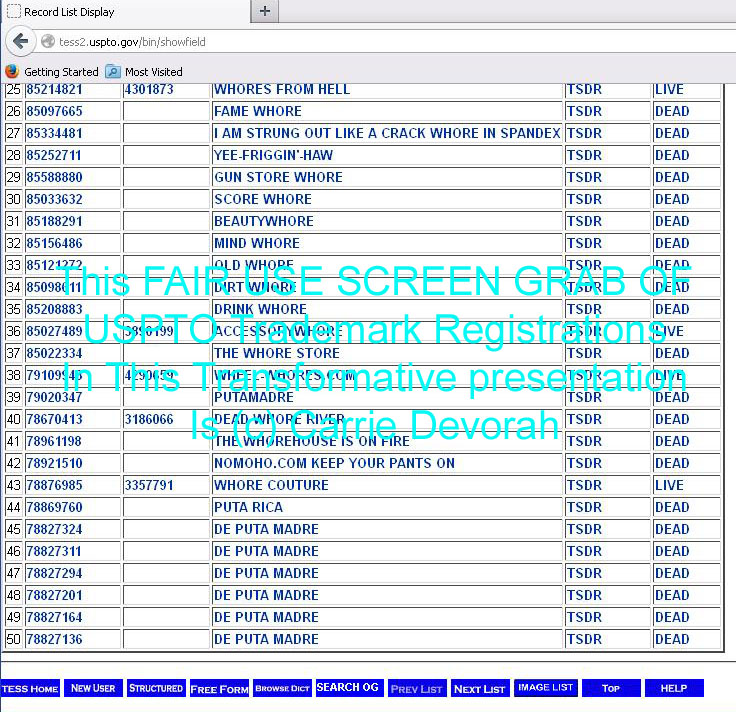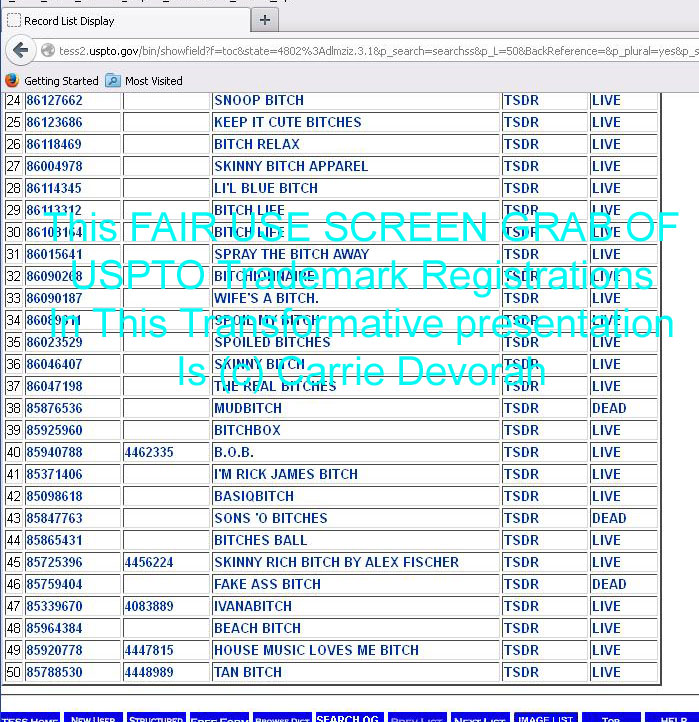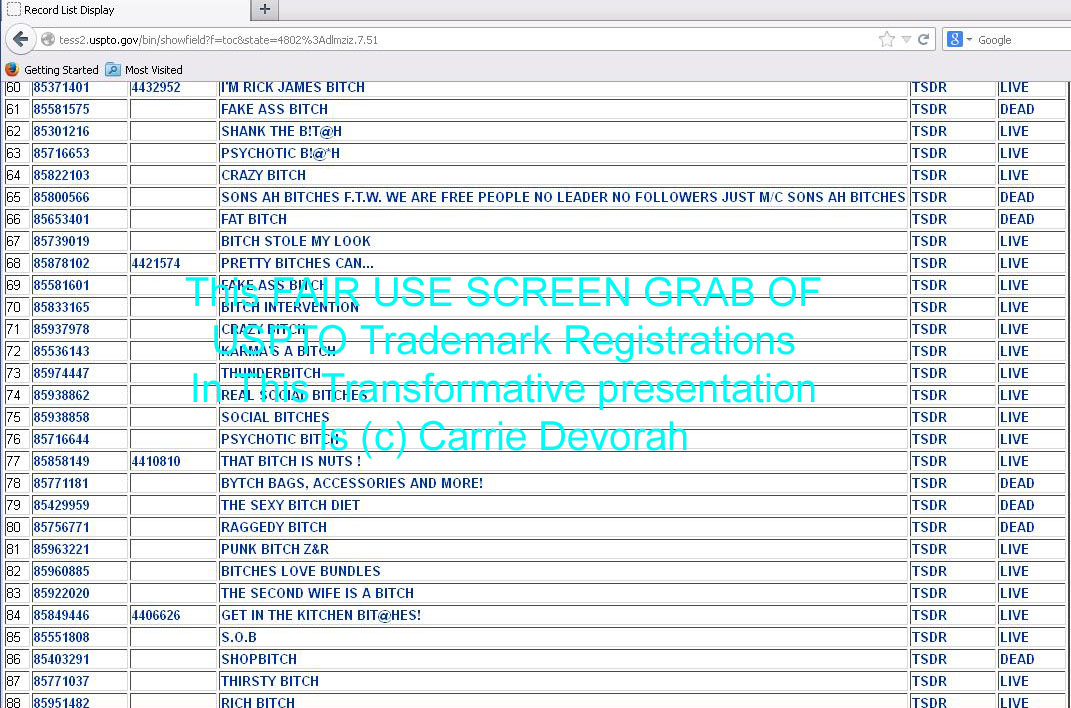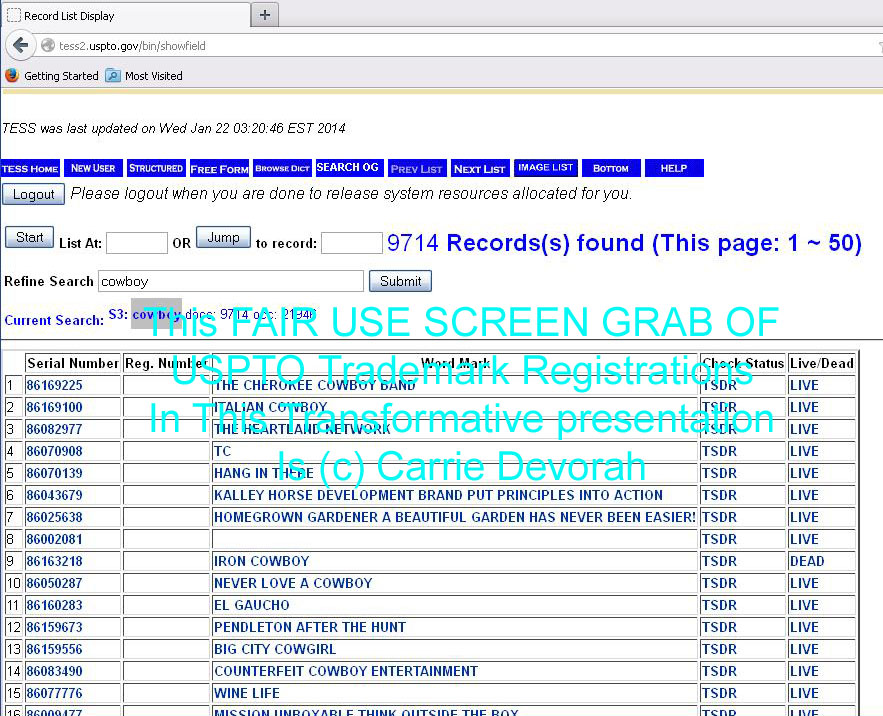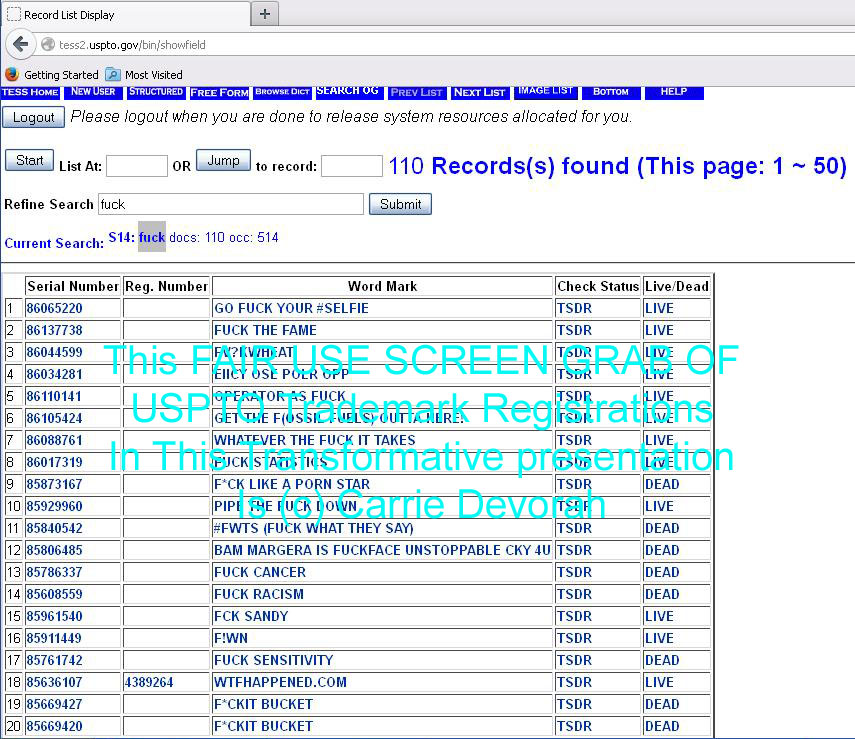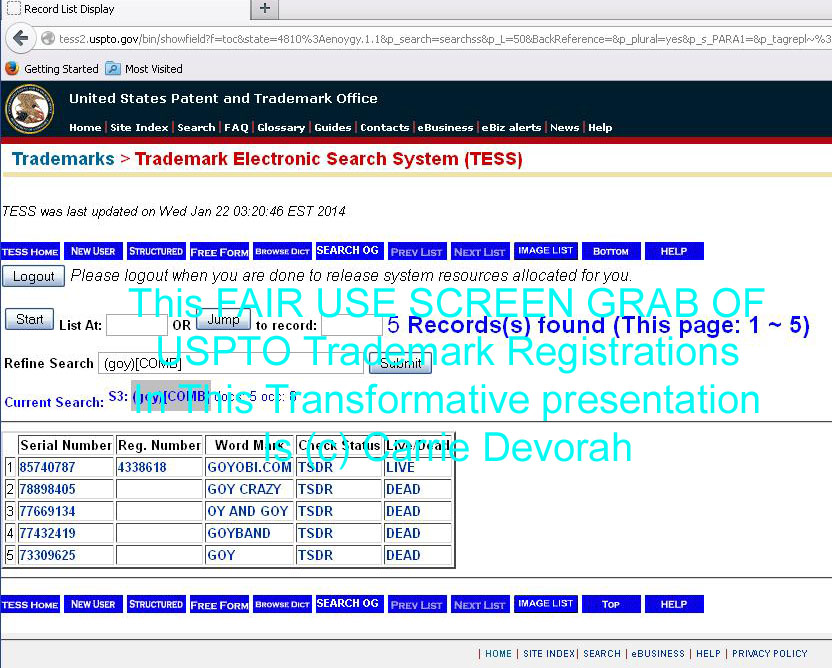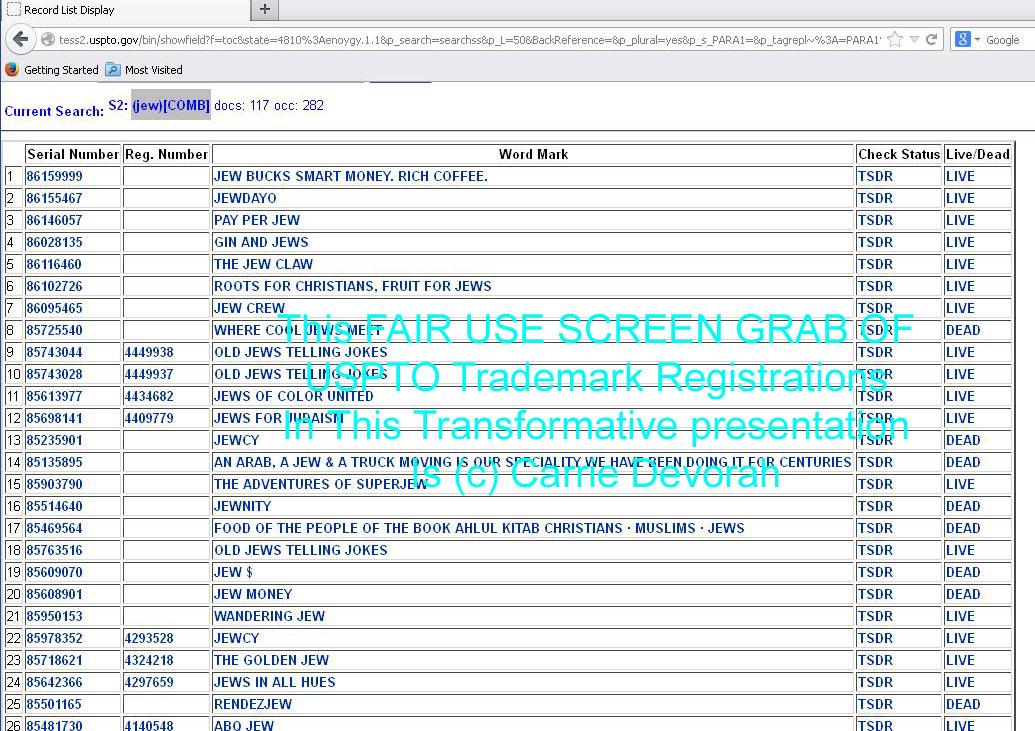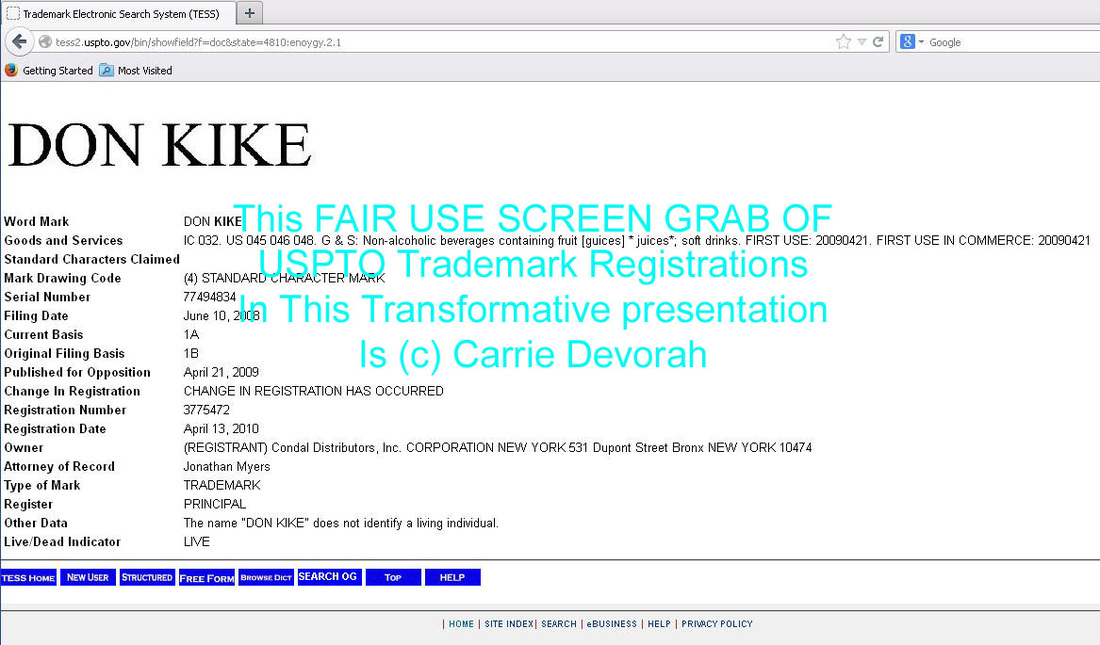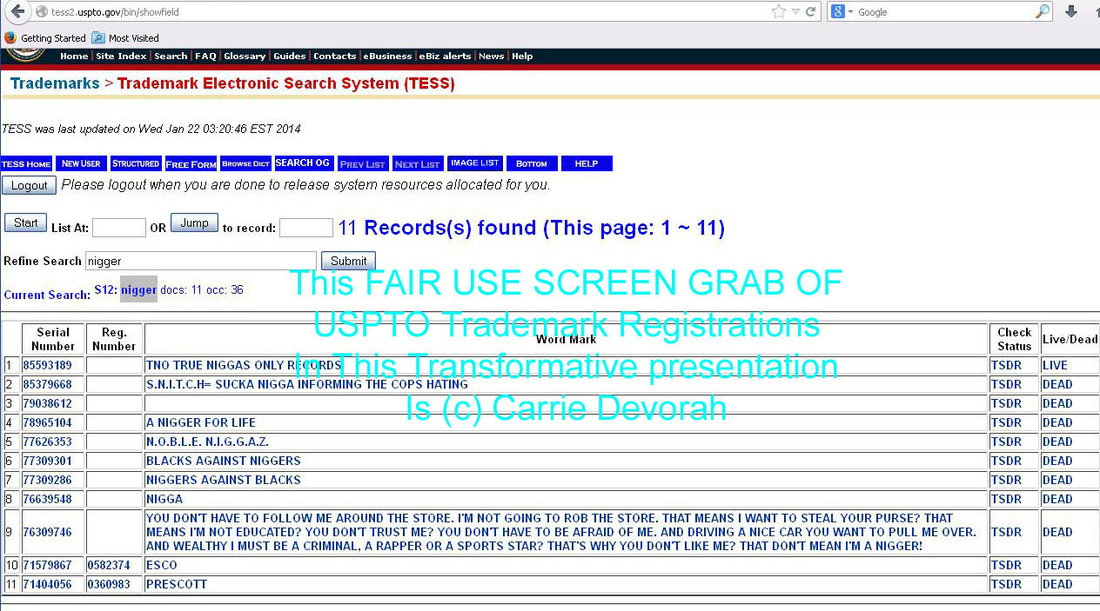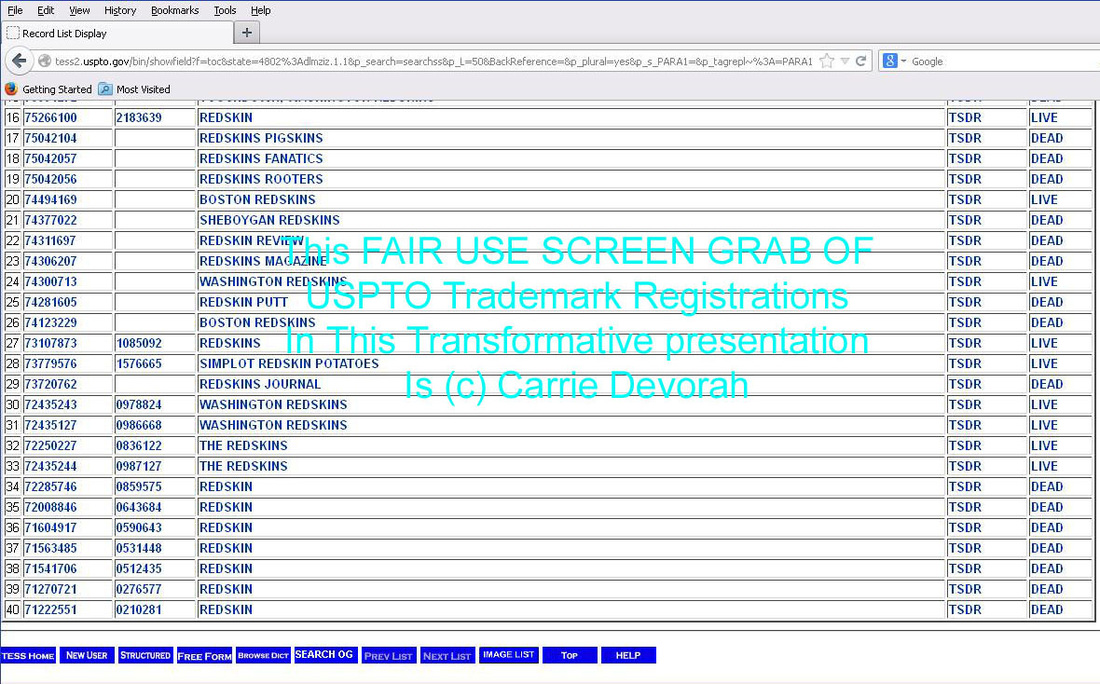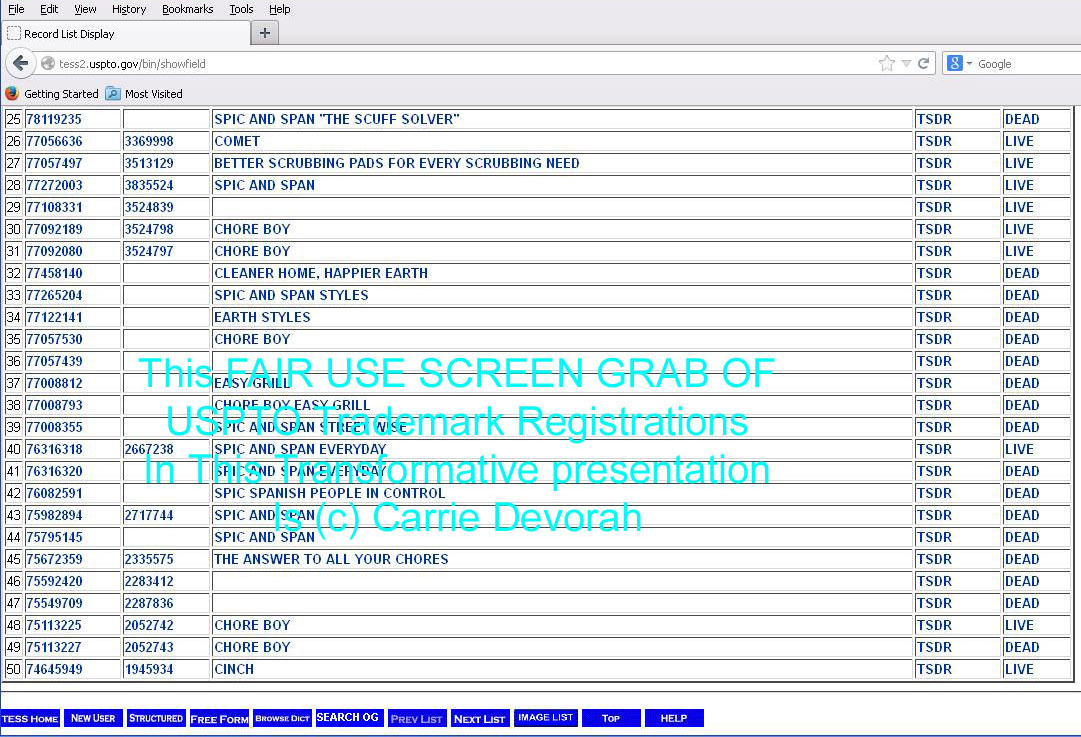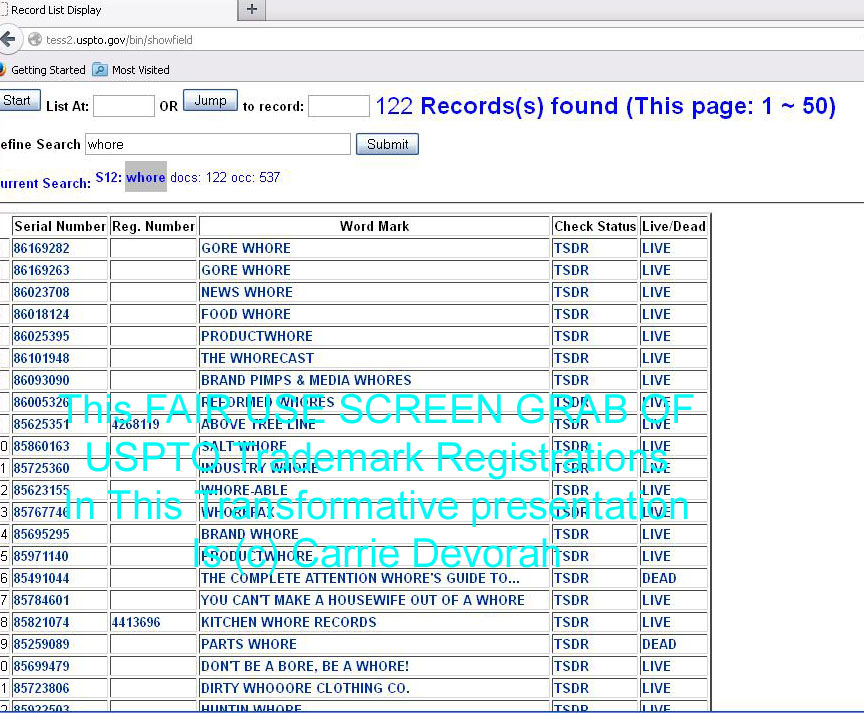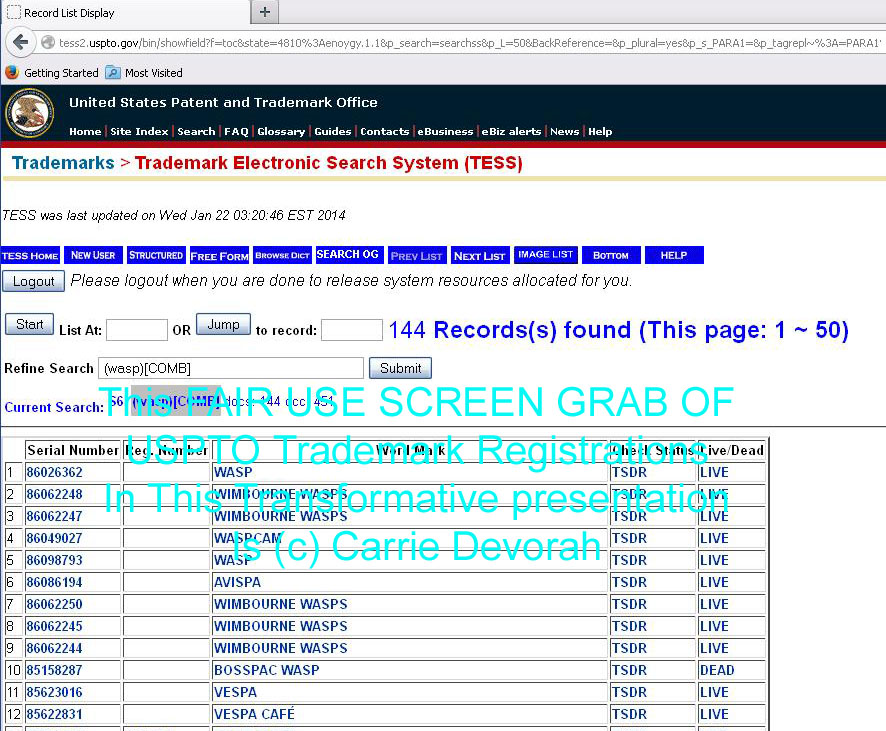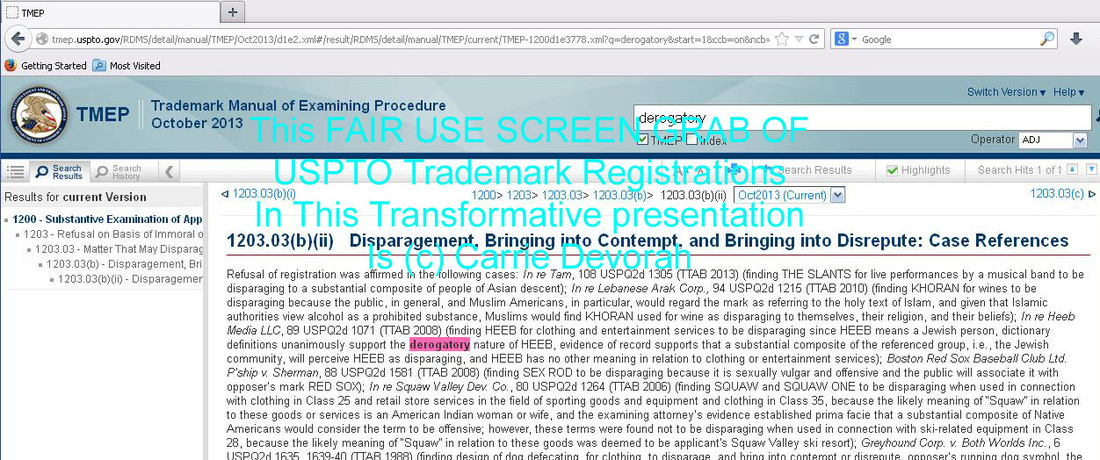|
|
|
Distinguished Toastmaster
BUSINESS & BRANDING COACH . LIFE & LEADERSHIP STRATEGIST MOTIVATIONAL SPEAKER SERVING ENTREPRENEURS & MAIN STREET |
INDEX:
- THE U.S.P.T.O.'s ICONATHON PROJECT (c) Carrie Devorah:
- COMMENT: Section 1201 Exemptions To Prohibition Against Circumvention Of Technological Measures Protectinng Copyrighted Works (c) Carrie Devorah
- COMMENT: RoC RULES TO STREAMLINE RECORDATION PRACTICES & FILING OF E-FEES (c) Carrie Devorah
- COMMENT: PROPOSAL TO ALLOW AMENDMENTS TO IDENTIFICATIONS OF GOODS and SERVICES DUE TO TECHNOLOGY (c) Carrie Devorah
- COMMENT: EXPERIENCE WITH THE FRAMEWORK FOR IMPROVING CRITICAL INFRASTRUCTURE CYBERSECURITY (c) Carrie Devorah
- COMMENT: THE MUSIC LICENSING STUDY (c) Carrie Devorah
- THE HOTELIERS GUIDE FOR GUESTS WHO OBSERVE DIETARY COMPLIANCE OF KOSHER & HALAL SYMBOLS THAT ARE OFTEN TRADEMARKED (c) Carrie Devorah
- THE MURDER OF LEON KLINGHOFFER IS ALSO CONVERSATION OF RIGHTS NOT JUST A CONVERSATION OF ANTI-SEMITISM (c) Carrie Devorah
- MISCELLANEOUS CHANGES TO TRADEMARK RULES OF PRACTICE AND THE RULES OF PRACTICE IN FILINGS PURSUANT TO THE PROTOCOL RELATING TO THE MADRID AGREEMENT CONCERNING THE INTERNATIONAL REGISTRATION OF MARKS (c) Carrie DevorahGNARLY, THE ISSUE OF PATENT TROLLS IS OVERBLOWN (c) Carrie Devorah
- FOR THE WANT OF COPYRIGHT PERMISSIONS A KINGDOM WAS LOST (c) Carrie Devorah
- IS THE REDSKIN CONTROVERSY REALLY ABOUT THE "R"WORD OR IS IT ABOUT SLOPPY FEDERAL WORK and A POLITICAL AGENDA (c) Carrie Devorah
- WHEN THE USPTO GIVES AMERICA's "CANDY" TO A MALTESE CORPORATION (c) Carrie Devorah
________________________________________________________________________________________________________________________________________________
THE U.S.P.T.O.'s ICONATHON PROJECT (c) Carrie Devorah:
________________________________________________________________________________________________________________________________________________
THE U.S.P.T.O.'s ICONATHON PROJECT (c) Carrie Devorah:
________________________________________________________________________________________________________________________________________________
|
|
It was a day of design. The goal was to create ICONS the USPTO, the United States Patent Office would match to titles that have not had symbols- Patents Individuals, Patents Groups, Patents Small Business and such.
You know how big the USPTO mailing list is. And then there is the Noun Project list. The Noun Project and USPTO joined together on The Iconathon project, designing icons intended to be used internationally and interculturally, too. The Noun Project is a dot.com project that allows designers around the world to contribute Icons they designed. One Iconathon participant shared that in his few years of contributing designs to the Noun Project that he has earned $120 in royalties. |
Others, he said, provide their arts work royalty free. The young man has a day job. He is employed. His relating to the freelance world did not exist, nor did it exist for the USPTO employees in attendance, commuting from the upstairs to the downstairs Madison Auditorium. The idea of working for free to maybe make money off of talent and skill was foreign to them. They have security, they said, risk aversive personalities, they said.
Six round tables had people seated. A good more than half were USPTO employees. The rest were designers or the category ‘civic.’ What they shared in common was interest in making a difference.
Attendees flowed to tables and sat. By the time the breakout period was called, ‘communities’ had formed. That is the way of people. They sit. They bond. Bonds don’t break easy.
The icebreaker was creative. A single dice with an icon on each side. Toss the die, then fill in the rest of the icon story, favorite food, travel, book. The answers were surprising. People’s shyness at being intimate to strangers worked.
The monkey wrench in the works was the next request, after people bonded, pick a new community.
The too late directions were to form in to new groups, new communities, consisting of, in the least, a designer, a professional (IT) and a civic person, a civilian. An idea tossed out by a design attended was have a designer place themselves at a table then remain standing. Then have a professional person at the table alongside the designer. Then have a civilian stand at a table alongside the designer and professional. Then let the rest fill in, making sure each group has six people per table.
That good idea was fluffed off by the host until he recognized , too late, the idea he rejected had merit. The table selecting was chaos.The organizer changed course to the designer’s recommendation but, as true as it is in a millennial world, the organizer failed to attribute the succeeding idea was the designer’s contribution.
Lunch over the crunch was on to come up with 19 icons sought by the USPTO. A civilian, a professional and two designers and a hacker has the beginning of a good joke. It turned out to be a lesson in team work, finding strengths, discovering team work and learning that people who work in law think complicated while designers flow left brain.
Organizers like to organize even how people go to vote on their contributed designers. There is an upside to conforming. People get to know people.
The results were alarming.
Greening of America replacing traditional lightbulbs aside, the lightbulb is the number one ‘go to’ the participants drew upon. The participants learned that a day spent looking for new ideas resulted in ideas that were familiar, reminding us the more things change, the more things stay the same. The organizer learned that even after a 7 hour day that sometimes what you get is what you paid for.
Six round tables had people seated. A good more than half were USPTO employees. The rest were designers or the category ‘civic.’ What they shared in common was interest in making a difference.
Attendees flowed to tables and sat. By the time the breakout period was called, ‘communities’ had formed. That is the way of people. They sit. They bond. Bonds don’t break easy.
The icebreaker was creative. A single dice with an icon on each side. Toss the die, then fill in the rest of the icon story, favorite food, travel, book. The answers were surprising. People’s shyness at being intimate to strangers worked.
The monkey wrench in the works was the next request, after people bonded, pick a new community.
The too late directions were to form in to new groups, new communities, consisting of, in the least, a designer, a professional (IT) and a civic person, a civilian. An idea tossed out by a design attended was have a designer place themselves at a table then remain standing. Then have a professional person at the table alongside the designer. Then have a civilian stand at a table alongside the designer and professional. Then let the rest fill in, making sure each group has six people per table.
That good idea was fluffed off by the host until he recognized , too late, the idea he rejected had merit. The table selecting was chaos.The organizer changed course to the designer’s recommendation but, as true as it is in a millennial world, the organizer failed to attribute the succeeding idea was the designer’s contribution.
Lunch over the crunch was on to come up with 19 icons sought by the USPTO. A civilian, a professional and two designers and a hacker has the beginning of a good joke. It turned out to be a lesson in team work, finding strengths, discovering team work and learning that people who work in law think complicated while designers flow left brain.
Organizers like to organize even how people go to vote on their contributed designers. There is an upside to conforming. People get to know people.
The results were alarming.
Greening of America replacing traditional lightbulbs aside, the lightbulb is the number one ‘go to’ the participants drew upon. The participants learned that a day spent looking for new ideas resulted in ideas that were familiar, reminding us the more things change, the more things stay the same. The organizer learned that even after a 7 hour day that sometimes what you get is what you paid for.
________________________________________________________________________________________________________________________________________
FILED COMMENT ON THE "NEXT GREAT COPYRIGHT ACT" (c) Carrie Devorah:
________________________________________________________________________________________________________________________________________
FILED COMMENT ON THE "NEXT GREAT COPYRIGHT ACT" (c) Carrie Devorah:
________________________________________________________________________________________________________________________________________
© CARRIE DEVORAH
THE CENTER FOR COPYRIGHT INTEGRITY
www.centerforcopyrightintegrity.com
562 688 2883
US COPYRIGHT OFFICE
DOCKET No. 2015-01
AGENCY: U.S. COPYRIGHT OFFICE, LIBRARY OF CONGRESS
ACTION: NOTICE OF INQUIRY
Maria Pallante
Register of Copyrights
July 23, 2015
Dear Maria
Given an opportunity, again, to respond to a solicitation, again, on your office attempting to rob artists and photographers of their property and incomes, I thought I would take a more creative approach, factually posed, of course.
An ad online posted in 2012, said “Until October 12, 2010, you may apply for the director of the U.S. Copyright Office and the principal U.S. public official in copyrights. Salary = $165,300. Click for openings in copyright.”[1]
You make in and around $165,300 a year. I don’t. I invested almost 10 years in to covering the White House and Capitol Hill. Me and my colleagues have almost nothing to show for it. The internet busted our careers. Hour per dollar cost ratio, my buddies and I make nothing.
Now, you are colluding with those Internet giants to decimate us even further with the “Next Great Property Robbery” named “The Next Great Copyright Act.”
You said in “Supplementary Information, Background” of the Federal notice, “talent is involved”[2] in our creating arts. The agenda you are pushing robs professionals like me who spent years, studying our craft and building our brand. We don’t work for free.
Our revenues have not declined “over the past few years.” Our revenues have disappeared while the revenues of the ISPs, the Googles, have exponentially exploded in to the billions of earnings. The ISPs, the Googles, have the technology to stop the thefts. You do not force the ISPs and technologies to implement those “speed bump” technologies. Instead, your proposal broadcasts your Final Solution when you should be saying “no, no way, no how. These people have paid millions of dollars to my Agency for protections.”
I think you forgot who you work for, Maria. You work for every person who paid your Agency for Copyright registration. You forgot that our Copyrights remain in effect for the lifetime of the certificate holder plus 70 years unless renewed. You forget the Copyright you registered protects the physical expression of our work. You can’t change that contract you took payment for. You are bound to it for our lives plus 70 years. Breaking that contract is grounds for litigation, and claims of deception.
Your “academic partnership with Stanford Law School…. exploring ways to centrally assemble information concerning marketplace resources for the licensing of photographs and the data standards relied upon by copyright owners and licensees to engage in such transactions” is misguided.
Stanford = Google.
I do my own licensing agreements. Not Google. Not the USPTO. Not the Department of Commerce and ICANN. Not the UK Copyright Hub.
What part of “I don’t work for free” are you not getting from my Arts community. We did not train and work hard to build yours and Google’s ambition of the largest stock agencies in the globe implemented using the Orphan Works ideas, collective licensing and mass digitization.
Let me put Orphan Works, Collective Licensing and Mass Digitization in to your work world terms.
Orphan Works? Well, time to remove all security guards from the Library of Congress doors. No more need to check for stolen LOC property anymore. The Guttenberg Bible in the glass case off the foyer? The marble angels on the Grand Hall bannisters? The rare book collection? Your purse in your office? Free for the taking, since you think our Arts should belong to everybody, free for the taking.
Collective Licensing? You and your Copyright Office co-workers will pool your salaries, bonuses and overtimes in to a collective pay-pot that you will all draw from. The guy sweeping floors, the women at the information desk and cafeteria, too, will share in your $165,300 paycheck, after all, that is what you are asking of me.
Mass Digitization? Well, you did it with Google Books….. Google testified in their New York pleadings that your Library gave Google access to your collection, copyrighted and non copyrighted, all for the cost of an e-book copy, that permission of the owner was not sought… according to Google
Answering your questions;
· The most significant challenge to my earning money from my written, drawn and photographic arts is theft of my property by the ISPS, bots, online auctions. Time spent researching image thefts is time not spent on me and/or creating.
· The most significant enforcement challenges is that the ISPs and webhosts have locking technologies available to them that they do not implement to stop thefts and sharing. Theft should be reportable to local police and state enforcement. Theft is theft.
· The most significant registration challenges is that you have walked away from the Berne Convention which says creating of an image is when protection begins, that the Content is protected without having to pay a fee to your office. The fee paid to your office does not guarantee a lawyer will want to represent us against thieves. Lawyers run businesses, too.
· In an internet world when anyone can be found online, there is no challenge for someone who wants to make use of a photo. If the owner of the Arts says ‘no,’ that is the answer. If the owner of the Arts cannot be found, that is the answer too. The Arts cannot be used. Make it yourself or use another image.
· The Copyright Act is government condoned theft, Eminent Domain of other people’s Arts property.
I worked in DC covering the White House and Capitol Hill. We don’t see the totality of our stolen property. The ISPs and Googles restricting image searches to our location at search time. The attached images and screengrabs show that ISPs and Search engines knowingly stole my images. They post the pop-up Disclaimer “these images may be copyrighted.” The list includes that thieves put their watermarks on our images or stretch stolen thumbnails for use without payment. Those images you want me to let Google use for free, means no money for me.
The government attitude is to protect the “jobs” person while tossing the small business entrepreneur, solopreneur or freelancer, under the bus. As a freelancer, I don’t get minimum wage or a guaranteed $15.00 an hour; I don’t get health benefits, medical and dental plans or maternity leave; I get vacation pay; I don’t get overtime when I have to work a 24 hour day; I don’t get a pension. If I don’t work, I don’t get paid.
If you think working for free is respectful, I have a proposal for you, a challenge to you, to Bill Gates, Eric Schmidt, Mark Zuckerberg, Jeff Bezos, Jack Ma, Marissa Mayer, Arianna Huffington, Dick Costello, Sergey Brin, Pierre Omidyar and techs others.
Maria, as the expression goes “to know someone, walk a mile in their shoes.” I am challenging you to walk in the Arts creators shoes, for a week, on camera, in disguise.
You will ‘walk’ in a career in an arts- dance, music, visual art, design, photography, writer- determined by ‘short straw.’ You will walk out the door, disguised. For one week you will be going “Creative Commando.” You will be given a backstory and a paper bag. You will be issued an identity, good or bad. You will be assigned the art you will have to earn a living in. What you get in that bag is what you will use to build your Wealth. You will have to create a signature Arts from which you will make monies to live off of. You may end up with others, in a foreign country or a block away. Expect that you will be hit with the unexpected. The unexpected may be good, may be bad. You will live naked and raw to the film crew following you. No one will know your real life identity. You will have no lifelines. You will learn this no ‘gameshow.’ You will learn this reality show you are stripping my IP and property ownership, is my life.
A spin of the wheel will determine the portion of your salary that you will donate to an Arts charity chosen by another spin of the wheel. Let’s see how you survive walking in my design shoes. I am sure I can pitch or sell the show to Discovery, PBS or TLC. Better yet, I can i-film you on my i-pad.
For the record, anyone out there thinking they can Steal This Idea. Not yet. Why? Because the Next Great Copyright Act is not law yet. This concept is protected
My Arts allowed me a single mom to raise my sons myself without financial support from their dad. My Arts were supposed to let me care for me as I head in to my Golden Years. I can’t do that, now. Go to my website to look at the “image” pages I wanted to attach to my comment submission but could not. These image pages are just a sampling of the laws the ISPs are breaking in stealing my Arts content and distributing it internationally ( http://www.centerforcopyrightintegrity.com/roc--uspto-patents--trademarks.html )
Look at the screengrabs where it says “images may be copyrighted.” Not maybe. THEY ARE.
In the America I live in knowingly working with someone who is an accessory to a crime makes them subject to criminal law also. I know, I know, I know. Laws can and are changed to accommodate deeper pockets. Know this, Maria. It will be your legacy that you were party to this. All the APPS in the world won’t change that.
Respecting your job is not to be the originator of an idea but to implement the laws that Congress writes and tells you to implement, look twice at those parties giving the order, on the Judiciary, now, ‘cross the pond’ to compare to UK Legislators. Screengrabs available on my website to see for yourself that the UK Legislators give FULL disclosure of what they own in holdings, and positions and other data that shows the public the influences the UK parliament are vested in.
To hear only at a hearing that Congressman Goodlatte’s son worked at Facebook, reduced my faith in his ability to be fair to the Arts Content world, raising then, the question, what does he own, partner in, sit on the Board of, etc., etc, along with all of the Judiciary, the Small Business, the Financial Services, the Health/Labor/Pensions, the Energy & Commerce committees, some of the all with a voice in my Arts future.
Lets be real with the numbers- look at the screengrab samples on this webpage. There ALONE over 140 samplings of my IP aggregated in to a one stop shop that I have tracked my images from to sites/domains around the world. Results vary depending on what zipcode I sit in when the search is done. Google boxes Search ability in.
You are looking at 140 litigations I am faced with. I want to draw. I want to write. I want to take photographs not spend my time looking to see who stole from me now. I want your $160K salary or more that my invested work will earn. I want you to make the ISPs criminals, as called for in Title 18 of the Code- the term for people who steal other people’s property. Or else? I want you to entitle me as a freelancer to all the unemployment and other benefits that a “jobs” person gets.
Your other option is where you are pushing me and my community, in to debt and on to the welfare rolls. THIS will be your legacy. We know each other, Maria. You are a nice person doing your job. You deserve better.
Accept my challenge. Walk in my Arts footsteps. Go “Creative Commando,” learn firsthand about working for free. Or else, meet you on the Soup Line over at 3rd near Judiciary Square.
Sincerely
Carrie Devorah
Founder
THE CENTER FOR COPYRIGHT INTEGRITY www.centerforcopyrightintegrity.com
[1] http://www.copyrightlaws.com/us/u-s-register-of-copyright-marybeth-peters-is-retiring/
[2] Federal Register/Vol. 80, No. 79/ Friday, April 24, 2015/ Notices, Page 23054
THE CENTER FOR COPYRIGHT INTEGRITY
www.centerforcopyrightintegrity.com
562 688 2883
US COPYRIGHT OFFICE
DOCKET No. 2015-01
AGENCY: U.S. COPYRIGHT OFFICE, LIBRARY OF CONGRESS
ACTION: NOTICE OF INQUIRY
Maria Pallante
Register of Copyrights
July 23, 2015
Dear Maria
Given an opportunity, again, to respond to a solicitation, again, on your office attempting to rob artists and photographers of their property and incomes, I thought I would take a more creative approach, factually posed, of course.
An ad online posted in 2012, said “Until October 12, 2010, you may apply for the director of the U.S. Copyright Office and the principal U.S. public official in copyrights. Salary = $165,300. Click for openings in copyright.”[1]
You make in and around $165,300 a year. I don’t. I invested almost 10 years in to covering the White House and Capitol Hill. Me and my colleagues have almost nothing to show for it. The internet busted our careers. Hour per dollar cost ratio, my buddies and I make nothing.
Now, you are colluding with those Internet giants to decimate us even further with the “Next Great Property Robbery” named “The Next Great Copyright Act.”
You said in “Supplementary Information, Background” of the Federal notice, “talent is involved”[2] in our creating arts. The agenda you are pushing robs professionals like me who spent years, studying our craft and building our brand. We don’t work for free.
Our revenues have not declined “over the past few years.” Our revenues have disappeared while the revenues of the ISPs, the Googles, have exponentially exploded in to the billions of earnings. The ISPs, the Googles, have the technology to stop the thefts. You do not force the ISPs and technologies to implement those “speed bump” technologies. Instead, your proposal broadcasts your Final Solution when you should be saying “no, no way, no how. These people have paid millions of dollars to my Agency for protections.”
I think you forgot who you work for, Maria. You work for every person who paid your Agency for Copyright registration. You forgot that our Copyrights remain in effect for the lifetime of the certificate holder plus 70 years unless renewed. You forget the Copyright you registered protects the physical expression of our work. You can’t change that contract you took payment for. You are bound to it for our lives plus 70 years. Breaking that contract is grounds for litigation, and claims of deception.
Your “academic partnership with Stanford Law School…. exploring ways to centrally assemble information concerning marketplace resources for the licensing of photographs and the data standards relied upon by copyright owners and licensees to engage in such transactions” is misguided.
Stanford = Google.
I do my own licensing agreements. Not Google. Not the USPTO. Not the Department of Commerce and ICANN. Not the UK Copyright Hub.
What part of “I don’t work for free” are you not getting from my Arts community. We did not train and work hard to build yours and Google’s ambition of the largest stock agencies in the globe implemented using the Orphan Works ideas, collective licensing and mass digitization.
Let me put Orphan Works, Collective Licensing and Mass Digitization in to your work world terms.
Orphan Works? Well, time to remove all security guards from the Library of Congress doors. No more need to check for stolen LOC property anymore. The Guttenberg Bible in the glass case off the foyer? The marble angels on the Grand Hall bannisters? The rare book collection? Your purse in your office? Free for the taking, since you think our Arts should belong to everybody, free for the taking.
Collective Licensing? You and your Copyright Office co-workers will pool your salaries, bonuses and overtimes in to a collective pay-pot that you will all draw from. The guy sweeping floors, the women at the information desk and cafeteria, too, will share in your $165,300 paycheck, after all, that is what you are asking of me.
Mass Digitization? Well, you did it with Google Books….. Google testified in their New York pleadings that your Library gave Google access to your collection, copyrighted and non copyrighted, all for the cost of an e-book copy, that permission of the owner was not sought… according to Google
Answering your questions;
· The most significant challenge to my earning money from my written, drawn and photographic arts is theft of my property by the ISPS, bots, online auctions. Time spent researching image thefts is time not spent on me and/or creating.
· The most significant enforcement challenges is that the ISPs and webhosts have locking technologies available to them that they do not implement to stop thefts and sharing. Theft should be reportable to local police and state enforcement. Theft is theft.
· The most significant registration challenges is that you have walked away from the Berne Convention which says creating of an image is when protection begins, that the Content is protected without having to pay a fee to your office. The fee paid to your office does not guarantee a lawyer will want to represent us against thieves. Lawyers run businesses, too.
· In an internet world when anyone can be found online, there is no challenge for someone who wants to make use of a photo. If the owner of the Arts says ‘no,’ that is the answer. If the owner of the Arts cannot be found, that is the answer too. The Arts cannot be used. Make it yourself or use another image.
· The Copyright Act is government condoned theft, Eminent Domain of other people’s Arts property.
I worked in DC covering the White House and Capitol Hill. We don’t see the totality of our stolen property. The ISPs and Googles restricting image searches to our location at search time. The attached images and screengrabs show that ISPs and Search engines knowingly stole my images. They post the pop-up Disclaimer “these images may be copyrighted.” The list includes that thieves put their watermarks on our images or stretch stolen thumbnails for use without payment. Those images you want me to let Google use for free, means no money for me.
The government attitude is to protect the “jobs” person while tossing the small business entrepreneur, solopreneur or freelancer, under the bus. As a freelancer, I don’t get minimum wage or a guaranteed $15.00 an hour; I don’t get health benefits, medical and dental plans or maternity leave; I get vacation pay; I don’t get overtime when I have to work a 24 hour day; I don’t get a pension. If I don’t work, I don’t get paid.
If you think working for free is respectful, I have a proposal for you, a challenge to you, to Bill Gates, Eric Schmidt, Mark Zuckerberg, Jeff Bezos, Jack Ma, Marissa Mayer, Arianna Huffington, Dick Costello, Sergey Brin, Pierre Omidyar and techs others.
Maria, as the expression goes “to know someone, walk a mile in their shoes.” I am challenging you to walk in the Arts creators shoes, for a week, on camera, in disguise.
You will ‘walk’ in a career in an arts- dance, music, visual art, design, photography, writer- determined by ‘short straw.’ You will walk out the door, disguised. For one week you will be going “Creative Commando.” You will be given a backstory and a paper bag. You will be issued an identity, good or bad. You will be assigned the art you will have to earn a living in. What you get in that bag is what you will use to build your Wealth. You will have to create a signature Arts from which you will make monies to live off of. You may end up with others, in a foreign country or a block away. Expect that you will be hit with the unexpected. The unexpected may be good, may be bad. You will live naked and raw to the film crew following you. No one will know your real life identity. You will have no lifelines. You will learn this no ‘gameshow.’ You will learn this reality show you are stripping my IP and property ownership, is my life.
A spin of the wheel will determine the portion of your salary that you will donate to an Arts charity chosen by another spin of the wheel. Let’s see how you survive walking in my design shoes. I am sure I can pitch or sell the show to Discovery, PBS or TLC. Better yet, I can i-film you on my i-pad.
For the record, anyone out there thinking they can Steal This Idea. Not yet. Why? Because the Next Great Copyright Act is not law yet. This concept is protected
My Arts allowed me a single mom to raise my sons myself without financial support from their dad. My Arts were supposed to let me care for me as I head in to my Golden Years. I can’t do that, now. Go to my website to look at the “image” pages I wanted to attach to my comment submission but could not. These image pages are just a sampling of the laws the ISPs are breaking in stealing my Arts content and distributing it internationally ( http://www.centerforcopyrightintegrity.com/roc--uspto-patents--trademarks.html )
Look at the screengrabs where it says “images may be copyrighted.” Not maybe. THEY ARE.
In the America I live in knowingly working with someone who is an accessory to a crime makes them subject to criminal law also. I know, I know, I know. Laws can and are changed to accommodate deeper pockets. Know this, Maria. It will be your legacy that you were party to this. All the APPS in the world won’t change that.
Respecting your job is not to be the originator of an idea but to implement the laws that Congress writes and tells you to implement, look twice at those parties giving the order, on the Judiciary, now, ‘cross the pond’ to compare to UK Legislators. Screengrabs available on my website to see for yourself that the UK Legislators give FULL disclosure of what they own in holdings, and positions and other data that shows the public the influences the UK parliament are vested in.
To hear only at a hearing that Congressman Goodlatte’s son worked at Facebook, reduced my faith in his ability to be fair to the Arts Content world, raising then, the question, what does he own, partner in, sit on the Board of, etc., etc, along with all of the Judiciary, the Small Business, the Financial Services, the Health/Labor/Pensions, the Energy & Commerce committees, some of the all with a voice in my Arts future.
Lets be real with the numbers- look at the screengrab samples on this webpage. There ALONE over 140 samplings of my IP aggregated in to a one stop shop that I have tracked my images from to sites/domains around the world. Results vary depending on what zipcode I sit in when the search is done. Google boxes Search ability in.
You are looking at 140 litigations I am faced with. I want to draw. I want to write. I want to take photographs not spend my time looking to see who stole from me now. I want your $160K salary or more that my invested work will earn. I want you to make the ISPs criminals, as called for in Title 18 of the Code- the term for people who steal other people’s property. Or else? I want you to entitle me as a freelancer to all the unemployment and other benefits that a “jobs” person gets.
Your other option is where you are pushing me and my community, in to debt and on to the welfare rolls. THIS will be your legacy. We know each other, Maria. You are a nice person doing your job. You deserve better.
Accept my challenge. Walk in my Arts footsteps. Go “Creative Commando,” learn firsthand about working for free. Or else, meet you on the Soup Line over at 3rd near Judiciary Square.
Sincerely
Carrie Devorah
Founder
THE CENTER FOR COPYRIGHT INTEGRITY www.centerforcopyrightintegrity.com
[1] http://www.copyrightlaws.com/us/u-s-register-of-copyright-marybeth-peters-is-retiring/
[2] Federal Register/Vol. 80, No. 79/ Friday, April 24, 2015/ Notices, Page 23054
________________________________________________________________________________
RoC . USPTO Patents & Trademarks [ you Are At This Click ]
________________________________________________________________________________
________________________________________________________________________________________________________________________________________
INTERNET GIANTS USE THE COPYRIGHT OFFICE TO STEAL IP Comment Due 7/23 (c) Carrie Devorah:
_________________________________________________________________________________________________________________________________________
INTERNET GIANTS USE THE COPYRIGHT OFFICE TO STEAL IP Comment Due 7/23 (c) Carrie Devorah:
_________________________________________________________________________________________________________________________________________
________________________________________________________________________________
COMMENT: RoC RULES TO STREAMLINE RECORDATION PRACTICES & FILING OF E-FEES (c) Carrie Devorah :
________________________________________________________________________________
Copyright Office says it is developing a strategy for modernizing and improving recordation services via comprehensive reengineering.
The Federal Register notice describing the final rule to Streamline Its Recordation Practices, effective October 17, 2014, is available at www.copyright.gov/rulemaking/recordation-practices. Kneel and pray. Where were the contributors after the Marakesh Treaty was signed when the WIPO rep practically salivated at being asked about Fraud in their adaptation of online filings as the “way to be.”
Online filings have removed the Gospel of investigations, paper trails. Online actors come and go without being observed. Ask the RBC client who ten years later found out accounts were hacked by a JP Morgan employee, outed only because RBC provided their client with an Encrypted CD the firm had knowingly withheld leading up to, during, even post a FINRA arbitration. Ask ICANN about Fraudulent certificates it copped to a few short months after ICANN’s CEO testified to Congress, the House Judiciary, that IANA would be secure under ICANN. Not.
The Register of Copyrights where never know with online filings if the party submitting documents is the Real Deal or a Bad Actor from .ru, .ir or around the corner, masquerading as the Owner of the Copyright. C’mon. In a world where TOR admits its Underground Railroad funded by State conscripts people’s ISP’s and identity to use in taunting foreign politics and governments, what is the magic elixir the Register of Copyrights has but isn’t sharing.
Electronic formats and filings, in all areas, are plagued with fraud- fraudulent certificates, fraudulent requests, fraudulent people, you know, computers algorithm programmed to be you and me, allegedly so smart Watson won on jeopardy, allegedly so smart they beat Jeff Foxworthy’s 5th grader challenge. Nope. One and only way to mitigate fraud is to keep a hard copy component, which, as a side boost would keep DC replete with tourists and the US Post Office in business.
Its not an if but a when, the LOC, Library of Records, will be hacked, if it hasn’t already just not admitted to, publicly.
The Federal Register notice of new fees for correction procedures, $7 per corrected title, is part and parcel of this concern. Ask WIPO. The WIPO examiner at the USPTO Academy will tell you his empathy costs government and systems dollars, acknowledging he feels so bad hearing people learn the “invoice” they paid for renewal, etc, did not go to WIPO. No one knows where the payment went. WIPO knows the cost. People need to pay twice. Except, he whispered, he feels so badly of this fraud, he, at times, lets the traumatized party off paying WIPO.
Welcome to the world of E-payment fraud, it seems only the Register of Congress gets no whiff of in her DC bubble. Ummm, the obvious step in deterent is requiring Driver Licenses or government ID’s to be produced but yeah, that would be like giving away the placenta for free after the baby is born.
Oh yeah, placentas get trashed unless someone finds a way to make it into gold as jewelry or a health drink….. c’mon. Be serious. NO!!!!!
The Federal Register notice describing the final rule to Streamline Its Recordation Practices, effective October 17, 2014, is available at www.copyright.gov/rulemaking/recordation-practices. Kneel and pray. Where were the contributors after the Marakesh Treaty was signed when the WIPO rep practically salivated at being asked about Fraud in their adaptation of online filings as the “way to be.”
Online filings have removed the Gospel of investigations, paper trails. Online actors come and go without being observed. Ask the RBC client who ten years later found out accounts were hacked by a JP Morgan employee, outed only because RBC provided their client with an Encrypted CD the firm had knowingly withheld leading up to, during, even post a FINRA arbitration. Ask ICANN about Fraudulent certificates it copped to a few short months after ICANN’s CEO testified to Congress, the House Judiciary, that IANA would be secure under ICANN. Not.
The Register of Copyrights where never know with online filings if the party submitting documents is the Real Deal or a Bad Actor from .ru, .ir or around the corner, masquerading as the Owner of the Copyright. C’mon. In a world where TOR admits its Underground Railroad funded by State conscripts people’s ISP’s and identity to use in taunting foreign politics and governments, what is the magic elixir the Register of Copyrights has but isn’t sharing.
Electronic formats and filings, in all areas, are plagued with fraud- fraudulent certificates, fraudulent requests, fraudulent people, you know, computers algorithm programmed to be you and me, allegedly so smart Watson won on jeopardy, allegedly so smart they beat Jeff Foxworthy’s 5th grader challenge. Nope. One and only way to mitigate fraud is to keep a hard copy component, which, as a side boost would keep DC replete with tourists and the US Post Office in business.
Its not an if but a when, the LOC, Library of Records, will be hacked, if it hasn’t already just not admitted to, publicly.
The Federal Register notice of new fees for correction procedures, $7 per corrected title, is part and parcel of this concern. Ask WIPO. The WIPO examiner at the USPTO Academy will tell you his empathy costs government and systems dollars, acknowledging he feels so bad hearing people learn the “invoice” they paid for renewal, etc, did not go to WIPO. No one knows where the payment went. WIPO knows the cost. People need to pay twice. Except, he whispered, he feels so badly of this fraud, he, at times, lets the traumatized party off paying WIPO.
Welcome to the world of E-payment fraud, it seems only the Register of Congress gets no whiff of in her DC bubble. Ummm, the obvious step in deterent is requiring Driver Licenses or government ID’s to be produced but yeah, that would be like giving away the placenta for free after the baby is born.
Oh yeah, placentas get trashed unless someone finds a way to make it into gold as jewelry or a health drink….. c’mon. Be serious. NO!!!!!
_________________________________________________________________________________
COMMENT: Section 1201 Exemptions To Prohibition Against Circumvention Of Technological Measures Protecting Copyrighted Works (c) Carrie Devorah :
_________________________________________________________________________________
OMG, another example of government putting the cart before the proverbial horse worrying about parties who might be “adversely affected in their ability to make non infringing uses due to the prohibition on circumvention of access controls.”
Librarian of Congress may exempt certain classes of works from the prohibition against circumvention of technological measures that control access to copyrighted works
The ultimate goal of the proceeding is to determine whether there are particular classes of works as to which users are, or are likely to be, adversely affected in their ability to make noninfringing uses due to the prohibition on circumvention of access controls. When such classes are identified, the Librarian publishes a rule exempting the classes from the prohibition against circumvention for the succeeding three-year period.
Librarian of Congress may exempt certain classes of works from the prohibition against circumvention of technological measures that control access to copyrighted works
The ultimate goal of the proceeding is to determine whether there are particular classes of works as to which users are, or are likely to be, adversely affected in their ability to make noninfringing uses due to the prohibition on circumvention of access controls. When such classes are identified, the Librarian publishes a rule exempting the classes from the prohibition against circumvention for the succeeding three-year period.
________________________________________________________________________________
COMMENT: PROPOSAL TO ALLOW AMENDMENTS TO IDENTIFICATIONS OF GOODS and SERVICES DUE TO TECHNOLOGY (c) Carrie Devorah :
________________________________________________________________________________
_______________________________________________________________________________
COMMENT: EXPERIENCE WITH THE FRAMEWORK FOR IMPROVING CRITICAL INFRASTRUCTURE CYBERSECURITY (c) Carrie Devorah :
________________________________________________________________________________
____________________________________________________________
COMMENT: THE MUSIC LICENSING STUDY (c) Carrie Devorah :
____________________________________________________________
COMMENT: THE MUSIC LICENSING STUDY (c) Carrie Devorah :
____________________________________________________________
I am puzzling why the issue of Copyrights continues, by Congress, to be parsed- now, here, focusing on Music Licensing.
Beginning to feel a Santa moment coming on, calling out, “Come Music, come Dancing, come Drawing, come Singing, come Poet, come Artist, come Photographer and Writer…” with Santa in his sleigh being Title 17, the Copyright Code.
Title 17 is simple. Or used to be. Congress is Cameling again- making camels out of horses by input of Committee.
There is only one Title for Copyrights. 17. There are multiple ways people want Title 17 addressed. Let’s “Hunger Games” this, explanation wise- there are the people who need talent to live off from and there are the talented people who are told they need the succubus in order to survive. No longer, in an Internet world.
Just like the reindeer pulling Santa’s sleigh, the engine driving our economy is, or was, innovation inspired by prospering from one’s Property, one would think, just not in these days of Government hyped Technology spurred with the SBA giving dollar for dollar no-repayable Grants to VC’s. Venture Capitalists are being given free loans to seed Technology. This program has been pushed by the SBA since 2011, offering over $2 billion for start ups. It would be awesome if money from this government turnip truck could fall in to the ARTS communities, if there was a VC willing to sink seed money in to ARTS talent and skill. Somehow, I don’t think this will happen. Our ARTS are from the Heart, organic. Painters and Dancers don’t gather data on our audiences lives unless it data can be measured by applause. True ARTS creators who find sound in hitting plastic drums, or inspiration from North Light, are not the big time, and corporate machines, selling, sharing and Algorithming type VC’s are chasing after. But like I tease Millennials, when the lights go out, and their PDA shut down from lack of juice, it will be us ARTS Content Creators the world will turn to. We will have kept the “old ways” alive. We have the creative, inventive minds, to keep things going, rebuilding again. Its just not sexy enough to reap billions or millions from VC’s…. yet…. When the lights go out?.... grin…. (http://www.huffingtonpost.com/ray-leach/with-venture-funding-scar_b_827038.html).
The US Copyright Office should, in these days of youtube and Vimeo and Vine, how does one politely say, back away from any conversant of Musical Licensing Rights. In an age when Congress is pushing to make the minimum working pay $10+ an hour, Congress flogging Musical Licensing Rights is abominable. Content Creators don’t work by the hour. Content Creators who don’t have day jobs to subsist from, don’t make any predictable wage- minimum, living or other- most often. Content creators create over countless hours, investing hope in to their ARTs. Congress pushing Music Licensing on ARTS creators is Congress pushing forced labor to the PRO’s, Performing Rights Organizations, is human trafficking in its humblest of forms, slave labor, equivalent to migrant workers in the fields.
How’s about this, Congress.
We ARTSies think we should get minimum wage of 10+ bucks an hour. You pay us. Sounds workable for me, after all government forks over cash to Section 8, Food Programs and you-name-a-headline to read whatever else. The Upside? For us we will then be on the government teat, able to cash in on Unemployment and other government subsidizing programs, while we create. We give you something back. Barry Manilow said it “we make the whole world sing.’
Truth without sarcasm? We don’t want to take anything from you. We just want what is ours. We don’t want you giving away what we work for. That is what the Music Licensing Act does.
It is as simple as that.
Rules are gone. Everything goes. When it comes to ARTS Content, well, monkeys are proving Primates are photographers too. When it comes to Music Content, anyone can be a Music Content creator these days even those who shouldn’t. Just look at the “Real Housewives of” franchise, for an example of Internet-Reality TV talent redefined ARTS we train for. Shower stall singers have moved on to fame, Internet, online- shower and all.
Licensors, in the world of Internet thievery, are disrupted through increasing ever changing technologies. Everything online is being cycled in as many formats are there are innovative ways to showcase. Licenses have little merit in a world of Internet Theft. Theft of Licenses happens before signatures on Licensing contracts is dry. Even before “Send” is clicked, Content in our PDA’s and PC’s are stolen. Yup.
Licensed Content under PRO’, Performing Rights Organizations, is shared without the Content creators ever to know. Music and other Content Creator have little recourse against their PRO’, or agent, who failed to do pro-active protective due diligence.
The Copyright Office is messing with Congress. Well, the Citizens. By asking this singled out Industry Comment on Music, the Copyright Office is favoring one industry over others. The R o C’s answer to Congress should have been- Copyright is One Size Fits All.
Industries should be clustered under one Copyright umbrella. Music is used in the same way ARTS and photography are- terrestrial and satellite radio, internet radio, podcasts, vimeos, mobiles, robotics, Pins, Infografics, youtube, zazzing up gaming, apps, all forms of TV, films, websites and adverts. And the newest fave, Vine.
It is time for Government favoring PRO’s, Performing Rights Organizations, to stop. Cold turkey. Cut ‘em off. Entourages, agents, paparazzi can be bought and paid for, bid for cheaply on Thumbtack.com. Besides, the Berne Convention says Creators are Owners, don’t forget the Berne.
The exponential theft of ID- identity, ARTS and Photographic IP- Intellectual Property, included, is impacted by how easy it is to access Content Creator’s IP- Music and otherwise. With all Copy-Rights, the Content Owner is the only party with the Right to say yay or nay to how their IP, Intellectual Property’s, will be used.
The Register of Copyright says Congress did not foresee today’s technologies coming nor how Users abuse and use Content in the Digital World. Well, doesn’t that make us feel grand. Congress should’ave, after all, since, for decades there has been a steady stream of DoD developed products making the leap from the military into mainstream. Congress has a problem. It’s a retention problem. It’s a loyalty problem. Congress hires talented people assuming these talents will become Government lifers seeking to devote their lives to the Government. Excuse me? There is no loyalty when the allure of Billions and millions is dangled in front of you with the opportunity to, ie the USPTO, be on a Remote Job expected to be diligent doing your work. GAO report busted the nut wide open on that one, MONTHS after Yahoo! CEO Melissa Mayer terminated her remote work program. Government is officially determined to be slow. The flood of Government employees to Tech employment is a Red Flag Waving. David Plouffe going to Uber is a shot over the Rights Licensing bow. You all know who David is. If not, Wikipedia him. And then look at names of Tech billionaires who cashed in leaving the country.
Remember the NASA technology that found its way into mattresses in which the Actor jumped up and down while the wine glass didn’t spill? Can we all say Google Glass? Or the NTIA that developed the Technology that ICANN is racing to remove out from the Department of Commerce over to Europe? What is it that the Government is selling Americans out by letting work-for-hires government employees take our money to race off and profit off of. Where is our, the People’s return, like GM had to give back. When is IBM going to give back? And the NTIA guys raking in massive big bucks now that .com, org and .net are exploded in to .(whatever) –like .lawyer, .(country) and on and on. Why is it these guys Fadi, Crocker and Cerf can keep the royalties and profits while Congress is breaking us little people Content Creating in the ARTS? If Congress isn’t looking to where trends were coming from and where they would be going, then what the heck are they looking at.
No more rose colored eyeglass time. The point is to address Licensing concerns as One- Copyright- not as individual. There just isn’t enough time nor manpower to deplete resources when one answer fits. One law. No more laws. Make everyone compliant to Title 17 otherwise, goodbye Charlie. Oh yeah, and the point is that Government make clear, what takes place on the government paycheck, stays in Government, belonging to the people. Let the Fed Employee talent take their Attribution bow. Like what stays in Vegas, stays with Government.
Music Licensing does have one ball of wax to overcome. The PRO’s the musical Gods impacting which career lives and which career dies. I asked a question at a hearing, where and how, Music Licensing began. Of the ones I asked, no one knew the answer. So I did the magic “google” thing.
OMG.
The History of Music Licensing rights being under the scope of 3 entities is wrong, moreso in a world of Netflix, youtube, Vine, Vimeo and Pin It, Baby, Pin It, and their all being global. Dudes, your hurting the good people who don’t know how to hide. Heck, if the deal is so sweet to cap ARTs creators, yes, Musicians, licensing rights, then the deal is sweet enough to cap the earnings of those for profit entities administration- and perks. Yep, that good ol’ gander and goose thing again. Since every solo-preneur is Lord over their own Kingdom, then they are entitled to the chauffeur driven cars, gyms, valets, etc the head, ie of BMI gets. Fair is fair in art love and musical scores.
There is no Fairness in the Music Licensing Act. It hurts honest accountable people and lets the thieves get away with crime. Scrap the Act.
If Legislators think capping salaries and limiting earnings is such a cool idea then what is good for the Constituent being goosed, is good for the Legislator gander. Try it. It works. Tell someone who thinks you have worked long enough and should share your talents’ profit with others, that you think they have worked long enough too and you will be by next week to pick up their paycheck. AND that you think they have lived in their house long enough, you will be moving in to it in three days and their family heirloom Matisse or Monet? You’ll be by in a few weeks once you repaint your walls to match its color tones. Pull up the iPhone and snap a Selfie as their comments banality registers and they go “I didn’t think of it that way.” Yup. Precedence. And tell them you expect Lebron’s Brand to be capped, and Eva Longoria’s too along with all of their Compatriots in Hollywood’s backlot set of the White House and the Capitol. Isn’t it amazing when their inner Capitalist pops out when THEIR earnings are under attack.
Be American. Let musical entrepreneurs innovate. Give the failures their chance to fail. After all, failure is the stepping stone to success. Congress and the R o C cannot legislate success. Let the Cream of the talent rise to the top and prove they have the maturity to stay there. Part of being in business is succeeding and failing. While failing isn’t fun, it isn’t as soul shattering failing because of someone else’s lackluster efforts. Give ARTS Content Creators their own destiny to realize that maybe they should look for a day job and ukulele in the sunset on their own.
Need proof? Read the Variety and Hollywood Reporter headlines of star after star that millions later is bankrupt or alleging homelessness or near poverty. Let things be organic.
The handwriting on the walls of Congress is that when the system fails, what remains in the Book of History is the name of each and every Signator, every legislator, domestically and internationally, that signed on to this document, this Act, interfering with ARTS bottom line. Nah, the PRO’s wont let this Act go down without a fight. Reality is, in this day and age, there is no use of ASCAP, BMI, SESAC and Acemla to “administer public performance rights for songwriters and composers, providing blanket licenses to venues allowing them to play music for their customers,” in these days and times of there being an APP for this and that. Who needs another hand in the ARTS Content Creators pot taking money from ARTS creators when there are programs, on and off, that do that work. Can we say Excel spreadsheet, everyone?
The Content Creator(s), sit and write up, or have their lawyer draw up a License Agreement, delineating the approved Use of the Content Creators property, a licensing deal that requires permission of it’s Owner or of the Owner’s Designated “agent”. The Content owner is the Grantor. The User is the Grantee. The User without granted licensed is the litigation waiting to be explored to see if an attorney says it is, meritorious of not, financially viable to make happen.
Anyone who tries to convince anyone the big loser in all of the Tech thievery is music, is someone who is reading talking points from Wikipedia “alert” marked pages. Curious to know where the R o C, Register of Copyrights got their facts from. Surely not from research and numbers. If the RoC says that’s where there data came from? Busted.
I conduct random polls, done it for decades. Most funnest was for the Canadian government, a Street Poll sussing out perceptions of Gambling and Faith. Been doing it here asking wonks and lobbyists and Law Enforcement for the Hard stats on real numbers of IP loss. There is no way in hell to know who is stealing what and when, there is no way to make any statement that music is the most torpedoed industry. Not. A good comparative to being this I.O.T., Internet of Thieves loser, are the industries of ARTS and photography, ravaged by the model used by Tech disruptors to get Users to share, except that sharing of other peoples Content is actually stealing which is actually a crime.
No, way? Yes, way.
There is no industry that has testified before Congress that can give real, hard numbers as to their industry’s loss of IP and Commerce. Ask them. They tell this truth when pushed to the wall, reminded testimony is given under Oath. After the witnesses leave the witness table citing stats, statistics, playing beat the 5 minute clock when it comes to answering questions during Legislators Q&A, ask them, ask the witnesses where they get those numbers of their Industries losses from. Well blow me down, when one witness said, we don’t have hard numbers, we guess, we look at the projected number of sku’s we think we may sell, than use that number to guess the software quantities sold and project our loss accordingly.
As a Content Creator, the sad reality is, we know we don’t know if the reported numbers are 100% truthful. To hire someone to vet numbers given to us by parties that push are earnings, costs money. So the tragic accepted norm is to tell ourselves each time we get our checks that the amount looks like it may be right and may be enough to make us.
Before the Internet, we never knew. After the Internet? Oy va voy. Who will ever know. With paperless trails, no footprints, Silk Roads, TORS and creative accounting done offshore…. You get my drift. Remove the PROs. They need ARTS creators to survive. ARTS Creators don’t N-E-E-D them, but maybe want them.
Nowhere in Title 17, from Section 109 – Section are Musical ARTS Content Creators excluded from managing their own destiny or are the PROs included in the Title.
· § 109. Limitations on exclusive rights: Effect of transfer of particular copy or phonorecord
· § 110. Limitations on exclusive rights: Exemption of certain performances and displays
· § 111. Limitations on exclusive rights: Secondary transmissions of broadcast programming by cable
· § 112. Limitations on exclusive rights: Ephemeral recordings
· § 113. Scope of exclusive rights in pictorial, graphic, and sculptural works
· § 114. Scope of exclusive rights in sound recordings
· § 115. Scope of exclusive rights in nondramatic musical works: Compulsory license for making and distributing phonorecords
· § 116. Negotiated licenses for public performances by means of coin-operated phonorecord players
· [§ 116A. Renumbered § 116]
· § 117. Limitations on exclusive rights: Computer programs
· § 118. Scope of exclusive rights: Use of certain works in connection with noncommercial broadcasting
· § 119. Limitations on exclusive rights: Secondary transmissions of distant television programming by satellite
Its called Survival of the Fittest. Gov, let lives happen. Heck, if the Artist will never make the stage of Massey Hall, they can always pull a Kim K or set up their own youtube channel towards becoming a Reality star over night but not if Congress keeps trying to pick winners and losers.
To pit loss of Music Content versus ARTS Content or Photography Content theft is disingenuous. To allude that one industry is more devastated by Technology disruption or even operates differently than another industry is socially irresponsible, when it comes to theft of images i exacerbated by Search Engines and ISPs stealing property from Owners. The loss isn’t about competition. The loss should not be happening to either industry. Period. People write one song at a time. Shooters, photographic shooters, shoot off rapid fire caucaphonies of what sounds like rapid fire machine guns. ARTS and Photography content creators will, because of the medium, will create far more content than music can evolve in the same amount of time. Sad fact is does it really matter who is losing more than the other. When it comes to Music Licensing and Resale Rights the dead horses Legislators keep flogging alive?
The ARTS don’t win.
Just an FYI of doing diligence, to back up the accuracy of IP theft data numbers postulated to the Judiciary, I spoke to ICE. And to others in agencies. Their answer, consistently was, we don’t know. That is the answer. Let me tell you, the answer is even scarier. You know the philosophy in marketing that if one person complains then ten others are unhappy too? Well, then, multiply the guesstimated dollars lost by 5 and know that actual loss is great more. Just that we cant prove it.
Online theft is an anonymous crime, done anywhere, always, wherever and… no one will ever know. Need I remind? The late Senator Lautenberg got snookered by Bernie…. I rest my case.
The Act goes taking PRO’s with it….
Beginning to feel a Santa moment coming on, calling out, “Come Music, come Dancing, come Drawing, come Singing, come Poet, come Artist, come Photographer and Writer…” with Santa in his sleigh being Title 17, the Copyright Code.
Title 17 is simple. Or used to be. Congress is Cameling again- making camels out of horses by input of Committee.
There is only one Title for Copyrights. 17. There are multiple ways people want Title 17 addressed. Let’s “Hunger Games” this, explanation wise- there are the people who need talent to live off from and there are the talented people who are told they need the succubus in order to survive. No longer, in an Internet world.
Just like the reindeer pulling Santa’s sleigh, the engine driving our economy is, or was, innovation inspired by prospering from one’s Property, one would think, just not in these days of Government hyped Technology spurred with the SBA giving dollar for dollar no-repayable Grants to VC’s. Venture Capitalists are being given free loans to seed Technology. This program has been pushed by the SBA since 2011, offering over $2 billion for start ups. It would be awesome if money from this government turnip truck could fall in to the ARTS communities, if there was a VC willing to sink seed money in to ARTS talent and skill. Somehow, I don’t think this will happen. Our ARTS are from the Heart, organic. Painters and Dancers don’t gather data on our audiences lives unless it data can be measured by applause. True ARTS creators who find sound in hitting plastic drums, or inspiration from North Light, are not the big time, and corporate machines, selling, sharing and Algorithming type VC’s are chasing after. But like I tease Millennials, when the lights go out, and their PDA shut down from lack of juice, it will be us ARTS Content Creators the world will turn to. We will have kept the “old ways” alive. We have the creative, inventive minds, to keep things going, rebuilding again. Its just not sexy enough to reap billions or millions from VC’s…. yet…. When the lights go out?.... grin…. (http://www.huffingtonpost.com/ray-leach/with-venture-funding-scar_b_827038.html).
The US Copyright Office should, in these days of youtube and Vimeo and Vine, how does one politely say, back away from any conversant of Musical Licensing Rights. In an age when Congress is pushing to make the minimum working pay $10+ an hour, Congress flogging Musical Licensing Rights is abominable. Content Creators don’t work by the hour. Content Creators who don’t have day jobs to subsist from, don’t make any predictable wage- minimum, living or other- most often. Content creators create over countless hours, investing hope in to their ARTs. Congress pushing Music Licensing on ARTS creators is Congress pushing forced labor to the PRO’s, Performing Rights Organizations, is human trafficking in its humblest of forms, slave labor, equivalent to migrant workers in the fields.
How’s about this, Congress.
We ARTSies think we should get minimum wage of 10+ bucks an hour. You pay us. Sounds workable for me, after all government forks over cash to Section 8, Food Programs and you-name-a-headline to read whatever else. The Upside? For us we will then be on the government teat, able to cash in on Unemployment and other government subsidizing programs, while we create. We give you something back. Barry Manilow said it “we make the whole world sing.’
Truth without sarcasm? We don’t want to take anything from you. We just want what is ours. We don’t want you giving away what we work for. That is what the Music Licensing Act does.
It is as simple as that.
Rules are gone. Everything goes. When it comes to ARTS Content, well, monkeys are proving Primates are photographers too. When it comes to Music Content, anyone can be a Music Content creator these days even those who shouldn’t. Just look at the “Real Housewives of” franchise, for an example of Internet-Reality TV talent redefined ARTS we train for. Shower stall singers have moved on to fame, Internet, online- shower and all.
Licensors, in the world of Internet thievery, are disrupted through increasing ever changing technologies. Everything online is being cycled in as many formats are there are innovative ways to showcase. Licenses have little merit in a world of Internet Theft. Theft of Licenses happens before signatures on Licensing contracts is dry. Even before “Send” is clicked, Content in our PDA’s and PC’s are stolen. Yup.
Licensed Content under PRO’, Performing Rights Organizations, is shared without the Content creators ever to know. Music and other Content Creator have little recourse against their PRO’, or agent, who failed to do pro-active protective due diligence.
The Copyright Office is messing with Congress. Well, the Citizens. By asking this singled out Industry Comment on Music, the Copyright Office is favoring one industry over others. The R o C’s answer to Congress should have been- Copyright is One Size Fits All.
Industries should be clustered under one Copyright umbrella. Music is used in the same way ARTS and photography are- terrestrial and satellite radio, internet radio, podcasts, vimeos, mobiles, robotics, Pins, Infografics, youtube, zazzing up gaming, apps, all forms of TV, films, websites and adverts. And the newest fave, Vine.
It is time for Government favoring PRO’s, Performing Rights Organizations, to stop. Cold turkey. Cut ‘em off. Entourages, agents, paparazzi can be bought and paid for, bid for cheaply on Thumbtack.com. Besides, the Berne Convention says Creators are Owners, don’t forget the Berne.
The exponential theft of ID- identity, ARTS and Photographic IP- Intellectual Property, included, is impacted by how easy it is to access Content Creator’s IP- Music and otherwise. With all Copy-Rights, the Content Owner is the only party with the Right to say yay or nay to how their IP, Intellectual Property’s, will be used.
The Register of Copyright says Congress did not foresee today’s technologies coming nor how Users abuse and use Content in the Digital World. Well, doesn’t that make us feel grand. Congress should’ave, after all, since, for decades there has been a steady stream of DoD developed products making the leap from the military into mainstream. Congress has a problem. It’s a retention problem. It’s a loyalty problem. Congress hires talented people assuming these talents will become Government lifers seeking to devote their lives to the Government. Excuse me? There is no loyalty when the allure of Billions and millions is dangled in front of you with the opportunity to, ie the USPTO, be on a Remote Job expected to be diligent doing your work. GAO report busted the nut wide open on that one, MONTHS after Yahoo! CEO Melissa Mayer terminated her remote work program. Government is officially determined to be slow. The flood of Government employees to Tech employment is a Red Flag Waving. David Plouffe going to Uber is a shot over the Rights Licensing bow. You all know who David is. If not, Wikipedia him. And then look at names of Tech billionaires who cashed in leaving the country.
Remember the NASA technology that found its way into mattresses in which the Actor jumped up and down while the wine glass didn’t spill? Can we all say Google Glass? Or the NTIA that developed the Technology that ICANN is racing to remove out from the Department of Commerce over to Europe? What is it that the Government is selling Americans out by letting work-for-hires government employees take our money to race off and profit off of. Where is our, the People’s return, like GM had to give back. When is IBM going to give back? And the NTIA guys raking in massive big bucks now that .com, org and .net are exploded in to .(whatever) –like .lawyer, .(country) and on and on. Why is it these guys Fadi, Crocker and Cerf can keep the royalties and profits while Congress is breaking us little people Content Creating in the ARTS? If Congress isn’t looking to where trends were coming from and where they would be going, then what the heck are they looking at.
No more rose colored eyeglass time. The point is to address Licensing concerns as One- Copyright- not as individual. There just isn’t enough time nor manpower to deplete resources when one answer fits. One law. No more laws. Make everyone compliant to Title 17 otherwise, goodbye Charlie. Oh yeah, and the point is that Government make clear, what takes place on the government paycheck, stays in Government, belonging to the people. Let the Fed Employee talent take their Attribution bow. Like what stays in Vegas, stays with Government.
Music Licensing does have one ball of wax to overcome. The PRO’s the musical Gods impacting which career lives and which career dies. I asked a question at a hearing, where and how, Music Licensing began. Of the ones I asked, no one knew the answer. So I did the magic “google” thing.
OMG.
The History of Music Licensing rights being under the scope of 3 entities is wrong, moreso in a world of Netflix, youtube, Vine, Vimeo and Pin It, Baby, Pin It, and their all being global. Dudes, your hurting the good people who don’t know how to hide. Heck, if the deal is so sweet to cap ARTs creators, yes, Musicians, licensing rights, then the deal is sweet enough to cap the earnings of those for profit entities administration- and perks. Yep, that good ol’ gander and goose thing again. Since every solo-preneur is Lord over their own Kingdom, then they are entitled to the chauffeur driven cars, gyms, valets, etc the head, ie of BMI gets. Fair is fair in art love and musical scores.
There is no Fairness in the Music Licensing Act. It hurts honest accountable people and lets the thieves get away with crime. Scrap the Act.
If Legislators think capping salaries and limiting earnings is such a cool idea then what is good for the Constituent being goosed, is good for the Legislator gander. Try it. It works. Tell someone who thinks you have worked long enough and should share your talents’ profit with others, that you think they have worked long enough too and you will be by next week to pick up their paycheck. AND that you think they have lived in their house long enough, you will be moving in to it in three days and their family heirloom Matisse or Monet? You’ll be by in a few weeks once you repaint your walls to match its color tones. Pull up the iPhone and snap a Selfie as their comments banality registers and they go “I didn’t think of it that way.” Yup. Precedence. And tell them you expect Lebron’s Brand to be capped, and Eva Longoria’s too along with all of their Compatriots in Hollywood’s backlot set of the White House and the Capitol. Isn’t it amazing when their inner Capitalist pops out when THEIR earnings are under attack.
Be American. Let musical entrepreneurs innovate. Give the failures their chance to fail. After all, failure is the stepping stone to success. Congress and the R o C cannot legislate success. Let the Cream of the talent rise to the top and prove they have the maturity to stay there. Part of being in business is succeeding and failing. While failing isn’t fun, it isn’t as soul shattering failing because of someone else’s lackluster efforts. Give ARTS Content Creators their own destiny to realize that maybe they should look for a day job and ukulele in the sunset on their own.
Need proof? Read the Variety and Hollywood Reporter headlines of star after star that millions later is bankrupt or alleging homelessness or near poverty. Let things be organic.
The handwriting on the walls of Congress is that when the system fails, what remains in the Book of History is the name of each and every Signator, every legislator, domestically and internationally, that signed on to this document, this Act, interfering with ARTS bottom line. Nah, the PRO’s wont let this Act go down without a fight. Reality is, in this day and age, there is no use of ASCAP, BMI, SESAC and Acemla to “administer public performance rights for songwriters and composers, providing blanket licenses to venues allowing them to play music for their customers,” in these days and times of there being an APP for this and that. Who needs another hand in the ARTS Content Creators pot taking money from ARTS creators when there are programs, on and off, that do that work. Can we say Excel spreadsheet, everyone?
The Content Creator(s), sit and write up, or have their lawyer draw up a License Agreement, delineating the approved Use of the Content Creators property, a licensing deal that requires permission of it’s Owner or of the Owner’s Designated “agent”. The Content owner is the Grantor. The User is the Grantee. The User without granted licensed is the litigation waiting to be explored to see if an attorney says it is, meritorious of not, financially viable to make happen.
Anyone who tries to convince anyone the big loser in all of the Tech thievery is music, is someone who is reading talking points from Wikipedia “alert” marked pages. Curious to know where the R o C, Register of Copyrights got their facts from. Surely not from research and numbers. If the RoC says that’s where there data came from? Busted.
I conduct random polls, done it for decades. Most funnest was for the Canadian government, a Street Poll sussing out perceptions of Gambling and Faith. Been doing it here asking wonks and lobbyists and Law Enforcement for the Hard stats on real numbers of IP loss. There is no way in hell to know who is stealing what and when, there is no way to make any statement that music is the most torpedoed industry. Not. A good comparative to being this I.O.T., Internet of Thieves loser, are the industries of ARTS and photography, ravaged by the model used by Tech disruptors to get Users to share, except that sharing of other peoples Content is actually stealing which is actually a crime.
No, way? Yes, way.
There is no industry that has testified before Congress that can give real, hard numbers as to their industry’s loss of IP and Commerce. Ask them. They tell this truth when pushed to the wall, reminded testimony is given under Oath. After the witnesses leave the witness table citing stats, statistics, playing beat the 5 minute clock when it comes to answering questions during Legislators Q&A, ask them, ask the witnesses where they get those numbers of their Industries losses from. Well blow me down, when one witness said, we don’t have hard numbers, we guess, we look at the projected number of sku’s we think we may sell, than use that number to guess the software quantities sold and project our loss accordingly.
As a Content Creator, the sad reality is, we know we don’t know if the reported numbers are 100% truthful. To hire someone to vet numbers given to us by parties that push are earnings, costs money. So the tragic accepted norm is to tell ourselves each time we get our checks that the amount looks like it may be right and may be enough to make us.
Before the Internet, we never knew. After the Internet? Oy va voy. Who will ever know. With paperless trails, no footprints, Silk Roads, TORS and creative accounting done offshore…. You get my drift. Remove the PROs. They need ARTS creators to survive. ARTS Creators don’t N-E-E-D them, but maybe want them.
Nowhere in Title 17, from Section 109 – Section are Musical ARTS Content Creators excluded from managing their own destiny or are the PROs included in the Title.
· § 109. Limitations on exclusive rights: Effect of transfer of particular copy or phonorecord
· § 110. Limitations on exclusive rights: Exemption of certain performances and displays
· § 111. Limitations on exclusive rights: Secondary transmissions of broadcast programming by cable
· § 112. Limitations on exclusive rights: Ephemeral recordings
· § 113. Scope of exclusive rights in pictorial, graphic, and sculptural works
· § 114. Scope of exclusive rights in sound recordings
· § 115. Scope of exclusive rights in nondramatic musical works: Compulsory license for making and distributing phonorecords
· § 116. Negotiated licenses for public performances by means of coin-operated phonorecord players
· [§ 116A. Renumbered § 116]
· § 117. Limitations on exclusive rights: Computer programs
· § 118. Scope of exclusive rights: Use of certain works in connection with noncommercial broadcasting
· § 119. Limitations on exclusive rights: Secondary transmissions of distant television programming by satellite
Its called Survival of the Fittest. Gov, let lives happen. Heck, if the Artist will never make the stage of Massey Hall, they can always pull a Kim K or set up their own youtube channel towards becoming a Reality star over night but not if Congress keeps trying to pick winners and losers.
To pit loss of Music Content versus ARTS Content or Photography Content theft is disingenuous. To allude that one industry is more devastated by Technology disruption or even operates differently than another industry is socially irresponsible, when it comes to theft of images i exacerbated by Search Engines and ISPs stealing property from Owners. The loss isn’t about competition. The loss should not be happening to either industry. Period. People write one song at a time. Shooters, photographic shooters, shoot off rapid fire caucaphonies of what sounds like rapid fire machine guns. ARTS and Photography content creators will, because of the medium, will create far more content than music can evolve in the same amount of time. Sad fact is does it really matter who is losing more than the other. When it comes to Music Licensing and Resale Rights the dead horses Legislators keep flogging alive?
The ARTS don’t win.
Just an FYI of doing diligence, to back up the accuracy of IP theft data numbers postulated to the Judiciary, I spoke to ICE. And to others in agencies. Their answer, consistently was, we don’t know. That is the answer. Let me tell you, the answer is even scarier. You know the philosophy in marketing that if one person complains then ten others are unhappy too? Well, then, multiply the guesstimated dollars lost by 5 and know that actual loss is great more. Just that we cant prove it.
Online theft is an anonymous crime, done anywhere, always, wherever and… no one will ever know. Need I remind? The late Senator Lautenberg got snookered by Bernie…. I rest my case.
The Act goes taking PRO’s with it….
_______________________________________________________________________________
COMMENT: THE MUSIC AVAILABILITY STUDY (c) Carrie Devorah :
_______________________________________________________________________________
COMMENT: THE MUSIC AVAILABILITY STUDY (c) Carrie Devorah :
_______________________________________________________________________________
Gosh almighty, with all these studies going on, one has to be wondering when the Register of Copyrights will get things right. Enough studying. It is time to do nothing. Title 17 is just fine the way it is for Content Creators, it is the Thieves of our Content, IP, ID and Commerce who want changes. Just invite them to play ball then toss the ball in to traffic. Enough with trying to legalize IP theft. Isnt legalizing marijuana enough?
Practice makes perfect except when it is on the Taxpayer’s time and dime. You would think the R o C would be getting “it”, by now, that caving to monopoly pressures isn’t cool for the little guy, not cool at all, T, not cool, at all.
Look, it is a no brainer when it comes to seeing your government quote Treaties that aren't putting bacon on American tables or helping pay for putting on the heat, dead winter. WIPO isn't the treaty your office is bound to. Your Office and staff are locked in to a Treaty within the American people. It's called the Constitution. And, yeah, it's called paycheck, yours, after all it is the Treasurer of the United States who signs on the dotted line, well, used to until along came the Disrupters, Technology's ingrates who probably never learned how to ask permission to share ,he sandbox of life, and that taking someone else’s toys without permission may just end ya’ upside of the head with a broadside of a pail.
So, no more talk about International Treaties, WIPO, their Treaties for Copyright, Performances and Phonograms. Yeah, yeah, yeah about Member States recognizing Rights of "Making Available" and "Communication to the Public In the national Laws." Paraphrasing? Treaties begin at home. Your job that you accepted, T, is to be American content creators first line of defense.
Sure, the “WIPO Internet Treaties” “obligates” member states to give authors of works, producers of sound recordings and performers whose performances are fixed in sound recordings the exclusive right to authorize the transmission of their works and sound recordings, including, through interactive platforms such as the Internet, where the public can choose where and when to access them.”
Listen, just because a restaurant puts salt and pepper shakers out on a tables, does not mean you slip them in to your man-bag then quietly walk away with them. That's stealing. Just because someone puts their wallet on a counter and turns away to pay Gosh almighty, with all these studies going on, one has to be wondering when the Register of Copyrights will get things right. Enough studying. It is time to do nothing. Title 17 is just fine the way it is for Content Creators, it is the Thieves of our Content, IP, ID and Commerce who want changes. Just invite them to play ball then toss the ball in to traffic. Enough with trying to legalize IP theft. Isnt legalizing marijuana enough?
Practice makes perfect except when it is on the Taxpayer’s time and dime. You would think the R o C would be getting “it”, by now, that caving to monopoly pressures isn’t cool for the little guy, not cool at all, T, not cool, at all.
Look, it is a no brainer when it comes to seeing your government quote Treaties that aren't putting bacon on American tables or helping pay for putting on the heat, dead winter. WIPO isn't the treaty your office is bound to. Your Office and staff are locked in to a Treaty within the American people. It's called the Constitution. And, yeah, it's called paycheck, yours, after all it is the Treasurer of the United States who signs on the dotted line, well, used to until along came the Disrupters, Technology's ingrates who probably never learned how to ask permission to share ,he sandbox of life, and that taking someone else’s toys without permission may just end ya’ upside of the head with a broadside of a pail.
So, no more talk about International Treaties, WIPO, their Treaties for Copyright, Performances and Phonograms. Yeah, yeah, yeah about Member States recognizing Rights of "Making Available" and "Communication to the Public In the national Laws." Paraphrasing? Treaties begin at home. Your job that you accepted, T, is to be American content creators first line of defense.
Sure, the “WIPO Internet Treaties” “obligates” member states to give authors of works, producers of sound recordings and performers whose performances are fixed in sound recordings the exclusive right to authorize the transmission of their works and sound recordings, including, through interactive platforms such as the Internet, where the public can choose where and when to access them.”
Listen, just because a restaurant puts salt and pepper shakers out on a tables, does not mean you slip them in to your man-bag then quietly walk away with them. That's stealing. Just because someone puts their wallet on a counter and turns away to pay without their hand on their wallet, doesn't mean you can grab it and walk off with their wallet when you think they are not looking. That's stealing.
Same diff'.
Cut the cow puckie. Stand tall, and shout it loud and clear for everyone to hear, that statement is window dressing. When it comes to the Internet, the appearance is you've been canoodling with Techies, without us, We The People, been valuated in to your equation. Fact is, with your facilitating Tech getting what they are after, Life+70 does not exist, anymore, at all. Fact is, Copyright lasts as long as it take to click, "Send," if not sooner, now that our PDA's come trap-doored to let the Tech Boogeymen monsters in to our Content, Lives, with Eric Schmidt, Google, taunting us Users with predictions that Schmidt broadcasts, putting Hitler to shame.
So what went wrong?
How have you let things get so bad for the people who pay your way? Congress can ask for you to "assess". Let’s remind Congress of things called 'terms', limits and things called votes. You know the People eventually do clue in when they are being sold a worthless Bill of Goods like your office is trying to make Title 17 into- worthless.
So, no more talk about WIPO squared comfy away in tax haven Switzerland, Chemin des Colombettes 34
CH-1211 Geneva 20, Switzerland. Forcing content creators to be compliant with your decision to be a Member state, without MY multi-stakeholder signed off agreement, is beginning to sound like a shout-out to the ACLU. Whatever are you doing to multi-stakeholders Civil Liberties? Quite frankly, until WIPO can keep its own house in order, free of scam artists, cons and more, (http://www.wipo.int/pct/en/warning/pct_warning.html) then I suggest the R of C, focus in on protecting our IP at home.
Here's an assessment for ya':
(i) Making available to the public of a Creator's content in any way, digital, on demand or otherwise, in any way, shape or form, peer to peer or android to android, Aero'd or streamed, downloaded or otherwise, without the Content owner's written permission and terms met is Theft, plain and simple, no way around this point, more and more people are grasping is, not only OK, but mandatory to all the IP, ID, Commerce and Content takers and facilitators. Take something without permission? Thief, I tell ya- thieves.
(ii) Makes no difference to person's on home shores how "foreign laws have interpreted and implemented the relevant provisions of the WIPO Internet Treaties." Foreign shores don't pay your tab, the American people do. So, here is your daily Mantra, your raison D'être for which you go to work- the American people. The American people are why you are here working in the most historically glamorous building in DC. Getting off the script of the Berne Convention isn't working for us. Your office decided to charge fees for worthless papers, called Copyright Certificate, that give the purchaser little more than paper to line their bird’s cage with once people discover that pricey paper won't get them a lawyer if there's no money in the case outcome for the lawyer.
(iii) As for amending US law? No. Don't you get it? Amending US law destroys a document that worked until this new age America along. Clarify this- don't change the law to make nice nice to each new drum thumper, a digital Music Man (http://www.imdb.com/title/tt0056262/) comes along knowing the keywords with which to exploit people’s dreams. Tell the drum thumper they can do whatever they want a long as the drum thumper is in compliance with the law, which, when it comes to Copyright, is that doctrine that made America- a Person owns their own property. Whomever takes another Person's property is a thief.
The DMCA, the Digital Millennium Act, is a failure, forget about it failing to “include explicit references to ‘making available’ and ‘communication to the public”.
Scrap it, totally.
Tear it down to the ground then walk away from that rubble. Look forward towards Title 18, making it clear that people, entities, countries and bots that steal know what is written in Title 18 that if there value of what they steal is less than $400, it is one degree of crime, and if what they steal is more than $400, it is another level of crime. Theft has nothing to do with the environment the Theft is committed in. What matters, only, is that the crime was committed, if Intent is proven along with whomever helped to commit huge crime, online or off.
permission and terms met is Theft, plain and simple, no way around this point, more and more people are grasping is, not only OK, but mandatory to all the IP, ID, Commerce and Content takers and facilitators. Take something without permission? Thief, I tell ya- thieves.
(ii) Makes no difference to person's on home shores how "foreign laws have interpreted and implemented the relevant provisions of the WIPO Internet Treaties." Foreign shores don't pay your tab, the American people do. So, here is your daily Mantra, your raison D'être for which you go to work- the American people. The American people are why you are here working in the most historically glamorous building in DC. Getting off the script of the Berne Convention isn't working for us. Your office decided to charge fees for worthless papers, called Copyright Certificate, that give the purchaser little more than paper to line their bird’s cage with once people discover that pricey paper won't get them a lawyer if there's no money in the case outcome for the lawyer.
(iii) As for amending US law? No. Don't you get it? Amending US law destroys a document that worked until this new age America along. Clarify this- don't change the law to make nice nice to each new drum thumper, a digital Music Man (http://www.imdb.com/title/tt0056262/) comes along knowing the keywords with which to exploit people’s dreams. Tell the drum thumper they can do whatever they want a long as the drum thumper is in compliance with the law, which, when it comes to Copyright, is that doctrine that made America- a Person owns their own property. Whomever takes another Person's property is a thief.
The DMCA, the Digital Millennium Act, is a failure, forget about it failing to “include explicit references to ‘making available’ and ‘communication to the public”.
Scrap it, totally.
Tear it down to the ground then walk away from that rubble. Look forward towards Title 18, making it clear that people, entities, countries and bots that steal know what is written in Title 18 that if there value of what they steal is less than $400, it is one degree of crime, and if what they steal is more than $400, it is another level of crime. Theft has nothing to do with the environment the Theft is committed in. What matters, only, is that the crime was committed, if Intent is proven along with whomever helped to commit huge crime, online or off.
Practice makes perfect except when it is on the Taxpayer’s time and dime. You would think the R o C would be getting “it”, by now, that caving to monopoly pressures isn’t cool for the little guy, not cool at all, T, not cool, at all.
Look, it is a no brainer when it comes to seeing your government quote Treaties that aren't putting bacon on American tables or helping pay for putting on the heat, dead winter. WIPO isn't the treaty your office is bound to. Your Office and staff are locked in to a Treaty within the American people. It's called the Constitution. And, yeah, it's called paycheck, yours, after all it is the Treasurer of the United States who signs on the dotted line, well, used to until along came the Disrupters, Technology's ingrates who probably never learned how to ask permission to share ,he sandbox of life, and that taking someone else’s toys without permission may just end ya’ upside of the head with a broadside of a pail.
So, no more talk about International Treaties, WIPO, their Treaties for Copyright, Performances and Phonograms. Yeah, yeah, yeah about Member States recognizing Rights of "Making Available" and "Communication to the Public In the national Laws." Paraphrasing? Treaties begin at home. Your job that you accepted, T, is to be American content creators first line of defense.
Sure, the “WIPO Internet Treaties” “obligates” member states to give authors of works, producers of sound recordings and performers whose performances are fixed in sound recordings the exclusive right to authorize the transmission of their works and sound recordings, including, through interactive platforms such as the Internet, where the public can choose where and when to access them.”
Listen, just because a restaurant puts salt and pepper shakers out on a tables, does not mean you slip them in to your man-bag then quietly walk away with them. That's stealing. Just because someone puts their wallet on a counter and turns away to pay Gosh almighty, with all these studies going on, one has to be wondering when the Register of Copyrights will get things right. Enough studying. It is time to do nothing. Title 17 is just fine the way it is for Content Creators, it is the Thieves of our Content, IP, ID and Commerce who want changes. Just invite them to play ball then toss the ball in to traffic. Enough with trying to legalize IP theft. Isnt legalizing marijuana enough?
Practice makes perfect except when it is on the Taxpayer’s time and dime. You would think the R o C would be getting “it”, by now, that caving to monopoly pressures isn’t cool for the little guy, not cool at all, T, not cool, at all.
Look, it is a no brainer when it comes to seeing your government quote Treaties that aren't putting bacon on American tables or helping pay for putting on the heat, dead winter. WIPO isn't the treaty your office is bound to. Your Office and staff are locked in to a Treaty within the American people. It's called the Constitution. And, yeah, it's called paycheck, yours, after all it is the Treasurer of the United States who signs on the dotted line, well, used to until along came the Disrupters, Technology's ingrates who probably never learned how to ask permission to share ,he sandbox of life, and that taking someone else’s toys without permission may just end ya’ upside of the head with a broadside of a pail.
So, no more talk about International Treaties, WIPO, their Treaties for Copyright, Performances and Phonograms. Yeah, yeah, yeah about Member States recognizing Rights of "Making Available" and "Communication to the Public In the national Laws." Paraphrasing? Treaties begin at home. Your job that you accepted, T, is to be American content creators first line of defense.
Sure, the “WIPO Internet Treaties” “obligates” member states to give authors of works, producers of sound recordings and performers whose performances are fixed in sound recordings the exclusive right to authorize the transmission of their works and sound recordings, including, through interactive platforms such as the Internet, where the public can choose where and when to access them.”
Listen, just because a restaurant puts salt and pepper shakers out on a tables, does not mean you slip them in to your man-bag then quietly walk away with them. That's stealing. Just because someone puts their wallet on a counter and turns away to pay without their hand on their wallet, doesn't mean you can grab it and walk off with their wallet when you think they are not looking. That's stealing.
Same diff'.
Cut the cow puckie. Stand tall, and shout it loud and clear for everyone to hear, that statement is window dressing. When it comes to the Internet, the appearance is you've been canoodling with Techies, without us, We The People, been valuated in to your equation. Fact is, with your facilitating Tech getting what they are after, Life+70 does not exist, anymore, at all. Fact is, Copyright lasts as long as it take to click, "Send," if not sooner, now that our PDA's come trap-doored to let the Tech Boogeymen monsters in to our Content, Lives, with Eric Schmidt, Google, taunting us Users with predictions that Schmidt broadcasts, putting Hitler to shame.
So what went wrong?
How have you let things get so bad for the people who pay your way? Congress can ask for you to "assess". Let’s remind Congress of things called 'terms', limits and things called votes. You know the People eventually do clue in when they are being sold a worthless Bill of Goods like your office is trying to make Title 17 into- worthless.
So, no more talk about WIPO squared comfy away in tax haven Switzerland, Chemin des Colombettes 34
CH-1211 Geneva 20, Switzerland. Forcing content creators to be compliant with your decision to be a Member state, without MY multi-stakeholder signed off agreement, is beginning to sound like a shout-out to the ACLU. Whatever are you doing to multi-stakeholders Civil Liberties? Quite frankly, until WIPO can keep its own house in order, free of scam artists, cons and more, (http://www.wipo.int/pct/en/warning/pct_warning.html) then I suggest the R of C, focus in on protecting our IP at home.
Here's an assessment for ya':
(i) Making available to the public of a Creator's content in any way, digital, on demand or otherwise, in any way, shape or form, peer to peer or android to android, Aero'd or streamed, downloaded or otherwise, without the Content owner's written permission and terms met is Theft, plain and simple, no way around this point, more and more people are grasping is, not only OK, but mandatory to all the IP, ID, Commerce and Content takers and facilitators. Take something without permission? Thief, I tell ya- thieves.
(ii) Makes no difference to person's on home shores how "foreign laws have interpreted and implemented the relevant provisions of the WIPO Internet Treaties." Foreign shores don't pay your tab, the American people do. So, here is your daily Mantra, your raison D'être for which you go to work- the American people. The American people are why you are here working in the most historically glamorous building in DC. Getting off the script of the Berne Convention isn't working for us. Your office decided to charge fees for worthless papers, called Copyright Certificate, that give the purchaser little more than paper to line their bird’s cage with once people discover that pricey paper won't get them a lawyer if there's no money in the case outcome for the lawyer.
(iii) As for amending US law? No. Don't you get it? Amending US law destroys a document that worked until this new age America along. Clarify this- don't change the law to make nice nice to each new drum thumper, a digital Music Man (http://www.imdb.com/title/tt0056262/) comes along knowing the keywords with which to exploit people’s dreams. Tell the drum thumper they can do whatever they want a long as the drum thumper is in compliance with the law, which, when it comes to Copyright, is that doctrine that made America- a Person owns their own property. Whomever takes another Person's property is a thief.
The DMCA, the Digital Millennium Act, is a failure, forget about it failing to “include explicit references to ‘making available’ and ‘communication to the public”.
Scrap it, totally.
Tear it down to the ground then walk away from that rubble. Look forward towards Title 18, making it clear that people, entities, countries and bots that steal know what is written in Title 18 that if there value of what they steal is less than $400, it is one degree of crime, and if what they steal is more than $400, it is another level of crime. Theft has nothing to do with the environment the Theft is committed in. What matters, only, is that the crime was committed, if Intent is proven along with whomever helped to commit huge crime, online or off.
permission and terms met is Theft, plain and simple, no way around this point, more and more people are grasping is, not only OK, but mandatory to all the IP, ID, Commerce and Content takers and facilitators. Take something without permission? Thief, I tell ya- thieves.
(ii) Makes no difference to person's on home shores how "foreign laws have interpreted and implemented the relevant provisions of the WIPO Internet Treaties." Foreign shores don't pay your tab, the American people do. So, here is your daily Mantra, your raison D'être for which you go to work- the American people. The American people are why you are here working in the most historically glamorous building in DC. Getting off the script of the Berne Convention isn't working for us. Your office decided to charge fees for worthless papers, called Copyright Certificate, that give the purchaser little more than paper to line their bird’s cage with once people discover that pricey paper won't get them a lawyer if there's no money in the case outcome for the lawyer.
(iii) As for amending US law? No. Don't you get it? Amending US law destroys a document that worked until this new age America along. Clarify this- don't change the law to make nice nice to each new drum thumper, a digital Music Man (http://www.imdb.com/title/tt0056262/) comes along knowing the keywords with which to exploit people’s dreams. Tell the drum thumper they can do whatever they want a long as the drum thumper is in compliance with the law, which, when it comes to Copyright, is that doctrine that made America- a Person owns their own property. Whomever takes another Person's property is a thief.
The DMCA, the Digital Millennium Act, is a failure, forget about it failing to “include explicit references to ‘making available’ and ‘communication to the public”.
Scrap it, totally.
Tear it down to the ground then walk away from that rubble. Look forward towards Title 18, making it clear that people, entities, countries and bots that steal know what is written in Title 18 that if there value of what they steal is less than $400, it is one degree of crime, and if what they steal is more than $400, it is another level of crime. Theft has nothing to do with the environment the Theft is committed in. What matters, only, is that the crime was committed, if Intent is proven along with whomever helped to commit huge crime, online or off.
________________________________________________________________________________________________________________________________________
THE HOTELIERS GUIDE FOR GUESTS WHO OBSERVE DIETARY COMPLIANCE OF KOSHER & HALAL SYMBOLS THAT ARE OFTEN TRADEMARKED (c) Carrie Devorah:
________________________________________________________________________________________________________________________________________
THE HOTELIERS GUIDE FOR GUESTS WHO OBSERVE DIETARY COMPLIANCE OF KOSHER & HALAL SYMBOLS THAT ARE OFTEN TRADEMARKED (c) Carrie Devorah:
________________________________________________________________________________________________________________________________________
I asked the Hotel management if having a guide to identifying kosher for guests would help. The Hotel management said yes. Hotels run businesses. Providing a wonderful guest experience attracts diverse clientele. Pleasing guests brings return bookings. Return bookings boosts revenue. Hotel management, and "The Street" like boosting revenues.
The Hotel Manager shared this site had bid, in the past, to be the conference facility for Kosher Community bookings, unsuccessfully. A bit of familiarity, when pitching specialty clients can go a long way. Simple explanations and specialty sometimes don't go hand in hand, moreso when people are hungry.
Kosher certification is a business confusing for dietary observers and for sites hosting dietary observers. The Hotel, it seems, was offered a service, Rabbinic over site, it did not understand, nor needed, when it comes to a Hotel's transient clientele. The Hotel needed a cut and paste of the three most looked for Kosher Certifications, the Kof-K, the "O" "K" and the "O""U". A bit of a fleshed out explanation and history tutorial is always the icing on the cake of Understanding.
Guests styles of approaching this issue of Kosher certification at a hotel site when they are hungry, during the early morning crush for the Hotels complimentary buffet, are as different as there are days in the year. The Guest is looking to find a rabbinic Kosher certification symbol on the packaging and to see if the Certification symbol designates, Dairy, Meat, Parve or Fish. Guests styles of discussing if Complimentary Buffet foods are certified Kosher, may depend on how hungry the person is. Guests don't always patiently explain their dietary request eloquently when asking the Hotelier to see the packaging the prepared food came in.
A Kosher Guest Guide For Hoteliers is just a matter of explaining the Kof-K, the "O" "K" and the "O""U" basics to hoteliers, facilitating the Hoteliers desire to provide an excellent guest experience. The Kof-K, the "O" "K" and the "O""U" symbols are on prepared food packaging available at Food markets and through Food Distributors. Getting Food Certification correct for the Hotel's guests is facilitated with Hotel staff learning the Kof-K, the "O" "K" and the "O""U" symbols, learning how to read prepared food packaging closely to see where on the package in the design the symbol has been placed. Ideally, the Kosher Kof-K, the "O" "K" and the "O""U" certifications should be near the Food Stuffs and Manufacturer's Names. The Kosher Certifications are not.
Of importance to some Hotel guests is the display item upon which the Certified Kosher Food Stuffs are displayed. A Hotelier knowing a large community of Kosher observing guests are coming would mitigate concerns if the Kosher certified foodstuffs are placed on a disposable display item. Porous display items are of issue if the porous item is washed.
Hoteliers would benefit by writing the Kosher designation on cards, placing the card alongside displayed food items that are removed from their packaging, along with a note stating "packaging available for viewing upon request." This discrete approach to the Guest experience builds Hotelier brand loyalty.
Kosher certification symbols are trademarked with the USPTO, the United States Patent and Trademark office. Using these symbols without license for approval is a violation of Federal Trademark law. Kosher Certified does attract customers beyond Jews. Communities that "eat Kosher" include observant Jews, vegans, observant Muslims, 7th Day Adventists as well as people who believe they are eating a higher quality of food, watched in its preparation. Rabbis and communities may have their own designations. Rabbis and communities often have their own standards causing confusion and conflict.
Once upon a time, food was home made in one's own kitchen where food prep was overseen by the home maker. One knew if Pig, a non-allowed, ingredient went in to the food preparation. In these days, 90% of food is processed. A kosher dietary observing person would not know if pig's product was included in their food. Interesting enough is that with synthetic meat development, kosher style un-kosher concept foods are edible by Kosher Dietary observers. Kosher bacon fry is in the food market. Potato chips are now available for Passover. The list of once forbidden foods now kosher styled continues to grow, watering down the intent of "forbidden foods."
A brief history for starters, strict guidelines for kosher were set out by community leaders. If a shochet did not follow the guidelines, the shochet could be removed. Kosher certification symbols traces back hundreds of years to Colonial times. A Portuguese Jew sought a license, in 1660, to sell kosher meat in New Amsterdam. The first kosher butcher license revocation was in 1796. Hetty Hays complained in 1774 her schochet, (rabbi overseeing the site and slaughter and meat preparation process), Schochet Moshe, was selling treif (not kosher ie pig), hebrew for non-kosher meat.
Independent shochets began around 1813. In 1863, a group of shocets, (plural of a single rabbi overseeing the site and slaughter and meat preparation process) and community people saw that independency of schochtim was leading a decline in quality of meats. The consortium failed at organizing an overseeing kashrut organization to oversee kashrut standards for food preparation. In 1897, Meleches Hakodesh, the kings of the Holy, was formed intent on improving shochtim (multiple of rabbis overseeing sites, slaughter and meat preparation process) salaries. A happy shochet a healthy kosher standard.
Abraham Goldstein was influential being kosher products coming on to the US market. Goldstein, in 1918, began convincing companies to "certify"kosher, similar but different from the Good Housekeeping Seal of Approval. More foods were being processed and prepared en bulk in plants, a move from home preparation. The kosher certifications gave consumers, at a glance, security in knowing they could eat this food and maintain their religious dietary standard.
The "O" "U", the Union of Orthodox Rabbis, began in 1892. The "O" "U" decided, in 1924, they would enter the business of kosher food. The "O" "U" was head by the chemist, Abraham Goldstein. Goldstein broke away from the "O" "U" in 1935, to start the "O""K". Thousands of products, food and non-food items are overseen by the "O" "U" and "O" "K" labs are other such similar entities conflicting on what item is kosher certified for what audience. Newer Kosher certifications entities include theVHM, the Chaf K, Star K, Kehilloh, the Triangle "K", the K. Community Rabbinic consortiums began their own local certifications. Baltimore started the "Star K". Montreal created the "M" "K."Certifications also include designations of "D" for Dairy, "M" for "meat", "F" for fish, "P" for parve which is neutral able to be eaten both with Dairy and Meat.
The Hotel Manager shared this site had bid, in the past, to be the conference facility for Kosher Community bookings, unsuccessfully. A bit of familiarity, when pitching specialty clients can go a long way. Simple explanations and specialty sometimes don't go hand in hand, moreso when people are hungry.
Kosher certification is a business confusing for dietary observers and for sites hosting dietary observers. The Hotel, it seems, was offered a service, Rabbinic over site, it did not understand, nor needed, when it comes to a Hotel's transient clientele. The Hotel needed a cut and paste of the three most looked for Kosher Certifications, the Kof-K, the "O" "K" and the "O""U". A bit of a fleshed out explanation and history tutorial is always the icing on the cake of Understanding.
Guests styles of approaching this issue of Kosher certification at a hotel site when they are hungry, during the early morning crush for the Hotels complimentary buffet, are as different as there are days in the year. The Guest is looking to find a rabbinic Kosher certification symbol on the packaging and to see if the Certification symbol designates, Dairy, Meat, Parve or Fish. Guests styles of discussing if Complimentary Buffet foods are certified Kosher, may depend on how hungry the person is. Guests don't always patiently explain their dietary request eloquently when asking the Hotelier to see the packaging the prepared food came in.
A Kosher Guest Guide For Hoteliers is just a matter of explaining the Kof-K, the "O" "K" and the "O""U" basics to hoteliers, facilitating the Hoteliers desire to provide an excellent guest experience. The Kof-K, the "O" "K" and the "O""U" symbols are on prepared food packaging available at Food markets and through Food Distributors. Getting Food Certification correct for the Hotel's guests is facilitated with Hotel staff learning the Kof-K, the "O" "K" and the "O""U" symbols, learning how to read prepared food packaging closely to see where on the package in the design the symbol has been placed. Ideally, the Kosher Kof-K, the "O" "K" and the "O""U" certifications should be near the Food Stuffs and Manufacturer's Names. The Kosher Certifications are not.
Of importance to some Hotel guests is the display item upon which the Certified Kosher Food Stuffs are displayed. A Hotelier knowing a large community of Kosher observing guests are coming would mitigate concerns if the Kosher certified foodstuffs are placed on a disposable display item. Porous display items are of issue if the porous item is washed.
Hoteliers would benefit by writing the Kosher designation on cards, placing the card alongside displayed food items that are removed from their packaging, along with a note stating "packaging available for viewing upon request." This discrete approach to the Guest experience builds Hotelier brand loyalty.
Kosher certification symbols are trademarked with the USPTO, the United States Patent and Trademark office. Using these symbols without license for approval is a violation of Federal Trademark law. Kosher Certified does attract customers beyond Jews. Communities that "eat Kosher" include observant Jews, vegans, observant Muslims, 7th Day Adventists as well as people who believe they are eating a higher quality of food, watched in its preparation. Rabbis and communities may have their own designations. Rabbis and communities often have their own standards causing confusion and conflict.
Once upon a time, food was home made in one's own kitchen where food prep was overseen by the home maker. One knew if Pig, a non-allowed, ingredient went in to the food preparation. In these days, 90% of food is processed. A kosher dietary observing person would not know if pig's product was included in their food. Interesting enough is that with synthetic meat development, kosher style un-kosher concept foods are edible by Kosher Dietary observers. Kosher bacon fry is in the food market. Potato chips are now available for Passover. The list of once forbidden foods now kosher styled continues to grow, watering down the intent of "forbidden foods."
A brief history for starters, strict guidelines for kosher were set out by community leaders. If a shochet did not follow the guidelines, the shochet could be removed. Kosher certification symbols traces back hundreds of years to Colonial times. A Portuguese Jew sought a license, in 1660, to sell kosher meat in New Amsterdam. The first kosher butcher license revocation was in 1796. Hetty Hays complained in 1774 her schochet, (rabbi overseeing the site and slaughter and meat preparation process), Schochet Moshe, was selling treif (not kosher ie pig), hebrew for non-kosher meat.
Independent shochets began around 1813. In 1863, a group of shocets, (plural of a single rabbi overseeing the site and slaughter and meat preparation process) and community people saw that independency of schochtim was leading a decline in quality of meats. The consortium failed at organizing an overseeing kashrut organization to oversee kashrut standards for food preparation. In 1897, Meleches Hakodesh, the kings of the Holy, was formed intent on improving shochtim (multiple of rabbis overseeing sites, slaughter and meat preparation process) salaries. A happy shochet a healthy kosher standard.
Abraham Goldstein was influential being kosher products coming on to the US market. Goldstein, in 1918, began convincing companies to "certify"kosher, similar but different from the Good Housekeeping Seal of Approval. More foods were being processed and prepared en bulk in plants, a move from home preparation. The kosher certifications gave consumers, at a glance, security in knowing they could eat this food and maintain their religious dietary standard.
The "O" "U", the Union of Orthodox Rabbis, began in 1892. The "O" "U" decided, in 1924, they would enter the business of kosher food. The "O" "U" was head by the chemist, Abraham Goldstein. Goldstein broke away from the "O" "U" in 1935, to start the "O""K". Thousands of products, food and non-food items are overseen by the "O" "U" and "O" "K" labs are other such similar entities conflicting on what item is kosher certified for what audience. Newer Kosher certifications entities include theVHM, the Chaf K, Star K, Kehilloh, the Triangle "K", the K. Community Rabbinic consortiums began their own local certifications. Baltimore started the "Star K". Montreal created the "M" "K."Certifications also include designations of "D" for Dairy, "M" for "meat", "F" for fish, "P" for parve which is neutral able to be eaten both with Dairy and Meat.
the item looking for things like meat or meat byproduct in the item. "Natural colors" may come from bugs. Whale oil may be used for "softeners."
Items like "100% vegetable oil" may contain animal fats, according to FDA, Food and Drug Administration disclosures. Containing animal fats, even bugs, would bar these items from use by a dietary Kosher needs person. Sorry, Anthony Bourdain style of eateries. You are off the Kosher dietary needs highway. Kosher dietary detective work includes oversite of location and employee hygiene along with each cleaning item used in the process, at the premises, cleaned, and cleaned in compliance with Kosher dietary laws. Cleaning items used will not include non-kosher ingredients. Bugs would contaminate the equipment if found lodged in the equipment. Some sites such as restaurants, butchers, bakers even candlestick makers may have resident "Mashgiachs", on premise, hiring rabbis, members of a particular Union, such as the "O.U", the "Circle K" or the "Triangle CRC", overseeing the preparations in process. The Mashgiachs are paid by their Union, not by the manufacturer. Complicating things even more, for Hoteliers thinking if they have seen one "O.U" they have seen them all? Nope. Observers of Kosher follow not only just laws but rabbis, too.
And then there is the holiday. Passover. Let's not start.
Sometimes the easiest not prettiest way to display is to leave things in the packaging, from the get go, if a Hotelier undoes the perceived Cardinal sin..... opening a Conversation Door to suss out or let Guests fess up they are Dietary Observers. That said? The easiest way out will always be to have printed up, laying in wait, a list of markets that sell kosher food, along with local eateries serving it or even the number of the local temples Guests can call out to for assistance.
Rabbinic authority, if a Hotelier chooses to go that route, draw up a contract between their Union and the site seeking rabbinic oversight. Yes, even with God and the men with a direct line to His ear, there is the business of business. Shoctim are people, too, with a job, kids, family, car, plus to support in this economy. The contract details how much Rabbinic oversight is needed, detailing, too, the manufacturers requirement to make no changes without prior approval of the Rabbinic union. Failure to uphold the contract will require compliance or the rabbinic oversight will be removed. Minor point for Hoteliers choosing to sign on the Rabbinic line? Rabbis, schoctim, overseeing Kosher dietary food preparation, are the men that, for religious beliefs wont shake the woman manager's hand. Just sharing. Always best to get started on the best foot so to speak, also not on the Sabbath or holidays. Just giving you a tip.
Make no bones about it. If a Hotelier gets Kosher & Halal right, the sky, ahem, sorry God, may just be their limit........
Items like "100% vegetable oil" may contain animal fats, according to FDA, Food and Drug Administration disclosures. Containing animal fats, even bugs, would bar these items from use by a dietary Kosher needs person. Sorry, Anthony Bourdain style of eateries. You are off the Kosher dietary needs highway. Kosher dietary detective work includes oversite of location and employee hygiene along with each cleaning item used in the process, at the premises, cleaned, and cleaned in compliance with Kosher dietary laws. Cleaning items used will not include non-kosher ingredients. Bugs would contaminate the equipment if found lodged in the equipment. Some sites such as restaurants, butchers, bakers even candlestick makers may have resident "Mashgiachs", on premise, hiring rabbis, members of a particular Union, such as the "O.U", the "Circle K" or the "Triangle CRC", overseeing the preparations in process. The Mashgiachs are paid by their Union, not by the manufacturer. Complicating things even more, for Hoteliers thinking if they have seen one "O.U" they have seen them all? Nope. Observers of Kosher follow not only just laws but rabbis, too.
And then there is the holiday. Passover. Let's not start.
Sometimes the easiest not prettiest way to display is to leave things in the packaging, from the get go, if a Hotelier undoes the perceived Cardinal sin..... opening a Conversation Door to suss out or let Guests fess up they are Dietary Observers. That said? The easiest way out will always be to have printed up, laying in wait, a list of markets that sell kosher food, along with local eateries serving it or even the number of the local temples Guests can call out to for assistance.
Rabbinic authority, if a Hotelier chooses to go that route, draw up a contract between their Union and the site seeking rabbinic oversight. Yes, even with God and the men with a direct line to His ear, there is the business of business. Shoctim are people, too, with a job, kids, family, car, plus to support in this economy. The contract details how much Rabbinic oversight is needed, detailing, too, the manufacturers requirement to make no changes without prior approval of the Rabbinic union. Failure to uphold the contract will require compliance or the rabbinic oversight will be removed. Minor point for Hoteliers choosing to sign on the Rabbinic line? Rabbis, schoctim, overseeing Kosher dietary food preparation, are the men that, for religious beliefs wont shake the woman manager's hand. Just sharing. Always best to get started on the best foot so to speak, also not on the Sabbath or holidays. Just giving you a tip.
Make no bones about it. If a Hotelier gets Kosher & Halal right, the sky, ahem, sorry God, may just be their limit........
_______________________________________________________________________________
THE MURDER OF LEON KLINGHOFFER IS ALSO CONVERSATION OF RIGHTS NOT JUST A CONVERSATION OF ANTI-SEMITISM (c) Carrie Devorah:
________________________________________________________________________________
THE MURDER OF LEON KLINGHOFFER IS ALSO CONVERSATION OF RIGHTS NOT JUST A CONVERSATION OF ANTI-SEMITISM (c) Carrie Devorah:
________________________________________________________________________________
Leon Klinghoffer was murdered in 1985, nineteen years before Sonny Bono's namesake Copyright Extension Act was signed in to law. The late Congressman's Act extended Content and Copyright protection to Life+70 from Life+50 was signed in to law in 1998.
The opera, The Death Of Klinghoffer was first produced in Brussels and in New York, in 1991, six years after Klinghoffer's murder. 1991-1985= 6 years. Do the math. Leon Klinghoffer's rights are violated, Right of Publicity, Right of Property, even copyright.
Adressing John Adam's opera as a conversation of anti-semitism, still, after all these years, is Legal Idiocy, drum banging keeping that conversation alive rather than ending it legally, appropriately. John Adam'ss Opera grandizing the murder of a wheelchair bound man is not, nor should have ever been, an argument on anti-semitism, if the true goal was terminating performance of John Adam's Opera.
The single bullet here, Leon's Revenge, is an argument of Rights- Right of Publicity, Right of Privacy. Even Copyright if how the victim looks and was dressed on that day are copied. Legal arguments are just that, legal arguments- conquerable. Arguments of anti-semitism are polarizing.
Right of Publicity, Right of Privacy. Should lawyers have known this back in 1991. Yes. Why did they not act upon it? Well, cynical but honest, if problems get solved then a lot of non profit people will be out of work. I am out-of-brother. The Klinghoffer girls are out-of-father. Rights of Publicity and Privacy are Property that are inherited (Martin Luther King Jr. Center For Social Change v. American Heritage Products, 250 Ga. 135, 296 S.E.2d 697 (Ga. 1982).) It is Theft Of Identity.
Hang around DC long enough, you learn that non-profit salaries commensurate with media mentions and talks given. There is a problem with the groups arguing to defend this man's memory. The problem is they are groups, non-profits. Non-profits exist for a mission. The mission is managed by people. People, well, some work for free, others get paid. Handsomely. Abe Foxman is paid over $3 million dollars a year (http://www.charitynavigator.org/index.cfm?bay=search.summary&orgid=10657#.U_Izhtq9KSM).
Adressing Rights of Publicity and Privacy, brings on board even more laws to adress, like Conspiracy, laundering the funds generated by any and all collaborators, and so on. Their element of Conspiracy doesn't have to be a formal agreement or a written agreement just the agreement between two or more persons with some form of mutual understanding of working together towards a common unlawful end. Conspiracy can be proved by Circumstantial Evidence. Conspiracy is a predatory crime, sort of like solicitation, that is governed in federal courts and most state courts, by statute.
The handling of the Opera naming Leon Klinghoffer is a bell tolling to start putting non-profits out of business, when non-profits profit while problems are not resolved. As a wise man said to me years ago, do you really believe there is not a cure for AIDS. A cure for AIDS would put a lot of people out of business.
I have been in Lisa and Isla Klinghoffer's shoes, with our ears being bent and twisted, by non-profits, after tragedy befalls our families.
Someone who conspires to commit a crime and commits the crime can still be charged both with the crime and conspiracy to commit the crime, in this case, violation of Rights of Publicity, Privacy and Copyright- how Leon was dressed the day he was murdered, a look that is Leon's signature.
The more people agreeing to commit the crime, the greater potential for the number of parties to the criminal activity.
Potential parties to the Klinghoffer Family legal claims of Rights of Publicity, Rights of Privacy and Copyright, will include the below listed, published online in a Wikipedia article. Potential parties to the Klinghoffer Family claims will include any and all government agencies- local to Federal, domestic and foreign, grantors of any and all non profits, foundations, one can anticipate the list will grow longer, than the listed below, once a bonafide paper trail is done.
Wikipedia's "The Death of Klinghoffer, The Opera" page states the following listed. It is scored by John Adams. Adams collaborators are choreographer Mark Morris and theatre director, Peter Sellars, all parties active in producing the Opera in Brussels and in New York, the Théatre Royal de la Monnaie, Brussels, Belgium, 19 March 1991, directed by Sellars; the Brooklyn Academy of Music on 5 September 1991; the San Francisco Opera in November 1992; the collaborators in Nuremberg, Germany in 1997 and at the Opernhaus Wuppertal in 2005; the Finnish National Opera, Helsinki, February 2001; BBC Symphony Orchestra, London 2002; Channel 4, Penny Woolcock, London Symphony Orchestra; collaborators on the 2001 soundtrack; collaborators of the 2003 telecast; collaborators of Decca's DVD released 2004; Australasian performance at the Auckland Festival, New Zealand February 2005; collaborators of Scottish Opera at the Edinburgh Festival August 2005; Brooklyn Academy of Music in December 2003; collaborators of the Curtis Institute of Music through its Curtis Opera Theatre and Curtis Symphony Orchestra, Philadelphia, February 2005; the Juilliard Opera Center students and collaborators conducted by Adams; the Opera Theatre of Saint Louis, conductor Michael Christie and director James Robinson, June 2011; collaborators with the English National Opera 2012; collaborators with the English National Opera and the Metropolitan Opera, the Met's general manager Peter Gelb; collaborators with the Long Beach Opera, conductor Andreas Mitisek and stager James Robinson, March 2014.
The point should be further made by holding accountable each actor and musician that took a paycheck for uttering Klinghoffer's name. Stealing an image has a Legal Price. Hone's craft comes with a price, too. The Opera's premiere cast, the conductor, the tenor, the terrorist, Leon, Marilyn and exiled Jews and Palestinians are named on Wikipedia and playbills. That said, Leon's name is all over Google Search https://www.google.com/search?q=leon+klinghoffer+opera&ie=UTF-8&oe=UTF-8&hl=en&client=safari.
The argument Legislators are tasked overwhelmed with adressing is not now nor ever has been about Right To Take Down. The argument is only and only ever should have been focusing on how did Rights To Publicity and Privacy get shoved aside and tromped on.
The answer is Legal Illiteracy, an answer I can illustrate by vignette.
A rights holder privacy non-profit group contacted me to discuss Copyrights, sharing his group just paid $20,000 to a lobbyist in DC. I asked this Rights Holder how his group selected this lobbyist. The man's answer is Classic and ominous. The man said the Lobbyist has been around DC for 20 years. And I said, "so what did that get you, the lobbyist being around DC all this time with ARTS creators losing rights to pushed agendas of Orphan Works, Collective Licensing and Resale Rights up in Congress all this time?" The advocate said, "never thought about that. Good point."
Good point. Yes.
As far as I am concerned it is time to start dismantling these non-profits and charities that incite argument rather than find that one conversation bringing parties to resolution. Finding a solution to John Adam's Opera, wasn't that difficult, it just meant reading the law.
Let me share some sisterly advice. Step away from the ADL. Step out on your own. The argument is not anti-semitism, anti-christian, anti-muslim, anti-aethiest. This is the time for making strange bedfellows. No sister, father, mother, daughter, son, brother, survivor wants to see their dead one exploited. Let me clarify, exploited by others. In these days of 24/7 exploitation, some families go the Michael Jackson hologram route or "Being Mandela", Madiba's grandchildren's show. That is their choice.
To make our difference, me and the Klinghoffers, and for the families of anyone else whose dead is murdered again after life, the winning argument for us survivors is the non-political, non-agenda page of Right of Publicity and Right of Privacy. It's not about you. It's not about me. It is the law.
We cannot bring back our dead. We can protect our beloved in death. We can set an example of living, of not letting our dead be used to incite hate, of not being forced to mourn our loss, in public, over and over again, at the whimsy of news and in the name of Art.....
The opera, The Death Of Klinghoffer was first produced in Brussels and in New York, in 1991, six years after Klinghoffer's murder. 1991-1985= 6 years. Do the math. Leon Klinghoffer's rights are violated, Right of Publicity, Right of Property, even copyright.
Adressing John Adam's opera as a conversation of anti-semitism, still, after all these years, is Legal Idiocy, drum banging keeping that conversation alive rather than ending it legally, appropriately. John Adam'ss Opera grandizing the murder of a wheelchair bound man is not, nor should have ever been, an argument on anti-semitism, if the true goal was terminating performance of John Adam's Opera.
The single bullet here, Leon's Revenge, is an argument of Rights- Right of Publicity, Right of Privacy. Even Copyright if how the victim looks and was dressed on that day are copied. Legal arguments are just that, legal arguments- conquerable. Arguments of anti-semitism are polarizing.
Right of Publicity, Right of Privacy. Should lawyers have known this back in 1991. Yes. Why did they not act upon it? Well, cynical but honest, if problems get solved then a lot of non profit people will be out of work. I am out-of-brother. The Klinghoffer girls are out-of-father. Rights of Publicity and Privacy are Property that are inherited (Martin Luther King Jr. Center For Social Change v. American Heritage Products, 250 Ga. 135, 296 S.E.2d 697 (Ga. 1982).) It is Theft Of Identity.
Hang around DC long enough, you learn that non-profit salaries commensurate with media mentions and talks given. There is a problem with the groups arguing to defend this man's memory. The problem is they are groups, non-profits. Non-profits exist for a mission. The mission is managed by people. People, well, some work for free, others get paid. Handsomely. Abe Foxman is paid over $3 million dollars a year (http://www.charitynavigator.org/index.cfm?bay=search.summary&orgid=10657#.U_Izhtq9KSM).
Adressing Rights of Publicity and Privacy, brings on board even more laws to adress, like Conspiracy, laundering the funds generated by any and all collaborators, and so on. Their element of Conspiracy doesn't have to be a formal agreement or a written agreement just the agreement between two or more persons with some form of mutual understanding of working together towards a common unlawful end. Conspiracy can be proved by Circumstantial Evidence. Conspiracy is a predatory crime, sort of like solicitation, that is governed in federal courts and most state courts, by statute.
The handling of the Opera naming Leon Klinghoffer is a bell tolling to start putting non-profits out of business, when non-profits profit while problems are not resolved. As a wise man said to me years ago, do you really believe there is not a cure for AIDS. A cure for AIDS would put a lot of people out of business.
I have been in Lisa and Isla Klinghoffer's shoes, with our ears being bent and twisted, by non-profits, after tragedy befalls our families.
Someone who conspires to commit a crime and commits the crime can still be charged both with the crime and conspiracy to commit the crime, in this case, violation of Rights of Publicity, Privacy and Copyright- how Leon was dressed the day he was murdered, a look that is Leon's signature.
The more people agreeing to commit the crime, the greater potential for the number of parties to the criminal activity.
Potential parties to the Klinghoffer Family legal claims of Rights of Publicity, Rights of Privacy and Copyright, will include the below listed, published online in a Wikipedia article. Potential parties to the Klinghoffer Family claims will include any and all government agencies- local to Federal, domestic and foreign, grantors of any and all non profits, foundations, one can anticipate the list will grow longer, than the listed below, once a bonafide paper trail is done.
Wikipedia's "The Death of Klinghoffer, The Opera" page states the following listed. It is scored by John Adams. Adams collaborators are choreographer Mark Morris and theatre director, Peter Sellars, all parties active in producing the Opera in Brussels and in New York, the Théatre Royal de la Monnaie, Brussels, Belgium, 19 March 1991, directed by Sellars; the Brooklyn Academy of Music on 5 September 1991; the San Francisco Opera in November 1992; the collaborators in Nuremberg, Germany in 1997 and at the Opernhaus Wuppertal in 2005; the Finnish National Opera, Helsinki, February 2001; BBC Symphony Orchestra, London 2002; Channel 4, Penny Woolcock, London Symphony Orchestra; collaborators on the 2001 soundtrack; collaborators of the 2003 telecast; collaborators of Decca's DVD released 2004; Australasian performance at the Auckland Festival, New Zealand February 2005; collaborators of Scottish Opera at the Edinburgh Festival August 2005; Brooklyn Academy of Music in December 2003; collaborators of the Curtis Institute of Music through its Curtis Opera Theatre and Curtis Symphony Orchestra, Philadelphia, February 2005; the Juilliard Opera Center students and collaborators conducted by Adams; the Opera Theatre of Saint Louis, conductor Michael Christie and director James Robinson, June 2011; collaborators with the English National Opera 2012; collaborators with the English National Opera and the Metropolitan Opera, the Met's general manager Peter Gelb; collaborators with the Long Beach Opera, conductor Andreas Mitisek and stager James Robinson, March 2014.
The point should be further made by holding accountable each actor and musician that took a paycheck for uttering Klinghoffer's name. Stealing an image has a Legal Price. Hone's craft comes with a price, too. The Opera's premiere cast, the conductor, the tenor, the terrorist, Leon, Marilyn and exiled Jews and Palestinians are named on Wikipedia and playbills. That said, Leon's name is all over Google Search https://www.google.com/search?q=leon+klinghoffer+opera&ie=UTF-8&oe=UTF-8&hl=en&client=safari.
The argument Legislators are tasked overwhelmed with adressing is not now nor ever has been about Right To Take Down. The argument is only and only ever should have been focusing on how did Rights To Publicity and Privacy get shoved aside and tromped on.
The answer is Legal Illiteracy, an answer I can illustrate by vignette.
A rights holder privacy non-profit group contacted me to discuss Copyrights, sharing his group just paid $20,000 to a lobbyist in DC. I asked this Rights Holder how his group selected this lobbyist. The man's answer is Classic and ominous. The man said the Lobbyist has been around DC for 20 years. And I said, "so what did that get you, the lobbyist being around DC all this time with ARTS creators losing rights to pushed agendas of Orphan Works, Collective Licensing and Resale Rights up in Congress all this time?" The advocate said, "never thought about that. Good point."
Good point. Yes.
As far as I am concerned it is time to start dismantling these non-profits and charities that incite argument rather than find that one conversation bringing parties to resolution. Finding a solution to John Adam's Opera, wasn't that difficult, it just meant reading the law.
Let me share some sisterly advice. Step away from the ADL. Step out on your own. The argument is not anti-semitism, anti-christian, anti-muslim, anti-aethiest. This is the time for making strange bedfellows. No sister, father, mother, daughter, son, brother, survivor wants to see their dead one exploited. Let me clarify, exploited by others. In these days of 24/7 exploitation, some families go the Michael Jackson hologram route or "Being Mandela", Madiba's grandchildren's show. That is their choice.
To make our difference, me and the Klinghoffers, and for the families of anyone else whose dead is murdered again after life, the winning argument for us survivors is the non-political, non-agenda page of Right of Publicity and Right of Privacy. It's not about you. It's not about me. It is the law.
We cannot bring back our dead. We can protect our beloved in death. We can set an example of living, of not letting our dead be used to incite hate, of not being forced to mourn our loss, in public, over and over again, at the whimsy of news and in the name of Art.....
_________________________________________________________________________________
MISCELLANEOUS CHANGES TO TRADEMARK RULES OF PRACTICE AND THE RULES OF PRACTICE IN FILINGS PURSUANT TO THE PROTOCOL RELATING TO THE MADRID AGREEMENT CONCERNING THE INTERNATIONAL REGISTRATION OF MARKS (c) Carrie Devorah :
_________________________________________________________________________________
____________________________________________________________
|
TERMS "HEEB" and "MOONIE" REFERED TO IN FILINGS
"NON" DEROGATORY SLANG TERMS FOUND IN THE USPTO TESS Search
The "A" Word, The "B" Word, The "C" Word, The "F" Word, The "G" Word, The "S" Words, The "W" Word and The "R" Word...... for Starters
______________________________________________________________________
USPTO Section 1203.01 IMMORAL OR SCANDALOUS MATTER SECTION 2(a) of the TRADEMARK ACT, 15 USC §1052(a)
______________________________________________________________________
1203.01 Immoral or Scandalous Matter Section 2(a) of the Trademark Act, 15 U.S.C. §1052(a), is an absolute bar to the registration of immoral or scandalous matter on either the Principal Register or the Supplemental Register.
Although the words “immoral” and “scandalous” may have somewhat different connotations, case law has included immoral matter in the same category as scandalous matter. See In re McGinley, 660 F.2d 481, 484 n.6, 211 USPQ 668, 673 n.6 (C.C.P.A. 1981), aff’g 206 USPQ 753 (TTAB 1979) (“Because of our holding, infra, that appellant’s mark is ‘scandalous,’ it is unnecessary to consider whether appellant’s mark is ‘immoral.’ We note the dearth of reported trademark decisions in which the term ‘immoral’ has been directly applied.”)
The prohibition against the registration of marks that consist of or comprise immoral or scandalous matter was originally enacted as §5(a) of the Trademark Act of 1905, and was reenacted as part of §2(a) of the Act of 1946. There is little legislative history concerning the intent of Congress with regard to the provision; therefore, the term “scandalous” is interpreted by looking to “its ordinary and common meaning.” In re Riverbank Canning Co., 95 F.2d 327, 328, 37 USPQ 268, 269 (C.C.P.A. 1938). The Court has noted, however, that the word “comprises” meant “includes” at the time of the statute’s enactment in 1905, and thus Congress extended the prohibition not only to marks that consist of scandalous matter, but also to marks that include scandalous matter.” In re Fox, 702 F.3d 633, 638, 105 USPQ2d 1247, 1250 (Fed. Cir. 2012) (holding scandalous a mark for rooster-shaped chocolate lollipops where, in the context of the goods, “a substantial composite of the general public perceives” a scandalous meaning, even though the mark had a non-scandalous meaning in relation to the goods as well). Moreover, there is no requirement in §2(a) that a mark’s vulgar meaning be the only relevant meaning, or even the most relevant meaning. Id. Thus, an examining attorney need only prove the existence of one vulgar meaning to justify a §2(a) refusal. Id. This may be established by referring to court decisions, decisions of the Trademark Trial and Appeal Board and dictionary definitions. McGinley, 660 F.2d at 485, 211 USPQ at 673.
In affirming a refusal to register a mark as scandalous under §2(a), the Court of Customs and Patent Appeals noted dictionary entries that defined “scandalous” as, inter alia, shocking to the sense of propriety, offensive to the conscience or moral feelings or calling out for condemnation. McGinley, 660 F.2d at 486, 211 USPQ at 673 (holding scandalous a mark comprising a photograph of a nude, reclining man and woman, kissing and embracing, for a “newsletter devoted to social and interpersonal relationship topics” and for “social club services”). The statutory language “scandalous” has also been considered to encompass matter that is “vulgar,” defined as “lacking in taste, indelicate, morally crude.” In re Runsdorf, 171 USPQ 443, 444 (TTAB 1971).
The meaning imparted by a mark must be determined in the context of the current attitudes of the day. See In re Mavety Media Grp. Ltd., 33 F.3d 1367, 31 USPQ2d 1923 (Fed. Cir. 1994) (finding the evidence insufficient to establish that BLACK TAIL, used on adult entertainment magazines, comprises scandalous matter; noting that there were both vulgar and non-vulgar definitions of “tail,” and that the record was devoid of evidence demonstrating which of these definitions a substantial composite of the general public would choose in the context of the relevant marketplace); In re Old Glory Condom Corp., 26 USPQ2d 1216 (TTAB 1993) (holding not scandalous OLD GLORY CONDOM CORP and design comprising the representation of a condom decorated with stars and stripes in a manner to suggest the American flag); In re Thomas Laboratories, Inc., 189 USPQ 50, 52 (TTAB 1975) (“[I]t is imperative that fullest consideration be given to the moral values and conduct which contemporary society has deemed to be appropriate and acceptable.”)
The determination of whether a mark is scandalous must be made in the context of the relevant marketplace for the goods or services identified in the application, and must be ascertained from the standpoint of not necessarily a majority, but a “substantial composite of the general public.” As long as a substantial composite of the general public would perceive the mark, in context, to have a vulgar meaning, “the mark as a whole ‘consists of or comprises . . . scandalous matter’” under §2(a). In re Fox, 702 F.3d at 638, 105 USPQ2d at 1250 (quoting 15 U.S.C. §1052(a) (emphasis added); In re Boulevard Entm’t, Inc., 334 F.3d 1336, 1340, 67 USPQ2d 1475, 1477 (Fed. Cir. 2003); McGinley, 660 F.2d at 485, 211 USPQ at 673 (“[T]he Lanham Act does not require, under the rubric of ‘scandalous,’ any inquiry into the specific goods or services not shown in the application itself.”); In re Star Belly Stitcher, Inc., 107 USPQ2d 2059 (TTAB 2013)(finding the evidence sufficient to establish prima facie that the term “aw shit” is scandalous or vulgar to the conscience of a substantial composite of the general public); In re Luxuria s.r.o., 100 USPQ2d 1146 (TTAB 2011) (finding a mark consisting of a bottle in the shape of a hand with middle finger extended upwards comprised matter that would be considered vulgar by a substantial composite of the general public); In re Wilcher Corp., 40 USPQ2d 1929 (TTAB 1996) (holding scandalous a mark for restaurant and bar services consisting of words DICK HEADS positioned directly underneath caricature of a human head composed primarily of graphic and readily recognizable representation of male genitalia, as it would be considered offensive by a substantial portion of the public); Greyhound Corp. v. Both Worlds Inc., 6 USPQ2d 1635, 1639 (TTAB 1988) (holding scandalous a graphic design of a dog defecating, as applied to polo shirts and T-shirts, given the broad potential audience that may view applicant’s mark in sales establishments and “virtually all public places”); In re Hepperle, 175 USPQ 512 (TTAB 1972) (holding ACAPULCO GOLD not scandalous when used as a mark for suntan lotion even though the words might be a reference to marijuana).
Therefore, to support a refusal on the ground that a proposed mark is immoral or scandalous, the examining attorney must provide evidence that a substantial portion of the general public would consider the mark to be scandalous in the context of contemporary attitudes and the relevant marketplace. Mavety Media, 33 F.3d at 1371-72, 31 USPQ2d at 1925-26. This evidence could include dictionary definitions, newspaper articles, and magazine articles. The examining attorney should not rely solely on an earlier decision holding a term to be scandalous in support of a refusal. The Trademark Trial and Appeal Board has held that an earlier decision is insufficient to warrant the same finding in a future case. In re Red Bull GmbH, 78 USPQ2d 1375 (TTAB 2006) (rejecting examining attorney’s argument that the Board’s 1981 decision in In re Tinseltown, Inc., 212 USPQ 863 (TTAB 1981) finding BULLSHIT to be scandalous is sufficient to warrant the same finding in a later case). Rather, the facts underlying the earlier decision must be looked at to determine, first, whether it has any relevance to the present case, and, if so, whether that earlier finding is equally applicable today, for example, by looking at other evidence such as recent dictionary definitions. Red Bull, 78 USPQ2d at 1381.
Dictionary definitions alone may be sufficient to establish that a proposed mark comprises scandalous matter, where multiple dictionaries, including at least one standard dictionary, all indicate that a word is vulgar, and the applicant’s use of the word is limited to the vulgar meaning of the word. Boulevard Entm't, 334 F.3d at 1341, 67 USPQ2d at 1478 (holding 1-800-JACK-OFF and JACK OFF scandalous, where all dictionary definitions of “jack-off” were considered vulgar); In re Star Belly Stitcher, 107 USPQ2d 2059 at 2062 (stating that dictionary evidence showed that the terms “shit” and “aw shit” are vulgar terms); Boston Red Sox Baseball Club Ltd. P’ship v. Sherman, 88 USPQ2d 1581 (TTAB 2008) (sustaining an opposition and finding that SEX ROD was immoral and scandalous under §2(a) based on dictionary definitions designating the term “ROD” as being vulgar, and applicant’s admission that SEX ROD had a sexual connotation); Red Bull, 78 USPQ2d at 1381-82 (finding multiple dictionary definitions indicating BULLSHIT is “obscene,” “vulgar,” “usually vulgar,” “vulgar slang,” or “rude slang” constitute a prima facie showing that the term is offensive to the conscience of a substantial composite of the general public).
“Whether applicant intended the mark to be humorous, or even whether some people would actually find it to be humorous, is immaterial.” In re Luxuria, s.r.o., 100 USPQ2d at 1149 (quoting Boston Red Sox Baseball Club, 88 USPQ2d at 1588). A refusal is proper if the evidence shows that “the term would be perceived and understood as vulgar by a substantial portion of the purchasing public.” Id. ; see also Fox, 702 F.3d at 634, 105 USPQ2d at 1248 (“a mark that creates a double entendre falls within the proscription of §1052(a) where, as here, one of its meanings is clearly vulgar”); In re Star Belly Stitcher, 107 USPQ2d at 2063 (“[T]here is no requirement in Section 2(a) that a mark’s vulgar meaning must be the only relevant meaning, or even the most relevant meaning.”).
It has been noted that the threshold is lower for what can be described as “scandalous” than for “obscene.” Refusal to register immoral or scandalous matter has been found not to abridge First Amendment rights, because no conduct is proscribed and no tangible form of expression is suppressed. Also, the term “scandalous” has been held sufficiently precise to satisfy due process requirements under the Fifth Amendment. McGinley, 660 F.2d at 484-85, 211 USPQ at 672.
The prohibition in §2(a) of the Act against the registration of scandalous matter pertains only to marks that are scandalous. The authority of the Act does not extend to goods that may be scandalous. See In re Madsen, 180 USPQ 334, 335 (TTAB 1973) (holding WEEK-END SEX for magazines not scandalous and observing that whether the magazine contents may be pornographic was not an issue before the Board).
The examining attorney may look to the specimen(s) or other aspects of the record for confirmation that a substantial composite of the general public would perceive the mark to be vulgar in the context of the goods or services at issue. See McGinley, 660 F.2d at 482 n.3, 211 USPQ at 670 n.3 (referring to excerpts from appellant’s newsletters pertaining to the sexual connotation of the subject matter).
To ensure consistency in examination with respect to immoral or scandalous matter, when an examining attorney believes, for whatever reason, that a mark may be considered to comprise such matter, the examining attorney must consult with his or her supervisor.
1203.02 Deceptive Matter Section 2(a) of the Trademark Act, 15 U.S.C. §1052(a), is an absolute bar to the registration of deceptive matter on either the Principal Register or the Supplemental Register. Neither a disclaimer of the deceptive matter nor a claim that it has acquired distinctiveness under §2(f) can obviate a refusal under §2(a) on the ground that the mark consists of or comprises deceptive matter. See Am. Speech-Language-Hearing Ass’n v. Nat'l Hearing Aid Society, 224 USPQ 798, 808 (TTAB 1984); In re Charles S. Loeb Pipes, Inc., 190 USPQ 238, 241 (TTAB 1975).
1203.02(a) Types of Deceptive Marks A deceptive mark may be comprised of: (1) a single deceptive term; (2) a deceptive term embedded in a composite mark that includes additional non-deceptive wording and/or design elements (see In re White Jasmine LLC, 106 USPQ2d 1385, 1391 (TTAB 2013); (3) a term or a portion of a term that alludes to a deceptive quality, characteristic, function, composition, or use (see Am. Speech-Language-Hearing Ass’n v. Nat'l Hearing Aid Society, 224 USPQ 798, 808 (TTAB 1984)); (4) the phonetic equivalent of a deceptive term (see In re Organik Technologies, Inc., 41 USPQ2d 1690, 1694 (TTAB 1997); Tanners' Council of Am., Inc. v. Samsonite Corp., 204 USPQ 150, 154 (TTAB 1979); or (5) the foreign equivalent of any of the above (see, e.g., Palm Bay Imps., v. Veuve Clicquot Ponsardin Maison Fondee En 1772, 396 F.3d 1369, 1377, 73 USPQ2d 1689, 1696 (Fed. Cir. 2005). Although there is no published Board or Federal Circuit decision regarding whether a mark consisting solely of a design can be deceptive, if there is evidence to support such a refusal, it should be issued.
Deceptive marks may include marks that falsely describe the material content of a product (see In re Intex Plastics Corp., 215 USPQ 1045, 1048 (TTAB 1982)) and marks that are geographically deceptive (see Stabilisierungsfonds fur Wein v. Peter Meyer Winery GmbH, 9 USPQ2d 1073, 1076 (TTAB 1988); In re House of Windsor, Inc., 221 USPQ 53, 57 (TTAB 1983), recon. denied, 223 USPQ 191 (TTAB 1984)). See TMEP §§1210.05-1210.06(b) regarding geographically deceptive marks.
However, marks containing a term identifying a material, ingredient, or feature should not be refused registration under §2(a) if the mark in its entirety would not be perceived as indicating that the goods contained that material or ingredient. For example, the mark COPY CALF was found not deceptive for wallets and billfolds of synthetic and plastic material made to simulate leather, because it was an obvious play on the expression "copy cat" and suggested to purchasers that the goods were imitations of items made of calf skin. See A. F. Gallun & Sons Corp. v. Aristocrat Leather Prods., Inc., 135 USPQ 459, 460 (TTAB 1962). Note, however, the difference with such marks as TEXHYDE and SOFTHIDE, which were held deceptive as applied to synthetic fabric and imitation leather material, respectively. See Intex Plastics, 215 USPQ at 1048; Tanners' Council of Am., 204 USPQ at 154-55.
In addition, formatives and other grammatical variations of a term may not necessarily be deceptive in relation to the relevant goods. For example, “silky” is defined, inter alia, as “resembling silk.” See The American Heritage® Dictionary of the English Language: Fourth Ed. 2000. Thus, a mark containing the term SILKY would not be considered deceptive (but might be unregistrable under §2(e)(1)). Dictionary definitions of such terms should be carefully reviewed to determine the significance the term would have to prospective purchasers. For example, although the term GOLD would be considered deceptive for jewelry not made of gold, the term GOLDEN would not be deceptive.
1203.02(b) Elements of a §2(a) Deceptiveness Refusal The Court of Appeals for the Federal Circuit has articulated the following test for whether a mark consists of or comprises deceptive matter:
1203.02(c) Distinction between Marks Comprising Deceptive Matter (§2(a)) and Deceptively Misdescriptive Marks (§2(e)(1)) If the first two inquiries set forth by the Federal Circuit in In re Budge Mfg. Co., 857 F.2d 773, 775, 8 USPQ2d 1259, 1260 (Fed. Cir. 1988) (i.e., whether a mark is misdescriptive of the goods/services and whether prospective purchasers are likely to believe the misdescription) are answered affirmatively, the mark is deceptively misdescriptive of the goods/services under §2(e)(1). See TMEP §1209.04 regarding deceptively misdescriptive marks.
The third inquiry, whether the misdescription is likely to affect the decision to purchase, distinguishes marks that are deceptive under §2(a) from marks that are deceptively misdescriptive under §2(e)(1). To be deceptively misdescriptive under §2(e)(1), the misdescription must concern a feature that would be relevant to the decision to purchase the goods or use the services. If the misdescription is more than simply a relevant factor that may be considered in purchasing decisions, but is a material factor, the mark would be deceptive under §2(a) of the Trademark Act, 15 U.S.C. §1052(a). See In re White Jasmine LLC, 106 USPQ2d 1385 (TTAB 2013); In re Shniberg, 79 USPQ2d 1309, 1313-14 (TTAB 2006). See TMEP §1209.04 regarding establishing deceptive misdescriptiveness and TMEP §1203.02(d) regarding determining materiality.
If it is difficult to determine whether misdescriptive matter would materially affect a decision to purchase, the examining attorney should refuse registration under both §§2(a) and 2(e)(1). See, e.g., Gold Seal Co. v. Weeks, 129 F. Supp. 928, 105 USPQ 407 (D.D.C. 1955), aff’d sub nom. S. C. Johnson & Son, Inc. v. Gold Seal Co., 230 F.2d 832, 108 USPQ 400 (D.C. Cir. 1956) (per curiam), cert. denied, 352 U.S. 829, 111 USPQ 467 (1956), superseded by statute on other grounds as stated in Aktieselskabet AF 21. November 2001 v. Fame Jeans Inc., 525 F.3d 8, 86 USPQ2d 1527, 1532 (D.C. Cir. 2008). See also R. Neumann & Co. v. Overseas Shipments, Inc., 326 F.2d 786, 140 USPQ 276 (C.C.P.A. 1964), and Stabilisierungsfonds fur Wein v. Peter Meyer Winery GmbH, 9 USPQ2d 1073 (TTAB 1988), in which third parties filed oppositions based on both statutory sections. See TMEP §1203.02(e) regarding procedures for issuing deceptiveness refusals under §2(a).
Marks that are deceptive under §2(a) are unregistrable on either the Principal Register or the Supplemental Register, whereas marks that are deceptively misdescriptive under §2(e)(1) may be registrable on the Principal Register with a showing of acquired distinctiveness under §2(f), 15 U.S.C. §1052(f), or on the Supplemental Register, if appropriate.
See TMEP §1210.05(d) regarding the distinction between marks comprising deceptive matter under §2(a) and matter that is primarily geographically deceptively misdescriptive under §2(e)(3).
1203.02(d) Determining Materiality To establish a prima facie case of deceptiveness, the examining attorney must provide sufficient evidence that the misdescriptive quality or characteristic would be a material factor in the purchasing decision of a significant portion of the relevant consumers. To do so, the examining attorney must provide evidence that the misdescriptive quality or characteristic would make the product or service more appealing or desirable to prospective purchasers. In re White Jasmine LLC, 106 USPQ2d 1385, 1392 (TTAB 2013) (citing In re Juleigh Jeans Sportswear Inc., 24 USPQ2d 1694, 1698-99 (TTAB 1992)). A product or service is usually more desirable because of objective standards or criteria that provide an objective inducement to purchase the goods and/or services beyond that of mere personal preference.
1203.02(d)(i) Objective Criteria In assessing whether a misdescription would affect the decision to purchase, the following are examples (not a comprehensive list) of the type of objective criteria that should be used to analyze whether a term is a material factor. The evidence may often point to more than one characteristic, thereby strengthening the examining attorney’s prima facie case. For example, the evidence may show that goods deemed “organic” because they are produced in compliance with objective criteria can also be more costly, provide health benefits, and satisfy a social policy of reducing the impact on the environment by utilizing chemical-free growing practices. The evidence also must suffice to indicate that the misdescriptive quality or characteristic would affect the purchasing decision of a significant portion of the relevant consumers. In re Spirits Int’l, N.V., 563 F.3d 1347, 1353, 90 USPQ2d 1489, 1493 (Fed. Cir. 2009). Generally, evidence of the objective inducement to purchase supports a presumption that a significant portion of the relevant consumers would likely be deceived.
Superior Quality - The evidence must support a finding that goods or services that contain or feature the misdescriptive term are superior in quality to similar goods and/or services that do not. For example, silk can be shown to be a more luxurious and expensive material because of the difficulty in making silk, its unique feel, and its breathability. Similarly, cedar wood can be shown to have superior durability and resistance to decay.
Enhanced Performance or Function - The evidence must support a finding that goods possessing the characteristic or feature at issue are superior to those that do not. For example, certain wood species are naturally resistant to termite attack or may be more durable than others. There might also be evidence of an increasing interest in reducing the potential leaching of chemicals from treated wood into the environment.
Difference in Price - Evidence of a price differential between items that do and those that do not possess the feature or characteristic described by the misdescriptive term may be enough to support a §2(a) refusal, depending upon the nature of the goods or services. It is also important to remember that because a difference in price is relative to the goods and/or services in a particular industry, a particular term may be deceptive for goods and services that are not typically thought of as luxury items.
Health Benefit - The evidence must establish a belief that the feature or characteristic provides a health benefit.
Religious Practice or Social Policy - The evidence must show that the religious practice or social policy has definable recognized criteria for compliance in order to support a finding of deceptiveness when the criteria are not adhered to by the applicant. For example, a body of Jewish law deals with what foods can and cannot be eaten and how those foods must be prepared and eaten. The term “kosher" refers to food prepared in accordance with these standards as well as to the selling or serving of such food. See The American Heritage® Dictionary of the English Language: Fourth Ed. 2000. Another example is the term “vegan,” which is defined as someone who eats plant products only and who uses no products derived from animals, such as fur or leather. Id.
The evidence necessary to establish deceptiveness can come from the same sources used to show that the term is misdescriptive. Internet searches that combine the deceptive term with terms such as “desirable,” “superior,” “premium,” “better quality,” “sought after,” “more expensive,” or “established standards” may be useful in seeking evidence to support the second and third prongs of the test.
Applicant’s own advertising - in the form of specimens, brochures, web pages, press releases, or product and service information sheets - may provide the best evidence of deceptiveness. Moreover, the examining attorney should make of record any instances where the applicant attempts to benefit from the potentially deceptive term and where the advertising includes false assertions related to the deceptive wording. Although not a requirement for a deceptive refusal, proof of an actual intent to deceive may be considered strong evidence of deceptiveness.
1203.02(d)(ii) Mere Personal Preference The types of objective criteria discussed above can be contrasted with mere personal preferences for which the requisite evidentiary support generally cannot be found to establish materiality. For example, SPEARMINT for gum, LAVENDER for dish soap, and BLUE for bicycles refer to flavor, scent, and color features that, in those contexts, most likely reflect mere personal preferences which would not be considered material for purposes of a deceptiveness refusal.
Similarly, personal preferences regarding types of cuisine served at restaurants (e.g., SEAFOOD or PIZZA) generally do not establish materiality absent evidence that the type of cuisine meets some objective criteria more in line with those listed above, such as for VEGAN or KOSHER.
Whether the requisite evidentiary support can be found to establish that the use of such terms in connection with goods/services that do not contain or feature the characteristic is deceptively misdescriptive under §2(e)(1) must be determined on a case-by-case basis.
1203.02(e) Procedures for Issuing §2(a) Deceptive Refusals 1203.02(e)(i) When the Mark is Clearly Misdescriptive If there is evidence in the record clearly indicating that the mark or a term(s) in the mark is misdescriptive (e.g., the specimen or language in the identification indicates that the goods/services do not have the relevant feature or characteristic), the examining attorney must determine whether the misdescription is believable and material and do the following:
If the potential misdescription would not be believable, no refusal under either §2(a) or §2(e)(1) should be made. If the application is otherwise in condition for publication, the examining attorney should approve the mark for publication. Otherwise, the examining attorney should issue an Office action containing all other relevant refusals and/or requirements.
If the goods possess the relevant feature or characteristic and the feature or characteristic referenced by the mark would be believable and material, the identification must include the feature or characteristic in order to resolve the ambiguity between the mark and the identification of goods/services. The identification must be amended even if the record indicates elsewhere that the goods/services contain the feature or characteristic. Therefore, if the application could otherwise be put in condition for approval for publication by an examiner’s amendment (see TMEP §707), to expedite prosecution, the examining attorney should:
If the applicant responds that the goods/services do not possess the feature or characteristic, the examining attorney must withdraw the §2(e)(1) descriptiveness refusal (or disclaimer requirement), as well as the identification requirement (if applicable), and issue a subsequent nonfinal Office action dependent on whether the misdescription would be believable and material:
1203.02(f) Responding to a §2(a) Deceptiveness Refusal 1203.02(f)(i) Amending the Identification of Goods or Services Generally, an applicant may avoid or overcome a deceptiveness refusal by amending the identification of goods or services, if accurate, to include the potentially deceptive term. For deceptiveness refusals based on the material composition of the goods, if the applicant amends the identification to include the potentially deceptive term, the USPTO will rely on the presumption that the goods contain a sufficient amount of the material to obviate deceptiveness; there is no requirement to substantiate the amount or percentage of the material or feature in the goods. Thus, the applicant may amend “ties” to “silk ties,” “milk and cheese” to “organic milk and cheese,” and “jewelry” to “gold jewelry” or to “jewelry made in whole or significant part of gold.”
The Office construes the wording "made in significant part of" as indicating that the goods contain a sufficient amount of the named ingredient/material composition to meet the standard for use of the term in the relevant industry. In the case of "coats made in significant part of leather," such wording would be construed to mean that the "coats" contain a sufficient amount of leather to be called "leather coats" in the relevant industry. However, the wording "coats made in part of leather" is not acceptable because, although the goods may contain some leather, it may not be an amount sufficient for the goods to be called “leather coats” in the relevant industry.
Note, however, that amending the identification to exclude goods made from the named ingredient or material composition will not avoid or overcome a deceptiveness refusal.
Amending an identification of services to add “featuring” or “including” a material term (e.g., “restaurants featuring organic cuisine” and “retail furniture stores including leather furniture”) generally is sufficient to obviate deceptiveness. For example, as long as the identification indicates that the restaurant provides organic cuisine, or the furniture store sells leather furniture, there is no deception even if other types of food or furniture are also available.
1203.02(f)(ii) Other Arguments Applicants may attempt to overcome a §2(a) refusal by providing evidence that applicant’s advertising, or other means, would make consumers aware of the misdescription. Neither evidence regarding advertising, labeling, or extent of use, nor information found on the specimens, can negate the misdescriptiveness with regard to use of the mark in relation to the goods or services. In addition, an applicant’s anecdotal or past practices and “explanatory statements in advertising or on labels which purchasers may or may not note and which may or may not always be provided” are of little value in the deceptiveness analysis. See In re Budge Mfg. Co., 857 F.2d 773, 775-76, 8 USPQ2d 1259, 1261 (Fed. Cir. 1988).
However, in some cases, the applicant may be able to provide credible evidence that consumers would not expect goods sold under a certain mark to actually consist of or contain the feature or characteristic named in the mark. See, e.g., In re Robert Simmons, Inc., 192 USPQ 331 (TTAB 1976)(holding that WHITE SABLE is not deceptive on artist's paint brushes).
The argument that there is no deception because consumers will immediately discern the true nature of the goods and/or services when they encounter them is not persuasive. Deception can attach prior to seeing or encountering the goods or services, for example, based on advertising over the radio or Internet or via word of mouth. See In re ALP of S. Beach, Inc., 79 USPQ2d 1009, 1014 (TTAB 2006).
As noted above, marks that are deceptive under §2(a) are never registrable on either the Principal Register, even under §2(f) or the Supplemental Register. However, applicants may present evidence of a similar nature to what is often submitted for acquired distinctiveness, such as declarations regarding how the mark is perceived by consumers, as rebuttal evidence to the prima facie case, in an effort to overcome one or all of the prongs of the §2(a) test. See In re Woolrich Woolen Mills Inc., 13 USPQ2d 1235, 1238 (TTAB 1989). Note that merely relying on the length of use, without providing other information or evidence, would never be sufficient to overcome a §2(a) refusal. Moreover, priority of use cannot overcome a deceptiveness refusal. In re AOP LLC, 107 USPQ2d 1644, 1650 n.6 (TTAB 2013).
The fact that only those knowledgeable in the relevant trade, and not average purchasers, would be deceived does not preclude a finding that a mark comprises deceptive matter. In re House of Windsor, Inc., 223 USPQ 191, 192 (TTAB 1984).
1203.02(g) Deceptive Matter: Case References In the following cases, proposed marks were determined to be deceptive, under §2(a): In re Budge Mfg. Co., 857 F.2d 773, 8 USPQ2d 1259 (Fed. Cir. 1988), aff’g 8 USPQ2d 1790 (TTAB 1987) (holding LOVEE LAMB deceptive for seat covers not made of lambskin); In re AOP LLC, 107 USPQ2d 1644 (TTAB 2013) (holding AOP deceptive for wine, where the term is used by members of the European Union to designate a particular quality and geographical origin of wine, when applicant is not the entity that administers the designation and the goods do not necessarily originate in Europe); In re White Jasmine LLC, 106 USPQ2d 1385 (TTAB 2013) (holding the term WHITE in the proposed mark WHITE JASMINE deceptive for tea that did not include white tea, where the evidence established that consumers perceive that white tea has desirable health benefits); In re E5 LLC, 103 USPQ2d 1578 (TTAB 2012) (holding a mark consisting of the alpha symbol and letters “CU” deceptive for dietary supplements not containing copper, a common ingredient in dietary supplements, which evidence showed is referred to as CU); In re ALP of S. Beach Inc., 79 USPQ2d 1009 (TTAB 2006) (CAFETERIA (stylized) held deceptive as used in connection with “restaurants providing full service to sit-down patrons, excluding cafeteria-style restaurants”); In re Phillips-Van Heusen Corp., 63 USPQ2d 1047 (TTAB 2002) (holding SUPER SILK deceptive for “clothing, namely dress shirts and sport shirts made of silk-like fabric”); In re Organik Technologies, Inc., 41 USPQ2d 1690 (TTAB 1997) (holding ORGANIK deceptive for clothing and textiles made from cotton that is neither from an organically grown plant nor free of chemical processing or treatment, notwithstanding applicant’s assertions that the goods are manufactured by a process that avoids the use of chemical bleaches, because the identification of goods was broad enough to include textiles and clothing manufactured with chemical processes or dyes); In re Juleigh Jeans Sportswear Inc., 24 USPQ2d 1694 (TTAB 1992) (holding LONDON LONDON deceptive for clothing having no connection with London); In re Perry Mfg. Co., 12 USPQ2d 1751 (TTAB 1989) (holding PERRY NEW YORK and design of New York City skyline deceptive for clothing originating in North Carolina, in view of the renown of New York City in the apparel industry); Stabilisierungsfonds fur Wein v. Peter Meyer Winery GmbH, 9 USPQ2d 1073, 1075 (TTAB 1988) (holding GOLDENER TROPFEN deceptive for wines, in view of evidence of the international renown of the Goldtropfchen vineyard of West Germany, the Board finding that the purchasing public would be likely to think, mistakenly, that applicant’s wines were produced from grapes grown there in accordance with German wine laws and regulations); Bureau Nat’l Interprofessionnel Du Cognac v. Int'l Better Drinks Corp., 6 USPQ2d 1610, 1616 (TTAB 1988) (holding COLAGNAC deceptive for cola-flavored liqueur containing Spanish brandy, the Board concluding that purchasers were likely to believe that applicant’s goods contained COGNAC brandy); In re Shapely, Inc., 231 USPQ 72 (TTAB 1986) (holding SILKEASE deceptive as applied to clothing not made of silk); In re House of Windsor, Inc., 221 USPQ 53 (TTAB 1983), recon. denied, 223 USPQ 191 (TTAB 1984) (holding BAHIA deceptive as applied to cigars having no connection with the Bahia province of Brazil, the record indicating that tobacco and cigars are important products in the Bahia region); Evans Prods. Co. v. Boise Cascade Corp., 218 USPQ 160 (TTAB 1983) (holding CEDAR RIDGE deceptive for embossed hardboard siding not made of cedar); In re Intex Plastics Corp., 215 USPQ 1045 (TTAB 1982) (holding TEXHYDE deceptive as applied to synthetic fabric for use in the manufacture of furniture, upholstery, luggage, and the like); Tanners’ Council of Am., Inc. v. Samsonite Corp., 204 USPQ 150 (TTAB 1979) (holding SOFTHIDE deceptive for imitation leather material); In re Salem China Co., 157 USPQ 600 (TTAB 1968) (holding AMERICAN LIMOGES, used on dinnerware that was neither made in Limoges, France, nor made from Limoges clay, deceptive because of the association of Limoges with fine quality china); Co. of Cutlers of Hallamshire in the Cnty. of York v. Regent-Sheffield, Ltd., 155 USPQ 597 (TTAB 1967) (holding SHEFFIELD, used on cutlery not made in Sheffield, England, deceptive because of the renowned status of Sheffield in relation to cutlery); In re U.S. Plywood Corp., 138 USPQ 403 (TTAB 1963) (holding IVORY WOOD, for lumber and timber products, deceptive since the goods were not made of ivorywood nor did they contain an ivorywood pattern).
Marks were found not to be deceptive in the following cases: Philip Morris Inc. v. Reemtsma Cigarettenfabriken GmbH, 14 USPQ2d 1487 (TTAB 1990) (holding PARK AVENUE neither deceptive nor geographically deceptively misdescriptive as applied to applicant’s cigarettes and smoking tobacco, the Board finding no goods/place association between Park Avenue in New York City, on which opposer’s world headquarters was located, and tobacco products); In re Woolrich Woolen Mills Inc., 13 USPQ2d 1235 (TTAB 1989) (holding WOOLRICH for clothing not made of wool not to be deceptive under §2(a)); In re Fortune Star Prods. Corp., 217 USPQ 277 (TTAB 1982) (holding NIPPON, for radios, televisions, and the like, not deceptive in relation to the goods because, although the applicant was an American firm, the goods were actually made in Japan); In re Sweden Freezer Mfg. Co., 159 USPQ 246 (TTAB 1968) (holding SWEDEN and design, for which registration was sought under §2(f) for external artificial kidney units, not deceptive, the Board finding the case to be in the category “where a geographical trademark may involve a degree of untruth but the deception may be perfectly innocent, harmless or negligible”); A. F. Gallun & Sons Corp. v. Aristocrat Leather Prods., Inc., 135 USPQ 459 (TTAB 1962) (holding COPY CALF, for wallets and billfolds of synthetic and plastic material made to simulate leather, not deceptive, the Board noting that the mark, as an obvious play on the expression “copy cat,” suggested to purchasers that the goods were imitations of items made of calf skin).
1203.03 Matter That May Disparage, Falsely Suggest a Connection, or Bring into Contempt or Disrepute Section 2(a) of the Trademark Act, 15 U.S.C. §1052(a), bars the registration on either the Principal or the Supplemental Register of a designation that consists of or comprises matter which, with regard to persons, institutions, beliefs, or national symbols, does any of the following: (1) disparages them; (2) falsely suggests a connection with them; (3) brings them into contempt; or (4) brings them into disrepute.
Section 2(a) is distinctly different from §2(d), 15 U.S.C. §1052(d), for which the relevant test is likelihood of confusion. In Univ. of Notre Dame du Lac v. J.C. Gourmet Food Imps. Co., 703 F.2d 1372, 1375-76, 217 USPQ 505, 508-09 (Fed. Cir. 1983), aff’g 213 USPQ 594 (TTAB 1982), the Court of Appeals for the Federal Circuit noted as follows:
A reading of the legislative history with respect to what became §2(a) shows that the drafters were concerned with protecting the name of an individual or institution which was not a technical “trademark” or “trade name” upon which an objection could be made under §2(d)....
Although not articulated as such, it appears that the drafters sought by §2(a) to embrace concepts of the right to privacy, an area of the law then in an embryonic state (footnote omitted). Our review of case law discloses that the elements of a claim of invasion of one’s privacy have emerged as distinctly different from those of trademark or trade name infringement. There may be no likelihood of such confusion as to the source of goods even under a theory of “sponsorship” or “endorsement,” and, nevertheless, one’s right of privacy, or the related right of publicity, may be violated.
The right to privacy protects a party’s control over the use of its identity or “persona.” A party acquires a protectible interest in a name or equivalent designation under §2(a) where the name or designation is unmistakably associated with, and points uniquely to, that party’s personality or “persona.” A party’s interest in a name or designation does not depend upon adoption and use as a technical trademark or trade name. Univ. of Notre Dame du Lac, 703 F.2d at 1375-77, 217 USPQ at 508-09; Buffett v. Chi-Chi’s, Inc., 226 USPQ 428, 429 (TTAB 1985). Section 2(a) protection is intended to prevent the unauthorized use of the persona of a person or institution and not to protect the public. In re MC MC S.r.l., 88 USPQ2d 1378, 1380 (TTAB 2008) (quoting Bridgestone/Firestone Research Inc. v. Auto. Club De L’Quest De La France, 245 F.3d 1359, 58 USPQ2d 1460 (Fed. Cir. 2001)).
Moreover, a mark does not have to comprise a person’s full or correct name to be unregistrable; a nickname or other designation by which a person is known by the public may be unregistrable under this provision of the Act. Buffett, 226 USPQ at 430 (finding evidence of record “sufficient to raise a genuine issue of material fact as to whether the term ‘MARGARITAVILLE’ is so uniquely and unmistakably associated with opposer as to constitute opposer’s name or identity such that when applicant’s mark is used in connection with its [restaurant] services, a connection with opposer would be assumed”).
See TMEP §§1203.03(b)–1203.03(b)(ii) regarding disparagement, bringing into contempt, and bringing into disrepute, and TMEP §§1203.03(c)–1203.03(c)(iii) regarding false suggestion of a connection..
See Carson v. Here’s Johnny Portable Toilets, Inc., 698 F.2d 831, 218 USPQ 1 (6th Cir. 1983), concerning the various forms of identity which have been protected under the rights of privacy and publicity.
1203.03(a) Definitions 1203.03(a)(i) “Persons” Section 2(a) of the Trademark Act, 15 U.S.C. §1052(a), protects, inter alia, “persons, living or dead.”
Section 45 of the Act, 15 U.S.C. §1127, defines “person” and “juristic person” as follows:
The term “person” and any other word or term used to designate the applicant or other entitled to a benefit or privilege or rendered liable under the provisions of this Act includes a juristic person as well as a natural person. The term “juristic person” includes a firm, corporation, union, association, or other organization capable of suing and being sued in a court of law.
The term “persons” in §2(a) refers to real persons, not fictitious characters. With respect to natural persons, they may be living or dead. However, §2(a) may not be applicable with regard to a deceased person when there is no longer anyone entitled to assert a proprietary right or right of privacy. Lucien Piccard Watch Corp. v. Since 1868 Crescent Corp., 314 F. Supp. 329, 165 USPQ 459 (S.D.N.Y. 1970) (holding DA VINCI not to falsely suggest a connection with the deceased artist Leonardo Da Vinci); In re MC MC S.r.l., 88 USPQ2d 1378 (TTAB 2008 (holding MARIA CALLAS did not falsely suggest a connection with deceased opera singer Maria Callas). See TMEP §1203.03(c)(i) regarding elements of a §2(a) false suggestion of a connection refusal.
In the case of a mark comprising the name of a deceased natural person, the “right to the use of a designation which points uniquely to his or her persona may not be protected under Section 2(a) after his or her death unless heirs or other successors are entitled to assert that right…. In order to possess rights, such person, or someone to whom those rights have been transferred, must exist.” In re MC MC S.r.l., 88 USPQ2d at 1380 (quoting In re Wielinski, 49 USPQ2d 1754, 1758 (TTAB 1998) (overruled on other grounds by In re WNBA Enter., LLC, 70 USPQ2d 1153 (TTAB 2003)); see In re Jackson Int'l Trading Co. Kurt D. Bruhl GmbH & Co. KG, 103 USPQ2d 1417, 1421 (TTAB 2012). A key consideration is “whether or not there is someone (this may be a natural person, estate, or juristic entity) with rights in the name.” Id. Any doubt regarding the existence of heirs or successors with such rights must be resolved in favor of the applicant. In re MC MC S.r.l., 88 USPQ2d at 1381.
In addition to natural persons, §2(a) includes juristic persons, that is, legally created entities such as firms, corporations, unions, associations, or any other organizations capable of suing and being sued in a court of law. See Morehouse Mfg. Corp. v. J. Strickland & Co., 407 F.2d 881, 160 USPQ 715 (C.C.P.A. 1969); Popular Merch. Co. v. “21” Club, Inc., 343 F.2d 1011, 145 USPQ 203 (C.C.P.A. 1965); John Walker & Sons, Ltd. v. Am. Tobacco Co., 110 USPQ 249 (Comm’r Pats. 1956); Copacabana, Inc. v. Breslauer, 101 USPQ 467 (Comm’r Pats. 1954). Juristic persons do not have to be well known to be protected from the registration of a mark that falsely suggests a connection with or disparages them, or brings them into contempt or disrepute. See generally Gavel Club v. Toastmasters Int’l, 127 USPQ 88, 94 (TTAB 1960) (noting that §2(a) protection is not limited to large, well known, or nationally recognized institutions).
A juristic person’s rights under §2(a) are extinguished when the juristic person ceases to exist. In re Wielinski, 49 USPQ2d at 1758 (overruled on other grounds, In re WNBA Enter., LLC, 70 USPQ2d 1153 (TTAB 2003)).
Section 45 of the Act, 15 U.S.C. §1127, also defines “person” to include the United States and its agencies and instrumentalities, as well as any state:
The term “person” also includes the United States, any agency or instrumentality thereof, or any individual, firm, or corporation acting for the United States and with the authorization and consent of the United States. The United States, any agency or instrumentality thereof, and any individual, firm, or corporation acting for the United States and with the authorization and consent of the United States, shall be subject to the provisions of this Act in the same manner and to the same extent as any nongovernmental entity.
The term “person” also includes any State, any instrumentality of a State, and any officer or employee of a State or instrumentality of a State acting in his or her official capacity. Any State, and any such instrumentality, officer, or employee, shall be subject to the provisions of this Act in the same manner and to the same extent as any non-governmental entity.
It is well settled that the United States government is a "person" within the meaning of §2(a). 15 U.S.C. §1127; FBI v. Societe: “M.Bril & Co.”, 172 USPQ 310, 313 (TTAB 1971). Therefore, the common names of, and acronyms for, United States government agencies and instrumentalities are considered persons. See In re Peter S. Herrick P.A., 91 USPQ2d 1505, 1506-08 (TTAB 2009) (stating the statutory definition of “person” includes the United States and any agency or instrumentality thereof and concluding that “[t]he only entity the name ‘U.S. Customs Service’ could possibly identify is the government agency” formerly known as the United States Customs Service and now known as United States Customs and Border Protection); NASA v. Record Chem. Co., 185 USPQ 563, 566 (TTAB 1975) (finding the National Aeronautics and Space Administration (NASA) is a juristic person); FBI, 172 USPQ at 313 (noting the Federal Bureau of Investigation (FBI) is a juristic person).
1203.03(a)(ii) “Institutions” The term “institution” has been broadly construed. See In re Shinnecock Smoke Shop, 571 F.3d 1171, 91 USPQ2d 1218, 1219 (Fed. Cir. 2009) (“[T]he ordinary meaning of ‘institution’ suggests the term is broad enough to include a self-governing Indian nation,” quoting Black's Law Dictionary 813, 1133 (8th ed. 2004), which defines “institution” as “[a]n established organization,” and defines “organization” as a “body of persons ... formed for a common purpose”); In re White, 73 USPQ2d 1713, 1718 (TTAB 2004) (“each federally recognized Apache tribe is necessarily either a juristic person or an institution”); In re Urbano, 51 USPQ2d 1776, 1779 (TTAB 1999) (“[T]he entire organization which comprises the Olympic Games, as a whole, qualifies as an ‘institution’ within the meaning of Section 2(a) of the Trademark Act.
In addition to qualifying as a person, United States government agencies and instrumentalities, as identified by their common names and acronyms therefor, also may be considered institutions within the meaning of §2(a). See In re Peter S. Herrick P.A., 91 USPQ2d 1505, 1506 (TTAB 2009) (“Institutions, as used in Section 2(a), include government agencies.”); In re Cotter & Co., 228 USPQ 202, 204-05 (TTAB 1985) (finding the United States Military Academy is an institution and West Point or Westpoint “has come to be solely associated with and points uniquely to the United States Military Academy”). The common names of, and acronyms and terms for, United States government programs may also be considered institutions, depending on the evidence of record. See In re N. Am. Free Trade Ass’n, 43 USPQ2d 1282, 1285-86 (TTAB 1997) (finding that the “NAFTA is an institution, in the same way that the United Nations is an institution,” the Board noted that the “legislative history ... indicates that the reference to an ‘institution’ in Section 2(a) was designed to have an expansive scope.”); NASA v. Record Chem. Co., 185 USPQ 563, 565 (TTAB 1975) (finding NASA’s Apollo space program is an institution).
Institutions do not have to be large, well known, or “national” to be protected from the registration of a mark that falsely suggests a connection with or disparages them, or brings them into contempt or disrepute. Gavel Club v. Toastmasters Int’l, 127 USPQ 88, 94 (TTAB 1960).
While the §2(a) prohibition against the registration of matter that may disparage or falsely suggest a connection with institutions, or bring them into contempt or disrepute, may not be applicable to a particular designation, many names, acronyms, titles, terms, and symbols are protected by other statutes or rules. See TMEP §1205.01 and Appendix C (setting forth a nonexhaustive list of United States statutes protecting designations of certain government agencies and instrumentalities).
1203.03(a)(iii) “National Symbols” A “national symbol” is subject matter of unique and special significance that, because of its meaning, appearance, and/or sound, immediately suggests or refers to the country for which it stands. In re Consol. Foods Corp., 187 USPQ 63, 64 (TTAB 1975) (noting national symbols include the bald eagle, Statue of Liberty, designation “Uncle Sam” and the unique human representation thereof, the heraldry and shield designs used in governmental offices, and certain uses of the letters “U.S.”). National symbols include the symbols of foreign countries as well as those of the United States. In re Anti-Communist World Freedom Cong., Inc., 161 USPQ 304, 305 (TTAB 1969).
“National symbols” cannot be equated with the “insignia” of nations, which are prohibited from registration under §2(b). As noted in Liberty Mut. Ins. Co. v. Liberty Ins. Co. of Texas, 185 F. Supp. 895, 908, 127 USPQ 312, 323 (E.D. Ark. 1960):
The Act ... does not put national symbols on a par with the flag, coat of arms, or other insignia of the United States, which may not in any event be made the subject matter of a trade or service mark. With regard to national symbols the statute provides merely that they shall not be disparaged or held up to contempt or disrepute, and shall not be used as falsely to suggest a connection between the holder of the mark and the symbol.
See TMEP §1204regarding insignia.
Trademark Act Section 2(a) does not prohibit registration of marks comprising national symbols; it only prohibits registration of matter that may disparage national symbols, falsely suggest a connection with them, or hold them up to contempt or disrepute. Liberty Mut. Ins. Co. , 185 F. Supp. at 908, 127 USPQ at 323 (finding marks comprising portion of the Statue of Liberty not to disparage, bring into contempt or disrepute, or falsely suggest a connection with the Statue of Liberty or the United States government, the Court “[a]ssuming without deciding” that the statue is a national symbol).
Designations have been held to be national symbols within the meaning of §2(a) in the following cases: In re Anti-Communist World Freedom Cong., 161 USPQ 304 (holding a representation of a hammer and sickle to be a national symbol of the Union of Soviet Socialist Republics (U.S.S.R.)); In re Nat'l Collection & Credit Control, Inc., 152 USPQ 200, 201 n.2 (TTAB 1966) (“The American or bald eagle with wings extended is a well-known national symbol or emblem of the United States”).
Designations have been held not to be national symbols in the following cases: In re Consol. Foods Corp., 187 USPQ 63 (TTAB 1975) (holding OSS, the acronym for the Office of Strategic Services, not to constitute a national symbol); W. H. Snyder & Sons, Inc. v. Ladd, 227 F. Supp. 185, 140 USPQ 647 (D.D.C. 1964) (holding HOUSE OF WINDSOR not to be a national symbol of England, but merely the name of its present reigning family); NASA v. Bully Hill Vineyards, Inc., 3 USPQ2d 1671 (TTAB 1987) (holding SPACE SHUTTLE not to constitute a national symbol on the evidence of record, the Board also finding “shuttle” to be a generic term for a space vehicle or system); Jacobs v. Int'l Multifoods Corp., 211 USPQ 165, 170-71 (TTAB 1981), aff’d on other grounds, 668 F.2d 1234, 212 USPQ 641 (C.C.P.A. 1982) (“[H]istorical events such as the ‘BOSTON TEA PARTY’..., although undoubtedly associated with the American heritage, do not take on that unique and special significance of a ‘national symbol’ designed to be equated with and associated with a particular country.”); In re Mohawk Air Serv. Inc., 196 USPQ 851, 854 (TTAB 1977) (stating MOHAWK is not immediately suggestive of the United States and, therefore, not a national symbol); In re Gen. Mills, Inc., 169 USPQ 244 (TTAB 1971) (finding UNION JACK, which applicant was using on packages of frozen fish marked “English cut cod” and in its restaurant near representations of the British national flag, did not suggest a particular country, the Board noting that it could consider only the matter for which registration was sought).
The name of a country is not a national symbol within the meaning of §2(a) of the Trademark Act, In re Sweden Freezer Mfg. Co., 159 USPQ 246, 248-49 (TTAB 1968), nor does use of the name of a country as a mark, by itself, amount to deception, disparagement, or a “false connection” under §2(a). In re Fortune Star Prods. Corp., 217 USPQ 277, 277 (TTAB 1982).
The common names of, and acronyms for, government agencies and instrumentalities are not considered to be national symbols. In re Consol. Foods, 187 USPQ at 64 (OSS, acronym for the Office of Strategic Services, held not to be a national symbol, but merely to designate a particular (and long defunct) government agency, the Board contrasting national symbols with names and acronyms of government agencies: “’National symbols’ ... are more enduring in time, ... and immediately conjure up the image of the country as a whole. Symbols of a country take on a special meaning and significance and are not so numerous as to dilute the special meaning and significance that each has.”)
“National symbols” cannot be equated with the “insignia” of nations. As noted in Liberty Mut. Ins. Co., 185 F. Supp. at 908, 127 USPQ at 323:
The Act ... does not put national symbols on a par with the flag, coat of arms, or other insignia of the United States, which may not in any event be made the subject matter of a trade or service mark. With regard to national symbols the statute provides merely that they shall not be disparaged or held up to contempt or disrepute, and shall not be used as falsely to suggest a connection between the holder of the mark and the symbol.
See TMEP §1204 regarding insignia.
While the prohibition of §2(a) against the registration of matter that may disparage or falsely suggest a connection with national symbols, or bring them into contempt or disrepute, may not be applicable to a particular designation, many names, acronyms, titles, terms, and symbols are protected by other statutes or rules. See TMEP §1205.01 and Appendix C.
1203.03(b) Disparagement, Bringing into Contempt, and Bringing into Disrepute Section 2(a) prohibits the registration of a mark that consists of or comprises matter that may disparage, or bring into contempt or disrepute, persons, institutions, beliefs, or national symbols. See TMEP §1203.03(a)(i) regarding persons, TMEP §1203.03(a)(ii) regarding institutions, and TMEP §1203.03(a)(iii) regarding national symbols.
In sustaining an opposition on this ground, the Trademark Trial and Appeal Board stated as follows:
Disparagement is essentially a violation of one’s right of privacy – the right to be “let alone” from contempt or ridicule. See, Carson v. Here’s Johnny Portable Toilets, Inc., 698 F.2d 831, 218 USPQ 1 (6th Cir. 1983). It has been defined as the publication of a statement which the publisher intends to be understood, or which the recipient reasonably should understand, as tending “to cast doubt upon the quality of another’s land, chattels, or intangible things.” Restatement (Second) of Torts §629 (1977).
Greyhound Corp. v. Both Worlds Inc., 6 USPQ2d 1635, 1639 (TTAB 1988).
1203.03(b)(i) Elements of a §2(a) Disparagement Refusal The Board applies a two-part test in determining whether a proposed mark is disparaging:
The question of disparagement must be considered in relation to the goods or services identified in the application and the manner of use in the marketplace. The mere fact that a term has several meanings, even when many may be innocuous, does not foreclose the possibility that the term is disparaging. In re Tam, 108 USPQ2d at 1310. In Squaw Valley, the terms SQUAW and SQUAW ONE were found to be disparaging when used in connection with clothing in Class 25 and retail store services in the field of sporting goods and equipment and clothing in Class 35, because the likely meaning of “Squaw” is an American Indian woman or wife, and the examining attorney’s evidence established prima facie that a substantial composite of Native Americans would consider the term to be offensive. However, these terms were found not to be disparaging when used in connection with ski-related equipment in Class 28, because the likely meaning of “Squaw” in relation to these goods was deemed to be applicant’s Squaw Valley ski resort. In re Squaw Valley Dev., 80 USPQ2d at 1276-77, 1279, 1282.
In an ex parte case, the examining attorney must make a prima facie showing that a substantial composite of the referenced group, although not necessarily a majority, would find the proposed mark, as used on or in connection with the relevant goods or services, to be disparaging in the context of contemporary attitudes. See In re Tam, 108 USPQ2d at 1310; In re Lebanese Arak, 94 USPQ2d at 1218 (citing In re Heeb Media LLC, 89 USPQ2d 1071, 1074 (TTAB 2008)). In Lebanese Arak, the Board clarified that when the application of a mark to a product would offend the sensibilities of an ethnic or religious group, the proper ground for refusal is that the matter is disparaging to the members of that group. In re Lebanese Arak, 94 USPQ2d at 1217. Moreover, when religious beliefs or tenets are involved, the proper focus is on the group of persons that adhere to those beliefs or tenets. Id. The fact that an applicant has good intentions underlying its use of a term does not obviate the fact that a substantial composite of the referenced group would find the term objectionable. In re Tam, 108 USPQ2d at 1312 (citing Heeb Media, 89 USPQ2d at 1077). The prima facie showing shifts the burden to applicant for rebuttal. Squaw Valley, 80 USPQ2d at 1271.
1203.03(b)(ii) Disparagement, Bringing into Contempt, and Bringing into Disrepute: Case References Refusal of registration was affirmed in the following cases: In re Tam, 108 USPQ2d 1305 (TTAB 2013) (finding THE SLANTS for live performances by a musical band to be disparaging to a substantial composite of people of Asian descent); In re Lebanese Arak Corp., 94 USPQ2d 1215 (TTAB 2010) (finding KHORAN for wines to be disparaging because the public, in general, and Muslim Americans, in particular, would regard the mark as referring to the holy text of Islam, and given that Islamic authorities view alcohol as a prohibited substance, Muslims would find KHORAN used for wine as disparaging to themselves, their religion, and their beliefs); In re Heeb Media LLC, 89 USPQ2d 1071 (TTAB 2008) (finding HEEB for clothing and entertainment services to be disparaging since HEEB means a Jewish person, dictionary definitions unanimously support the derogatory nature of HEEB, evidence of record supports that a substantial composite of the referenced group, i.e., the Jewish community, will perceive HEEB as disparaging, and HEEB has no other meaning in relation to clothing or entertainment services); Boston Red Sox Baseball Club Ltd. P'ship v. Sherman, 88 USPQ2d 1581 (TTAB 2008) (finding SEX ROD to be disparaging because it is sexually vulgar and offensive and the public will associate it with opposer’s mark RED SOX); In re Squaw Valley Dev. Co., 80 USPQ2d 1264 (TTAB 2006) (finding SQUAW and SQUAW ONE to be disparaging when used in connection with clothing in Class 25 and retail store services in the field of sporting goods and equipment and clothing in Class 35, because the likely meaning of “Squaw” in relation to these goods or services is an American Indian woman or wife, and the examining attorney’s evidence established prima facie that a substantial composite of Native Americans would consider the term to be offensive; however, these terms were found not to be disparaging when used in connection with ski-related equipment in Class 28, because the likely meaning of “Squaw” in relation to these goods was deemed to be applicant's Squaw Valley ski resort); Greyhound Corp. v. Both Worlds Inc., 6 USPQ2d 1635, 1639-40 (TTAB 1988) (finding design of dog defecating, for clothing, to disparage, and bring into contempt or disrepute, opposer’s running dog symbol, the Board finding the evidence of record “sufficient to show prima facie that this design [the running dog symbol] is, in effect, an alter ego of opposer which points uniquely and unmistakably to opposer’s persona.”); In re Anti-Communist World Freedom Cong., Inc., 161 USPQ 304 (TTAB 1969) (holding design of an “X” superimposed over a hammer and sickle to disparage, and hold in contempt and disrepute, a national symbol of the U.S.S.R.).
Refusal of registration was reversed in the following cases: Boswell v. Mavety Media Grp. Ltd., 52 USPQ2d 1600 (TTAB 1999) (finding BLACK TAIL used on adult entertainment magazines, not to be disparaging of women in general, or African-American women in particular, nor to bring those groups into contempt or disrepute); Order Sons of Italy in Am. v. Memphis Mafia Inc., 52 USPQ2d 1364 (TTAB 1999) (finding THE MEMPHIS MAFIA for entertainment services not to be matter that disparages Italian-Americans or bring them into contempt or disrepute); In re In Over Our Heads Inc., 16 USPQ2d 1653, 1654 (TTAB 1990) (finding MOONIES and design incorporating a “buttocks caricature,” for dolls whose pants can be dropped, not to be disparaging matter that is unregistrable under §2(a), the Board finding that the mark “would, when used on a doll, most likely be perceived as indicating that the doll ‘moons,’ and would not be perceived as referencing members of The Unification Church.”).
1203.03(c) False Suggestion of a Connection Section 2(a) prohibits the registration of a mark that consists of or comprises matter that may falsely suggest a connection with persons, institutions, beliefs, or national symbols. See TMEP §1203.03(a)(i) regarding persons, TMEP §1203.03(a)(ii) regarding institutions, TMEP §1203.03(a)(iii) regarding national symbols, and TMEP §1203.03 for information about the legislative history of §2(a).
1203.03(c)(i) Elements of a §2(a) False Suggestion of a Connection Refusal To establish that a proposed mark falsely suggests a connection with a person or an institution, it must be shown that:
The requirement that the proposed mark would be recognized as pointing uniquely and unmistakably to the person or institution does not mean that the term itself must be unique. Rather, the question is whether, as used on the goods or services in question, consumers would view the mark as pointing uniquely to petitioner, or whether they would perceive it to have a different meaning. Hornby v. TJX Cos., Inc., 87 USPQ2d 1411, 1427 (TTAB 2008) (in granting the petition to cancel registration of the mark TWIGGY, Board found that, at the time of registration in 2000, the mark TWIGGY on children’s clothing would be recognized as pointing uniquely and unmistakably to petitioner, who was recognized as a famous British model, and that consumers would presume an association with petitioner; Board also found that evidence of third-party registrations showing registration of the term “TWIGGY” for goods unrelated to children’s clothing to have “no probative value”).
A connection with an entity is established when the record establishes a specific endorsement, sponsorship, or the like of the particular goods and services, whether written or implied. In re White, 80 USPQ2d 1654, 1660-61 (TTAB 2006). In In re Sloppy Joe’s Int’l Inc., 43 USPQ2d 1350, 1353-54 (TTAB 1997), the Trademark Trial and Appeal Board held that Ernest Hemingway’s friendship with the original owner of applicant’s bar, his frequenting the bar, and his use of the back room as an office did not establish the kind of “connection” that entitled applicant to register a mark consisting in part of a portrait of Hemingway. Rather, a commercial connection, such as an ownership interest or commercial endorsement or sponsorship of applicant’s services would be necessary to entitle the applicant to registration. Id.
If it is unclear whether the person or institution is connected with the goods sold or services performed by the applicant, the examining attorney must make an explicit inquiry under 37 C.F.R. §2.61(b).
A refusal on this basis requires, by implication, that the person or institution with which a connection is falsely suggested must be the prior user. In re Nuclear Research, 16 USPQ2d at 1317; In re Mohawk Air Servs. Inc., 196 USPQ 851, 854-55 (TTAB 1977).
Intent to identify a party or trade on its goodwill is not a required element of a §2(a) claim of false suggestion of an association with such party. S & L Acquisition Co. v. Helene Arpels, Inc., 9 USPQ2d 1221, 1224 (TTAB 1987); Consol. Natural Gas Co. v. CNG Fuel Sys., Ltd., 228 USPQ 752, 754 (TTAB 1985). However, evidence of such an intent could be highly persuasive that the public would make the intended false association. Univ. of Notre Dame du Lac, 703 F.2d at 1377, 217 USPQ at 509, aff’g 213 USPQ 594 (TTAB 1982).
1203.03(c)(ii) Government Agencies and Instrumentalities Registration of matter that may falsely suggest a connection with a United States government agency or instrumentality is prohibited under §2(a). See TMEP §1203.03(c)(i) (setting out the four-element test). Some names, acronyms, titles, terms, and symbols of United States government agencies or instrumentalities are also protected by separate statute. See TMEP §1205.01 for information about statutorily protected matter and Appendix C for a nonexhaustive list of United States statutes protecting designations of certain government agencies and instrumentalities. However, if the mark references a United States government agency or instrumentality in such a manner that a connection with it would not be presumed, a refusal may not be necessary. Instead, a disclaimer may be required, if appropriate. See below for a discussion of situations in which a disclaimer is applicable.
Registration must be refused if the nature of the mark and the nature of the goods or services is such that a United States government agency or instrumentality would be presumed to be the source or sponsorship of the applicant’s goods or services. In re Peter S. Herrick, P.A., 91 USPQ2d 1505, 1507-08 (TTAB 2009) (finding “U.S. CUSTOMS SERVICE” is a close approximation of the former name of the government agency, United States Customs Service, which is now known as the United States Customs and Border Protection but which is still referred to as the U.S. Customs Service by the public and the agency itself, that the seal design in the proposed mark is nearly identical to the seal used by the former United Stated Customs Service, that the only meaning the “U.S. Customs Service” has is to identify the government agency, and that a connection between applicant’s attorney services and the activities performed by the United States Customs and Border Protection would be presumed); In re Nat'l Intelligence Acad., 190 USPQ 570, 572 (TTAB 1976) (stating NATIONAL INTELLIGENCE ACADEMY, for educational and instructional services in intelligence gathering for law enforcement officers, falsely suggests a connection with the United States government since intelligence gathering is a known function of a number of government agencies and “[a] normal outgrowth and development of such activities would be the training of officers in intelligence gathering”); In re Teasdale Packing Co., 137 USPQ 482 (TTAB 1963) (holding U. S. AQUA and design unregistrable under §2(a) on the ground that purchasers of applicant’s canned drinking water would be misled into assuming approval or sponsorship by the United States government in view of the nature of the mark, including a red, white, and blue shield design, and the nature of the goods, the Board noting a program for stocking emergency supplies of water in fallout shelters and the setting of standards for drinking water by United States government agencies).
The record must include evidence showing that the designation in the mark refers to the agency or instrumentality and that the goods or services are such that a connection with that agency or instrumentality would be presumed, particularly when it is not readily apparent that the wording or acronym in the mark refers to the agency or instrumentality. Compare In re Mohawk Air Serv. Inc., 196 USPQ 851, 855 (TTAB 1977) (holding MOHAWK 298, for airplanes, to not falsely suggest a connection with the U.S. Army and the Army’s use of the term “Mohawk” to identify one of its airplanes, since there was no evidence of record that the Army continuously used the term since 1958, that the public was aware of such use, or that the public would associate “Mohawk” named airplanes with the U.S. Army), with In re U.S. Bicentennial Soc’y, 197 USPQ 905, 906-07 (TTAB 1978) (holding U.S. BICENTENNIAL SOCIETY, for ceremonial swords, to falsely suggest a connection with the American Revolution Bicentennial Commission and the United States government, based on applicant’s claims in the specimen of record and the fact that “swords have historically been presented by grateful sovereigns and governments to persons who have been honored by such gifts and that ceremonial swords are on display in the museum at Mt. Vernon”).
Furthermore, the question of the registrability of a mark under §2(a) “is determined in each case by the nature of the goods or services in connection with which the mark is used and the impact of such use on the purchasers of goods or services of this type.” NASA v. Record Chemical Co. Inc., 185 USPQ 563, 568 (TTAB 1975). Thus, the identified goods or services must be scrutinized in the context of the current marketplace to determine whether they are of the type to be offered by United States government agencies and instrumentalities. For instance, if the evidence supports a finding that it is commonplace for government agencies to sell or license the sale of consumer merchandise featuring agency names or acronyms, such as clothing, toys, key chains, and calendars, a false connection with a government agency would be presumed if that agency name or acronym is used in connection with those goods and, therefore, the mark should be refused registration under §2(a).
The examining attorney may contact the Trademark Law Library regarding resource materials relating to government agencies and instrumentalities. The examining attorney may also require the applicant to provide additional information about the mark and/or the goods or services, under Trademark Rule 2.61(b). 37 C.F.R. §2.61(b).
Disclaiming the name of, or acronym for, the United States government agency or instrumentality to which the mark refers generally will not overcome the §2(a) refusal. See TMEP §1213.03(a) regarding unregistrable components of marks. If the applicant is the government agency or instrumentality referenced in the mark, no disclaimer of the name or acronym of the agency or instrumentality is necessary because the agency or instrumentality retains the rights to its name or acronym, unless specifically prohibited by statute. A disclaimer of the relevant portion of the mark is required when (i) the applicant is not the government agency or instrumentality referenced in the mark, (ii) the nature of the goods or services is such that the government agency name or acronym is used in a descriptive manner to describe the identified goods or services, and (iii) the mark does not otherwise establish a false connection with the named government agency or instrumentality. For example, the wording “homeland security” in a mark may refer to the United States government agency responsible for handling terrorist threats on American soil or it may be used descriptively to describe actions taken to protect against terrorist attacks. The appropriateness of disclaiming “homeland security” will depend on examination of the mark as a whole in the context of the goods or services of record.
The §2(a) false connection of a suggestion refusal and the procedures stated above also apply to marks containing names of, and acronyms and terms for, United States government programs (e.g., Medicare), military projects (e.g., BigDog), and quasi-government organizations (e.g., Smithsonian Institution), even if such programs, projects, and organizations are not protected by separate statute.
1203.03(c)(iii) False Suggestion of a Connection: Case References Refusal of registration was affirmed in the following cases: In re Shinnecock Smoke Shop, 571 F.3d 1171, 91 USPQ2d 1218 (Fed. Cir. 2009) (holding SHINNECOCK BRAND FULL FLAVOR and SHINNECOCK BRAND LIGHTS, both for cigarettes, falsely suggest a connection with the Shinnecock Indian Nation); In re Sauer, 27 USPQ2d 1073 (TTAB 1993), aff’d per curiam, 26 F.3d 140 (Fed. Cir. 1994) (finding registration of BO BALL for oblong shaped leather ball with white stitching properly refused under §2(a), since use of “Bo” would be recognized by purchasers as reference to football and baseball player Bo Jackson, and there was no connection between Jackson and applicant); In re Jackson Int'l Trading Co. Kurt D. Bruhl GmbH & Co. KG, 103 USPQ2d 1417 (TTAB 2012) (affirming §2(a) refusal to register the mark BENNY GOODMAN COLLECTION THE FINEST QUALITY (stylized) for fragrance and cosmetics because the mark falsely suggests a connection with the deceased musician Benny Goodman; the record showed that Benny Goodman’s estate has a business representative that grants people the use of his name and/or persona); In re Peter S. Herrick, P.A., 91 USPQ2d 1505 (TTAB 2009) (Board affirmed §2(a) refusal, finding U.S. CUSTOMS SERVICE and seal design for attorney services falsely suggests a connection with the government agency formerly known as the United States Customs Service and now known as the United States Customs and Border Protection); Hornby v. TJX Cos., Inc., 87 USPQ2d 1411 (TTAB 2008) (affirming refusal of registration of TWIGGY for children’s clothing, on the ground that it would falsely suggest a connection with the internationally known British model and actress who was a major celebrity in the late 1960s, finding that she retained a sufficient degree of fame or reputation that a connection would still be presumed by consumers seeing the mark TWIGGY on children’s clothing as of the date on which respondent’s registration issued in 2000); Association Pour La Def. et la Promotion de L'Oeuvre de Marc Chagall dite Comite Marc Chagall v. Bondarchuk, 82 USPQ2d 1838 (TTAB 2007) (granting petition to cancel registration of MARC CHAGALL for vodka because the totality of the evidence of record established a false suggestion of a connection with the painter Marc Chagall); In re White, 80 USPQ2d 1654 (TTAB 2006) (affirming refusal of MOHAWK for cigarettes under §2(a), on the ground that it would falsely suggest a connection with the federally recognized tribe the St. Regis Band of Mohawk Indians of New York); In re White, 73 USPQ2d 1713 (TTAB 2004) (holding APACHE, for cigarettes, falsely suggests a connection with the nine federally recognized Apache tribes); In re Urbano, 51 USPQ2d 1776 (TTAB 1999) (holding SYDNEY 2000, used for advertising and business services and communication services, falsely suggests connection with Olympic Games, since general public would recognize phrase as referring unambiguously to Olympic Games to be held in Sydney, Australia, in 2000; entire organization that comprises Olympic games qualifies as “institution.”); In re N. Am. Free Trade Ass’n, 43 USPQ2d 1282 (TTAB 1997) (holding NAFTA, used on “promotion of trade and investment” services, falsely suggests connection with North American Free Trade Agreement; NAFTA qualifies as institution because it encompasses treaty, supplemental agreements, and various commissions, committees and offices created by those documents); In re Sloppy Joe’s Int’l Inc., 43 USPQ2d 1350 (TTAB 1997) (holding use of mark SLOPPY JOE’S, with design that includes portrait of Ernest Hemingway, falsely suggests connection with deceased writer); Bd. of Tr. of Univ. of Alabama v. BAMA-Werke Curt Baumann, 231 USPQ 408 (TTAB 1986) (granting petition to cancel registration of BAMA, for shoes, slippers, stockings, socks, and insoles, and finding that the evidence of record indicated that BAMA points uniquely to the University of Alabama and thus falsely suggests a connection with the University); In re Cotter & Co., 228 USPQ 202 (TTAB 1985) (holding WESTPOINT, for shotguns and rifles, to falsely suggest a connection with an institution, the United States Military Academy); Buffett v. Chi-Chi’s, Inc., 226 USPQ 428 (TTAB 1985) (denying applicant’s motion for summary judgment since evidence of record supported an association of MARGARITAVILLE with the public persona of opposer Jimmy Buffett); In re U.S. Bicentennial Soc'y, 197 USPQ 905 (TTAB 1978) (holding U.S. BICENTENNIAL SOCIETY, for ceremonial swords, to falsely suggest a connection with the American Revolution Bicentennial Commission and the United States government); In re Nat'l Intelligence Acad., 190 USPQ 570 (TTAB 1976) (holding NATIONAL INTELLIGENCE ACADEMY, for educational and instructional services in intelligence gathering for law enforcement officers, to falsely suggest a connection with the United States government); In re Nat’l Collection & Credit Control, 152 USPQ 200 (TTAB 1966) (holding the word “national” along with an outline representation of the United States or a representation of an eagle used for collection and credit services falsely suggests a connection with United States government).
Refusal of registration was reversed in the following cases: Univ. of Notre Dame du Lac v. J.C. Gourmet Food Imps. Co., 703 F.2d 1372, 1377, 217 USPQ 505, 509 (Fed. Cir. 1983), aff’g 213 USPQ 594 (TTAB 1982) (holding NOTRE DAME and design, for cheese, not to falsely suggest a connection with the University of Notre Dame. “As the Board noted, ‘Notre Dame’ is not a name solely associated with the University. It serves to identify a famous and sacred religious figure and is used in the names of churches dedicated to Notre Dame, such as the Cathedral of Notre Dame in Paris, France. Thus it cannot be said that the only ‘person’ which the name possibly identifies is the University and that the mere use of NOTRE DAME by another appropriates its identity.”); In re MC MC S.r.l., 88 USPQ2d 1378, 1381 (TTAB 2008) (reversing §2(a) refusal of MARIA CALLAS for jewelry and other goods, because the record contained contradictory evidence as to the existence of anyone currently possessing rights in the name “Maria Callas,” and resolving doubt in favor of applicant “removes the possibility that we might be denying registration to an applicant based on non-existent rights,” and because a person or entity claiming rights in a name or persona has recourse since §2(a) is not time barred); In re Los Angeles Police Revolver & Athletic Club, Inc., 69 USPQ2d 1630 (TTAB 2004) (holding slogan TO PROTECT AND TO SERVE, used by applicant Los Angeles Police Revolver and Athletic Club, Inc., does not falsely suggest a connection with the Los Angeles Police Department, where evidence showed an actual longstanding commercial connection, publicly acknowledged and endorsed by both parties); Internet Inc. v. Corp. for Nat’l Research Initiatives, 38 USPQ2d 1435 (TTAB 1996) (holding cancellation petitioners failed to state claim for relief where they have not alleged, and cannot reasonably allege, that the term INTERNET points uniquely and unmistakably to their own identity or persona);Ritz Hotel Ltd. v. Ritz Closet Seat Corp., 17 USPQ2d 1466, 1471 (TTAB 1990) (holding RIT-Z in stylized form, for toilet seats, not to falsely suggest a connection with opposer, the Board observing that there was “no evidence of record directed to showing a connection of applicant’s mark with opposer corporation, The Ritz Hotel Limited”); In re Nuclear Research Corp., 16 USPQ2d 1316 (TTAB 1990) (holding NRC and design, for radiation and chemical agent monitors, electronic testers, and nuclear gauges, not to falsely suggest a connection with the U.S. Nuclear Regulatory Commission in view of applicant’s use of NRC long prior to the inception of that agency); NASA v. Bully Hill Vineyards, Inc., 3 USPQ2d 1671, 1676 (TTAB 1987) (dismissing opposition to the registration of SPACE SHUTTLE for wines and finding “shuttle” to be a generic term for a space vehicle or system. “Where a name claimed to be appropriated does not point uniquely and unmistakably to that party’s personality or ‘persona,’ there can be no false suggestion.”); In re Mohawk Air Serv. Inc., 196 USPQ 851 (TTAB 1977) (holding MOHAWK 298 to not falsely suggest a connection with the U.S. Army and the Army’s use of the term “Mohawk” to identify one of its airplanes, since there was no evidence of record that the Army continuously used that term since 1958, that the public is aware of such use, or that the public would associate “Mohawk” named airplanes with the Army); NASA v. Record Chem. Co. Inc., 185 USPQ 563 (TTAB 1975) (dismissing opposition to registrations of APOLLO 8 for moth preventatives and mothproofing agent-air freshener because, while NASA is a juristic person and prior user of the terms APOLLO and APOLLO 8 for its space missions, it is unlikely that the average purchaser of applicant’s goods would assume NASA to be source or sponsorship of the goods or mistakenly believe that the goods are of NASA space exploration technology); FBI v. Societe: “M.Bril & Co.”, 172 USPQ 310 (TTAB 1971) (dismissing opposition to registration of FBI FABRICATION BRIL INTERNATIONAL for clothing since it is unreasonable that the public would assume applicant’s goods originate with, are sponsored or endorsed by, or associated with the Federal Bureau of Investigation, finding that “FBI” represents “Fabrication Bril International” and purchasers will see the entire composite mark on the goods and not just “FBI,” and noting that both the United States government and the Federal Bureau of Investigation are juristic persons); In re Horwitt, 125 USPQ 145, 146 (TTAB 1960) (holding U. S. HEALTH CLUB registrable for vitamin tablets. “Considering both the nature of the mark and the goods, it is concluded that the purchasing public would not be likely to mistakenly assume that the United States Government is operating a health club, that it is distributing vitamins, or that it has approved applicant’s goods.”); Lucien Piccard Watch Corp. v. Since 1868 Crescent Corp., 314 F. Supp. 329, 165 USPQ 459 (S.D.N.Y. 1970) (holding DA VINCI not to falsely suggest a connection with the deceased artist Leonardo Da Vinci).
Although the words “immoral” and “scandalous” may have somewhat different connotations, case law has included immoral matter in the same category as scandalous matter. See In re McGinley, 660 F.2d 481, 484 n.6, 211 USPQ 668, 673 n.6 (C.C.P.A. 1981), aff’g 206 USPQ 753 (TTAB 1979) (“Because of our holding, infra, that appellant’s mark is ‘scandalous,’ it is unnecessary to consider whether appellant’s mark is ‘immoral.’ We note the dearth of reported trademark decisions in which the term ‘immoral’ has been directly applied.”)
The prohibition against the registration of marks that consist of or comprise immoral or scandalous matter was originally enacted as §5(a) of the Trademark Act of 1905, and was reenacted as part of §2(a) of the Act of 1946. There is little legislative history concerning the intent of Congress with regard to the provision; therefore, the term “scandalous” is interpreted by looking to “its ordinary and common meaning.” In re Riverbank Canning Co., 95 F.2d 327, 328, 37 USPQ 268, 269 (C.C.P.A. 1938). The Court has noted, however, that the word “comprises” meant “includes” at the time of the statute’s enactment in 1905, and thus Congress extended the prohibition not only to marks that consist of scandalous matter, but also to marks that include scandalous matter.” In re Fox, 702 F.3d 633, 638, 105 USPQ2d 1247, 1250 (Fed. Cir. 2012) (holding scandalous a mark for rooster-shaped chocolate lollipops where, in the context of the goods, “a substantial composite of the general public perceives” a scandalous meaning, even though the mark had a non-scandalous meaning in relation to the goods as well). Moreover, there is no requirement in §2(a) that a mark’s vulgar meaning be the only relevant meaning, or even the most relevant meaning. Id. Thus, an examining attorney need only prove the existence of one vulgar meaning to justify a §2(a) refusal. Id. This may be established by referring to court decisions, decisions of the Trademark Trial and Appeal Board and dictionary definitions. McGinley, 660 F.2d at 485, 211 USPQ at 673.
In affirming a refusal to register a mark as scandalous under §2(a), the Court of Customs and Patent Appeals noted dictionary entries that defined “scandalous” as, inter alia, shocking to the sense of propriety, offensive to the conscience or moral feelings or calling out for condemnation. McGinley, 660 F.2d at 486, 211 USPQ at 673 (holding scandalous a mark comprising a photograph of a nude, reclining man and woman, kissing and embracing, for a “newsletter devoted to social and interpersonal relationship topics” and for “social club services”). The statutory language “scandalous” has also been considered to encompass matter that is “vulgar,” defined as “lacking in taste, indelicate, morally crude.” In re Runsdorf, 171 USPQ 443, 444 (TTAB 1971).
The meaning imparted by a mark must be determined in the context of the current attitudes of the day. See In re Mavety Media Grp. Ltd., 33 F.3d 1367, 31 USPQ2d 1923 (Fed. Cir. 1994) (finding the evidence insufficient to establish that BLACK TAIL, used on adult entertainment magazines, comprises scandalous matter; noting that there were both vulgar and non-vulgar definitions of “tail,” and that the record was devoid of evidence demonstrating which of these definitions a substantial composite of the general public would choose in the context of the relevant marketplace); In re Old Glory Condom Corp., 26 USPQ2d 1216 (TTAB 1993) (holding not scandalous OLD GLORY CONDOM CORP and design comprising the representation of a condom decorated with stars and stripes in a manner to suggest the American flag); In re Thomas Laboratories, Inc., 189 USPQ 50, 52 (TTAB 1975) (“[I]t is imperative that fullest consideration be given to the moral values and conduct which contemporary society has deemed to be appropriate and acceptable.”)
The determination of whether a mark is scandalous must be made in the context of the relevant marketplace for the goods or services identified in the application, and must be ascertained from the standpoint of not necessarily a majority, but a “substantial composite of the general public.” As long as a substantial composite of the general public would perceive the mark, in context, to have a vulgar meaning, “the mark as a whole ‘consists of or comprises . . . scandalous matter’” under §2(a). In re Fox, 702 F.3d at 638, 105 USPQ2d at 1250 (quoting 15 U.S.C. §1052(a) (emphasis added); In re Boulevard Entm’t, Inc., 334 F.3d 1336, 1340, 67 USPQ2d 1475, 1477 (Fed. Cir. 2003); McGinley, 660 F.2d at 485, 211 USPQ at 673 (“[T]he Lanham Act does not require, under the rubric of ‘scandalous,’ any inquiry into the specific goods or services not shown in the application itself.”); In re Star Belly Stitcher, Inc., 107 USPQ2d 2059 (TTAB 2013)(finding the evidence sufficient to establish prima facie that the term “aw shit” is scandalous or vulgar to the conscience of a substantial composite of the general public); In re Luxuria s.r.o., 100 USPQ2d 1146 (TTAB 2011) (finding a mark consisting of a bottle in the shape of a hand with middle finger extended upwards comprised matter that would be considered vulgar by a substantial composite of the general public); In re Wilcher Corp., 40 USPQ2d 1929 (TTAB 1996) (holding scandalous a mark for restaurant and bar services consisting of words DICK HEADS positioned directly underneath caricature of a human head composed primarily of graphic and readily recognizable representation of male genitalia, as it would be considered offensive by a substantial portion of the public); Greyhound Corp. v. Both Worlds Inc., 6 USPQ2d 1635, 1639 (TTAB 1988) (holding scandalous a graphic design of a dog defecating, as applied to polo shirts and T-shirts, given the broad potential audience that may view applicant’s mark in sales establishments and “virtually all public places”); In re Hepperle, 175 USPQ 512 (TTAB 1972) (holding ACAPULCO GOLD not scandalous when used as a mark for suntan lotion even though the words might be a reference to marijuana).
Therefore, to support a refusal on the ground that a proposed mark is immoral or scandalous, the examining attorney must provide evidence that a substantial portion of the general public would consider the mark to be scandalous in the context of contemporary attitudes and the relevant marketplace. Mavety Media, 33 F.3d at 1371-72, 31 USPQ2d at 1925-26. This evidence could include dictionary definitions, newspaper articles, and magazine articles. The examining attorney should not rely solely on an earlier decision holding a term to be scandalous in support of a refusal. The Trademark Trial and Appeal Board has held that an earlier decision is insufficient to warrant the same finding in a future case. In re Red Bull GmbH, 78 USPQ2d 1375 (TTAB 2006) (rejecting examining attorney’s argument that the Board’s 1981 decision in In re Tinseltown, Inc., 212 USPQ 863 (TTAB 1981) finding BULLSHIT to be scandalous is sufficient to warrant the same finding in a later case). Rather, the facts underlying the earlier decision must be looked at to determine, first, whether it has any relevance to the present case, and, if so, whether that earlier finding is equally applicable today, for example, by looking at other evidence such as recent dictionary definitions. Red Bull, 78 USPQ2d at 1381.
Dictionary definitions alone may be sufficient to establish that a proposed mark comprises scandalous matter, where multiple dictionaries, including at least one standard dictionary, all indicate that a word is vulgar, and the applicant’s use of the word is limited to the vulgar meaning of the word. Boulevard Entm't, 334 F.3d at 1341, 67 USPQ2d at 1478 (holding 1-800-JACK-OFF and JACK OFF scandalous, where all dictionary definitions of “jack-off” were considered vulgar); In re Star Belly Stitcher, 107 USPQ2d 2059 at 2062 (stating that dictionary evidence showed that the terms “shit” and “aw shit” are vulgar terms); Boston Red Sox Baseball Club Ltd. P’ship v. Sherman, 88 USPQ2d 1581 (TTAB 2008) (sustaining an opposition and finding that SEX ROD was immoral and scandalous under §2(a) based on dictionary definitions designating the term “ROD” as being vulgar, and applicant’s admission that SEX ROD had a sexual connotation); Red Bull, 78 USPQ2d at 1381-82 (finding multiple dictionary definitions indicating BULLSHIT is “obscene,” “vulgar,” “usually vulgar,” “vulgar slang,” or “rude slang” constitute a prima facie showing that the term is offensive to the conscience of a substantial composite of the general public).
“Whether applicant intended the mark to be humorous, or even whether some people would actually find it to be humorous, is immaterial.” In re Luxuria, s.r.o., 100 USPQ2d at 1149 (quoting Boston Red Sox Baseball Club, 88 USPQ2d at 1588). A refusal is proper if the evidence shows that “the term would be perceived and understood as vulgar by a substantial portion of the purchasing public.” Id. ; see also Fox, 702 F.3d at 634, 105 USPQ2d at 1248 (“a mark that creates a double entendre falls within the proscription of §1052(a) where, as here, one of its meanings is clearly vulgar”); In re Star Belly Stitcher, 107 USPQ2d at 2063 (“[T]here is no requirement in Section 2(a) that a mark’s vulgar meaning must be the only relevant meaning, or even the most relevant meaning.”).
It has been noted that the threshold is lower for what can be described as “scandalous” than for “obscene.” Refusal to register immoral or scandalous matter has been found not to abridge First Amendment rights, because no conduct is proscribed and no tangible form of expression is suppressed. Also, the term “scandalous” has been held sufficiently precise to satisfy due process requirements under the Fifth Amendment. McGinley, 660 F.2d at 484-85, 211 USPQ at 672.
The prohibition in §2(a) of the Act against the registration of scandalous matter pertains only to marks that are scandalous. The authority of the Act does not extend to goods that may be scandalous. See In re Madsen, 180 USPQ 334, 335 (TTAB 1973) (holding WEEK-END SEX for magazines not scandalous and observing that whether the magazine contents may be pornographic was not an issue before the Board).
The examining attorney may look to the specimen(s) or other aspects of the record for confirmation that a substantial composite of the general public would perceive the mark to be vulgar in the context of the goods or services at issue. See McGinley, 660 F.2d at 482 n.3, 211 USPQ at 670 n.3 (referring to excerpts from appellant’s newsletters pertaining to the sexual connotation of the subject matter).
To ensure consistency in examination with respect to immoral or scandalous matter, when an examining attorney believes, for whatever reason, that a mark may be considered to comprise such matter, the examining attorney must consult with his or her supervisor.
1203.02 Deceptive Matter Section 2(a) of the Trademark Act, 15 U.S.C. §1052(a), is an absolute bar to the registration of deceptive matter on either the Principal Register or the Supplemental Register. Neither a disclaimer of the deceptive matter nor a claim that it has acquired distinctiveness under §2(f) can obviate a refusal under §2(a) on the ground that the mark consists of or comprises deceptive matter. See Am. Speech-Language-Hearing Ass’n v. Nat'l Hearing Aid Society, 224 USPQ 798, 808 (TTAB 1984); In re Charles S. Loeb Pipes, Inc., 190 USPQ 238, 241 (TTAB 1975).
1203.02(a) Types of Deceptive Marks A deceptive mark may be comprised of: (1) a single deceptive term; (2) a deceptive term embedded in a composite mark that includes additional non-deceptive wording and/or design elements (see In re White Jasmine LLC, 106 USPQ2d 1385, 1391 (TTAB 2013); (3) a term or a portion of a term that alludes to a deceptive quality, characteristic, function, composition, or use (see Am. Speech-Language-Hearing Ass’n v. Nat'l Hearing Aid Society, 224 USPQ 798, 808 (TTAB 1984)); (4) the phonetic equivalent of a deceptive term (see In re Organik Technologies, Inc., 41 USPQ2d 1690, 1694 (TTAB 1997); Tanners' Council of Am., Inc. v. Samsonite Corp., 204 USPQ 150, 154 (TTAB 1979); or (5) the foreign equivalent of any of the above (see, e.g., Palm Bay Imps., v. Veuve Clicquot Ponsardin Maison Fondee En 1772, 396 F.3d 1369, 1377, 73 USPQ2d 1689, 1696 (Fed. Cir. 2005). Although there is no published Board or Federal Circuit decision regarding whether a mark consisting solely of a design can be deceptive, if there is evidence to support such a refusal, it should be issued.
Deceptive marks may include marks that falsely describe the material content of a product (see In re Intex Plastics Corp., 215 USPQ 1045, 1048 (TTAB 1982)) and marks that are geographically deceptive (see Stabilisierungsfonds fur Wein v. Peter Meyer Winery GmbH, 9 USPQ2d 1073, 1076 (TTAB 1988); In re House of Windsor, Inc., 221 USPQ 53, 57 (TTAB 1983), recon. denied, 223 USPQ 191 (TTAB 1984)). See TMEP §§1210.05-1210.06(b) regarding geographically deceptive marks.
However, marks containing a term identifying a material, ingredient, or feature should not be refused registration under §2(a) if the mark in its entirety would not be perceived as indicating that the goods contained that material or ingredient. For example, the mark COPY CALF was found not deceptive for wallets and billfolds of synthetic and plastic material made to simulate leather, because it was an obvious play on the expression "copy cat" and suggested to purchasers that the goods were imitations of items made of calf skin. See A. F. Gallun & Sons Corp. v. Aristocrat Leather Prods., Inc., 135 USPQ 459, 460 (TTAB 1962). Note, however, the difference with such marks as TEXHYDE and SOFTHIDE, which were held deceptive as applied to synthetic fabric and imitation leather material, respectively. See Intex Plastics, 215 USPQ at 1048; Tanners' Council of Am., 204 USPQ at 154-55.
In addition, formatives and other grammatical variations of a term may not necessarily be deceptive in relation to the relevant goods. For example, “silky” is defined, inter alia, as “resembling silk.” See The American Heritage® Dictionary of the English Language: Fourth Ed. 2000. Thus, a mark containing the term SILKY would not be considered deceptive (but might be unregistrable under §2(e)(1)). Dictionary definitions of such terms should be carefully reviewed to determine the significance the term would have to prospective purchasers. For example, although the term GOLD would be considered deceptive for jewelry not made of gold, the term GOLDEN would not be deceptive.
1203.02(b) Elements of a §2(a) Deceptiveness Refusal The Court of Appeals for the Federal Circuit has articulated the following test for whether a mark consists of or comprises deceptive matter:
- (1) Is the term misdescriptive of the character, quality, function, composition or use of the goods?
- (2) If so, are prospective purchasers likely to believe that the misdescription actually describes the goods?
- (3) If so, is the misdescription likely to affect a significant portion of the relevant consumers’ decision to purchase?
1203.02(c) Distinction between Marks Comprising Deceptive Matter (§2(a)) and Deceptively Misdescriptive Marks (§2(e)(1)) If the first two inquiries set forth by the Federal Circuit in In re Budge Mfg. Co., 857 F.2d 773, 775, 8 USPQ2d 1259, 1260 (Fed. Cir. 1988) (i.e., whether a mark is misdescriptive of the goods/services and whether prospective purchasers are likely to believe the misdescription) are answered affirmatively, the mark is deceptively misdescriptive of the goods/services under §2(e)(1). See TMEP §1209.04 regarding deceptively misdescriptive marks.
The third inquiry, whether the misdescription is likely to affect the decision to purchase, distinguishes marks that are deceptive under §2(a) from marks that are deceptively misdescriptive under §2(e)(1). To be deceptively misdescriptive under §2(e)(1), the misdescription must concern a feature that would be relevant to the decision to purchase the goods or use the services. If the misdescription is more than simply a relevant factor that may be considered in purchasing decisions, but is a material factor, the mark would be deceptive under §2(a) of the Trademark Act, 15 U.S.C. §1052(a). See In re White Jasmine LLC, 106 USPQ2d 1385 (TTAB 2013); In re Shniberg, 79 USPQ2d 1309, 1313-14 (TTAB 2006). See TMEP §1209.04 regarding establishing deceptive misdescriptiveness and TMEP §1203.02(d) regarding determining materiality.
If it is difficult to determine whether misdescriptive matter would materially affect a decision to purchase, the examining attorney should refuse registration under both §§2(a) and 2(e)(1). See, e.g., Gold Seal Co. v. Weeks, 129 F. Supp. 928, 105 USPQ 407 (D.D.C. 1955), aff’d sub nom. S. C. Johnson & Son, Inc. v. Gold Seal Co., 230 F.2d 832, 108 USPQ 400 (D.C. Cir. 1956) (per curiam), cert. denied, 352 U.S. 829, 111 USPQ 467 (1956), superseded by statute on other grounds as stated in Aktieselskabet AF 21. November 2001 v. Fame Jeans Inc., 525 F.3d 8, 86 USPQ2d 1527, 1532 (D.C. Cir. 2008). See also R. Neumann & Co. v. Overseas Shipments, Inc., 326 F.2d 786, 140 USPQ 276 (C.C.P.A. 1964), and Stabilisierungsfonds fur Wein v. Peter Meyer Winery GmbH, 9 USPQ2d 1073 (TTAB 1988), in which third parties filed oppositions based on both statutory sections. See TMEP §1203.02(e) regarding procedures for issuing deceptiveness refusals under §2(a).
Marks that are deceptive under §2(a) are unregistrable on either the Principal Register or the Supplemental Register, whereas marks that are deceptively misdescriptive under §2(e)(1) may be registrable on the Principal Register with a showing of acquired distinctiveness under §2(f), 15 U.S.C. §1052(f), or on the Supplemental Register, if appropriate.
See TMEP §1210.05(d) regarding the distinction between marks comprising deceptive matter under §2(a) and matter that is primarily geographically deceptively misdescriptive under §2(e)(3).
1203.02(d) Determining Materiality To establish a prima facie case of deceptiveness, the examining attorney must provide sufficient evidence that the misdescriptive quality or characteristic would be a material factor in the purchasing decision of a significant portion of the relevant consumers. To do so, the examining attorney must provide evidence that the misdescriptive quality or characteristic would make the product or service more appealing or desirable to prospective purchasers. In re White Jasmine LLC, 106 USPQ2d 1385, 1392 (TTAB 2013) (citing In re Juleigh Jeans Sportswear Inc., 24 USPQ2d 1694, 1698-99 (TTAB 1992)). A product or service is usually more desirable because of objective standards or criteria that provide an objective inducement to purchase the goods and/or services beyond that of mere personal preference.
1203.02(d)(i) Objective Criteria In assessing whether a misdescription would affect the decision to purchase, the following are examples (not a comprehensive list) of the type of objective criteria that should be used to analyze whether a term is a material factor. The evidence may often point to more than one characteristic, thereby strengthening the examining attorney’s prima facie case. For example, the evidence may show that goods deemed “organic” because they are produced in compliance with objective criteria can also be more costly, provide health benefits, and satisfy a social policy of reducing the impact on the environment by utilizing chemical-free growing practices. The evidence also must suffice to indicate that the misdescriptive quality or characteristic would affect the purchasing decision of a significant portion of the relevant consumers. In re Spirits Int’l, N.V., 563 F.3d 1347, 1353, 90 USPQ2d 1489, 1493 (Fed. Cir. 2009). Generally, evidence of the objective inducement to purchase supports a presumption that a significant portion of the relevant consumers would likely be deceived.
Superior Quality - The evidence must support a finding that goods or services that contain or feature the misdescriptive term are superior in quality to similar goods and/or services that do not. For example, silk can be shown to be a more luxurious and expensive material because of the difficulty in making silk, its unique feel, and its breathability. Similarly, cedar wood can be shown to have superior durability and resistance to decay.
Enhanced Performance or Function - The evidence must support a finding that goods possessing the characteristic or feature at issue are superior to those that do not. For example, certain wood species are naturally resistant to termite attack or may be more durable than others. There might also be evidence of an increasing interest in reducing the potential leaching of chemicals from treated wood into the environment.
Difference in Price - Evidence of a price differential between items that do and those that do not possess the feature or characteristic described by the misdescriptive term may be enough to support a §2(a) refusal, depending upon the nature of the goods or services. It is also important to remember that because a difference in price is relative to the goods and/or services in a particular industry, a particular term may be deceptive for goods and services that are not typically thought of as luxury items.
Health Benefit - The evidence must establish a belief that the feature or characteristic provides a health benefit.
Religious Practice or Social Policy - The evidence must show that the religious practice or social policy has definable recognized criteria for compliance in order to support a finding of deceptiveness when the criteria are not adhered to by the applicant. For example, a body of Jewish law deals with what foods can and cannot be eaten and how those foods must be prepared and eaten. The term “kosher" refers to food prepared in accordance with these standards as well as to the selling or serving of such food. See The American Heritage® Dictionary of the English Language: Fourth Ed. 2000. Another example is the term “vegan,” which is defined as someone who eats plant products only and who uses no products derived from animals, such as fur or leather. Id.
The evidence necessary to establish deceptiveness can come from the same sources used to show that the term is misdescriptive. Internet searches that combine the deceptive term with terms such as “desirable,” “superior,” “premium,” “better quality,” “sought after,” “more expensive,” or “established standards” may be useful in seeking evidence to support the second and third prongs of the test.
Applicant’s own advertising - in the form of specimens, brochures, web pages, press releases, or product and service information sheets - may provide the best evidence of deceptiveness. Moreover, the examining attorney should make of record any instances where the applicant attempts to benefit from the potentially deceptive term and where the advertising includes false assertions related to the deceptive wording. Although not a requirement for a deceptive refusal, proof of an actual intent to deceive may be considered strong evidence of deceptiveness.
1203.02(d)(ii) Mere Personal Preference The types of objective criteria discussed above can be contrasted with mere personal preferences for which the requisite evidentiary support generally cannot be found to establish materiality. For example, SPEARMINT for gum, LAVENDER for dish soap, and BLUE for bicycles refer to flavor, scent, and color features that, in those contexts, most likely reflect mere personal preferences which would not be considered material for purposes of a deceptiveness refusal.
Similarly, personal preferences regarding types of cuisine served at restaurants (e.g., SEAFOOD or PIZZA) generally do not establish materiality absent evidence that the type of cuisine meets some objective criteria more in line with those listed above, such as for VEGAN or KOSHER.
Whether the requisite evidentiary support can be found to establish that the use of such terms in connection with goods/services that do not contain or feature the characteristic is deceptively misdescriptive under §2(e)(1) must be determined on a case-by-case basis.
1203.02(e) Procedures for Issuing §2(a) Deceptive Refusals 1203.02(e)(i) When the Mark is Clearly Misdescriptive If there is evidence in the record clearly indicating that the mark or a term(s) in the mark is misdescriptive (e.g., the specimen or language in the identification indicates that the goods/services do not have the relevant feature or characteristic), the examining attorney must determine whether the misdescription is believable and material and do the following:
- If the misdescription would not be believable, no refusal under either §2(a) or §2(e)(1) should be made. If the application is otherwise in condition for publication, approve the mark for publication. Otherwise, issue an Office action containing all other relevant refusals and/or requirements.
- If the misdescription would be believable, but would not be material, issue a refusal under §2(e)(1) as deceptively misdescriptive (or disclaimer requirement if appropriate, i.e., if the term at issue is not part of a unitary expression), with supporting evidence, and all other relevant refusals and/or requirements.
- If the misdescription would be believable and material, issue a deceptiveness refusal under §2(a) with supporting evidence, an alternative refusal under §2(e)(1) as deceptively misdescriptive (or disclaimer requirement if appropriate), and all other relevant refusals and/or requirements.
If the potential misdescription would not be believable, no refusal under either §2(a) or §2(e)(1) should be made. If the application is otherwise in condition for publication, the examining attorney should approve the mark for publication. Otherwise, the examining attorney should issue an Office action containing all other relevant refusals and/or requirements.
If the goods possess the relevant feature or characteristic and the feature or characteristic referenced by the mark would be believable and material, the identification must include the feature or characteristic in order to resolve the ambiguity between the mark and the identification of goods/services. The identification must be amended even if the record indicates elsewhere that the goods/services contain the feature or characteristic. Therefore, if the application could otherwise be put in condition for approval for publication by an examiner’s amendment (see TMEP §707), to expedite prosecution, the examining attorney should:
- Attempt to contact the applicant to obtain authorization for a disclaimer, if appropriate (i.e., if the term at issue is not part of a unitary expression), and an amendment to the identification to include the feature or characteristic (if believable and material), and for any other amendments that would put the application in condition for approval for publication.
- If the applicant states that the goods/services do not possess the feature or characteristic, the examining attorney must so indicate in a Note to the File entered in the record, and must then issue a refusal under §2(e)(1) as deceptively misdescriptive (if believable but not material), or disclaimer requirement if appropriate, or a refusal under §2(a) as deceptive (if believable and material) and an alternative refusal under §2(e)(1), or disclaimer requirement if appropriate, as deceptively misdescriptive, and make all other relevant requirements.
- To ensure the completeness of the record in the event of an appeal, any Office action issued must also include an information request under 37 C.F.R. §2.61(b), asking whether the goods/services possess the feature or characteristic.
- Issue a refusal under §2(e)(1) as descriptive (or a requirement for a disclaimer, if appropriate, i.e., if the term at issue is not part of a unitary expression), based on the presumption that the goods/services possess the feature or characteristic; and
- Issue a requirement that the applicant amend the identification to include the feature or characteristic (if believable and material); and
- Issue an information request under 37 C.F.R. §2.61(b), asking whether the goods/services possess the feature or characteristic; and
- Issue any other relevant refusals and/or requirements.
If the applicant responds that the goods/services do not possess the feature or characteristic, the examining attorney must withdraw the §2(e)(1) descriptiveness refusal (or disclaimer requirement), as well as the identification requirement (if applicable), and issue a subsequent nonfinal Office action dependent on whether the misdescription would be believable and material:
- If the misdescription would be believable but not material, the examining attorney must issue a refusal under §2(e)(1) as deceptively misdescriptive (or disclaimer requirement if appropriate), with supporting evidence, and maintain all other relevant refusals and/or requirements.
- If the misdescription would be believable and material, the examining attorney must issue a deceptiveness refusal under §2(a) with supporting evidence, an alternative refusal under §2(e)(1) as deceptively misdescriptive (or disclaimer requirement if appropriate), and maintain all other relevant refusals and/or requirements.
- Issue a subsequent nonfinal Office action maintaining the descriptiveness refusal (or disclaimer requirement, if not provided), based on the presumption that the goods/services possess the feature or characteristic, as well as the identification requirement (if applicable), information request, and any other relevant refusals and/or requirements raised in the initial Office action, as appropriate; and
- If the misdescription would be believable and material, issue an alternative refusal under §2(a) as deceptive, based on the presumption that the goods/services do not possess the relevant feature or characteristic, and supported by evidence; and
- Issue an alternative refusal under §2(e)(1) as deceptively misdescriptive, or disclaimer requirement if appropriate, based on the presumption that the goods/services do not possess the relevant feature or characteristic.
1203.02(f) Responding to a §2(a) Deceptiveness Refusal 1203.02(f)(i) Amending the Identification of Goods or Services Generally, an applicant may avoid or overcome a deceptiveness refusal by amending the identification of goods or services, if accurate, to include the potentially deceptive term. For deceptiveness refusals based on the material composition of the goods, if the applicant amends the identification to include the potentially deceptive term, the USPTO will rely on the presumption that the goods contain a sufficient amount of the material to obviate deceptiveness; there is no requirement to substantiate the amount or percentage of the material or feature in the goods. Thus, the applicant may amend “ties” to “silk ties,” “milk and cheese” to “organic milk and cheese,” and “jewelry” to “gold jewelry” or to “jewelry made in whole or significant part of gold.”
The Office construes the wording "made in significant part of" as indicating that the goods contain a sufficient amount of the named ingredient/material composition to meet the standard for use of the term in the relevant industry. In the case of "coats made in significant part of leather," such wording would be construed to mean that the "coats" contain a sufficient amount of leather to be called "leather coats" in the relevant industry. However, the wording "coats made in part of leather" is not acceptable because, although the goods may contain some leather, it may not be an amount sufficient for the goods to be called “leather coats” in the relevant industry.
Note, however, that amending the identification to exclude goods made from the named ingredient or material composition will not avoid or overcome a deceptiveness refusal.
Amending an identification of services to add “featuring” or “including” a material term (e.g., “restaurants featuring organic cuisine” and “retail furniture stores including leather furniture”) generally is sufficient to obviate deceptiveness. For example, as long as the identification indicates that the restaurant provides organic cuisine, or the furniture store sells leather furniture, there is no deception even if other types of food or furniture are also available.
1203.02(f)(ii) Other Arguments Applicants may attempt to overcome a §2(a) refusal by providing evidence that applicant’s advertising, or other means, would make consumers aware of the misdescription. Neither evidence regarding advertising, labeling, or extent of use, nor information found on the specimens, can negate the misdescriptiveness with regard to use of the mark in relation to the goods or services. In addition, an applicant’s anecdotal or past practices and “explanatory statements in advertising or on labels which purchasers may or may not note and which may or may not always be provided” are of little value in the deceptiveness analysis. See In re Budge Mfg. Co., 857 F.2d 773, 775-76, 8 USPQ2d 1259, 1261 (Fed. Cir. 1988).
However, in some cases, the applicant may be able to provide credible evidence that consumers would not expect goods sold under a certain mark to actually consist of or contain the feature or characteristic named in the mark. See, e.g., In re Robert Simmons, Inc., 192 USPQ 331 (TTAB 1976)(holding that WHITE SABLE is not deceptive on artist's paint brushes).
The argument that there is no deception because consumers will immediately discern the true nature of the goods and/or services when they encounter them is not persuasive. Deception can attach prior to seeing or encountering the goods or services, for example, based on advertising over the radio or Internet or via word of mouth. See In re ALP of S. Beach, Inc., 79 USPQ2d 1009, 1014 (TTAB 2006).
As noted above, marks that are deceptive under §2(a) are never registrable on either the Principal Register, even under §2(f) or the Supplemental Register. However, applicants may present evidence of a similar nature to what is often submitted for acquired distinctiveness, such as declarations regarding how the mark is perceived by consumers, as rebuttal evidence to the prima facie case, in an effort to overcome one or all of the prongs of the §2(a) test. See In re Woolrich Woolen Mills Inc., 13 USPQ2d 1235, 1238 (TTAB 1989). Note that merely relying on the length of use, without providing other information or evidence, would never be sufficient to overcome a §2(a) refusal. Moreover, priority of use cannot overcome a deceptiveness refusal. In re AOP LLC, 107 USPQ2d 1644, 1650 n.6 (TTAB 2013).
The fact that only those knowledgeable in the relevant trade, and not average purchasers, would be deceived does not preclude a finding that a mark comprises deceptive matter. In re House of Windsor, Inc., 223 USPQ 191, 192 (TTAB 1984).
1203.02(g) Deceptive Matter: Case References In the following cases, proposed marks were determined to be deceptive, under §2(a): In re Budge Mfg. Co., 857 F.2d 773, 8 USPQ2d 1259 (Fed. Cir. 1988), aff’g 8 USPQ2d 1790 (TTAB 1987) (holding LOVEE LAMB deceptive for seat covers not made of lambskin); In re AOP LLC, 107 USPQ2d 1644 (TTAB 2013) (holding AOP deceptive for wine, where the term is used by members of the European Union to designate a particular quality and geographical origin of wine, when applicant is not the entity that administers the designation and the goods do not necessarily originate in Europe); In re White Jasmine LLC, 106 USPQ2d 1385 (TTAB 2013) (holding the term WHITE in the proposed mark WHITE JASMINE deceptive for tea that did not include white tea, where the evidence established that consumers perceive that white tea has desirable health benefits); In re E5 LLC, 103 USPQ2d 1578 (TTAB 2012) (holding a mark consisting of the alpha symbol and letters “CU” deceptive for dietary supplements not containing copper, a common ingredient in dietary supplements, which evidence showed is referred to as CU); In re ALP of S. Beach Inc., 79 USPQ2d 1009 (TTAB 2006) (CAFETERIA (stylized) held deceptive as used in connection with “restaurants providing full service to sit-down patrons, excluding cafeteria-style restaurants”); In re Phillips-Van Heusen Corp., 63 USPQ2d 1047 (TTAB 2002) (holding SUPER SILK deceptive for “clothing, namely dress shirts and sport shirts made of silk-like fabric”); In re Organik Technologies, Inc., 41 USPQ2d 1690 (TTAB 1997) (holding ORGANIK deceptive for clothing and textiles made from cotton that is neither from an organically grown plant nor free of chemical processing or treatment, notwithstanding applicant’s assertions that the goods are manufactured by a process that avoids the use of chemical bleaches, because the identification of goods was broad enough to include textiles and clothing manufactured with chemical processes or dyes); In re Juleigh Jeans Sportswear Inc., 24 USPQ2d 1694 (TTAB 1992) (holding LONDON LONDON deceptive for clothing having no connection with London); In re Perry Mfg. Co., 12 USPQ2d 1751 (TTAB 1989) (holding PERRY NEW YORK and design of New York City skyline deceptive for clothing originating in North Carolina, in view of the renown of New York City in the apparel industry); Stabilisierungsfonds fur Wein v. Peter Meyer Winery GmbH, 9 USPQ2d 1073, 1075 (TTAB 1988) (holding GOLDENER TROPFEN deceptive for wines, in view of evidence of the international renown of the Goldtropfchen vineyard of West Germany, the Board finding that the purchasing public would be likely to think, mistakenly, that applicant’s wines were produced from grapes grown there in accordance with German wine laws and regulations); Bureau Nat’l Interprofessionnel Du Cognac v. Int'l Better Drinks Corp., 6 USPQ2d 1610, 1616 (TTAB 1988) (holding COLAGNAC deceptive for cola-flavored liqueur containing Spanish brandy, the Board concluding that purchasers were likely to believe that applicant’s goods contained COGNAC brandy); In re Shapely, Inc., 231 USPQ 72 (TTAB 1986) (holding SILKEASE deceptive as applied to clothing not made of silk); In re House of Windsor, Inc., 221 USPQ 53 (TTAB 1983), recon. denied, 223 USPQ 191 (TTAB 1984) (holding BAHIA deceptive as applied to cigars having no connection with the Bahia province of Brazil, the record indicating that tobacco and cigars are important products in the Bahia region); Evans Prods. Co. v. Boise Cascade Corp., 218 USPQ 160 (TTAB 1983) (holding CEDAR RIDGE deceptive for embossed hardboard siding not made of cedar); In re Intex Plastics Corp., 215 USPQ 1045 (TTAB 1982) (holding TEXHYDE deceptive as applied to synthetic fabric for use in the manufacture of furniture, upholstery, luggage, and the like); Tanners’ Council of Am., Inc. v. Samsonite Corp., 204 USPQ 150 (TTAB 1979) (holding SOFTHIDE deceptive for imitation leather material); In re Salem China Co., 157 USPQ 600 (TTAB 1968) (holding AMERICAN LIMOGES, used on dinnerware that was neither made in Limoges, France, nor made from Limoges clay, deceptive because of the association of Limoges with fine quality china); Co. of Cutlers of Hallamshire in the Cnty. of York v. Regent-Sheffield, Ltd., 155 USPQ 597 (TTAB 1967) (holding SHEFFIELD, used on cutlery not made in Sheffield, England, deceptive because of the renowned status of Sheffield in relation to cutlery); In re U.S. Plywood Corp., 138 USPQ 403 (TTAB 1963) (holding IVORY WOOD, for lumber and timber products, deceptive since the goods were not made of ivorywood nor did they contain an ivorywood pattern).
Marks were found not to be deceptive in the following cases: Philip Morris Inc. v. Reemtsma Cigarettenfabriken GmbH, 14 USPQ2d 1487 (TTAB 1990) (holding PARK AVENUE neither deceptive nor geographically deceptively misdescriptive as applied to applicant’s cigarettes and smoking tobacco, the Board finding no goods/place association between Park Avenue in New York City, on which opposer’s world headquarters was located, and tobacco products); In re Woolrich Woolen Mills Inc., 13 USPQ2d 1235 (TTAB 1989) (holding WOOLRICH for clothing not made of wool not to be deceptive under §2(a)); In re Fortune Star Prods. Corp., 217 USPQ 277 (TTAB 1982) (holding NIPPON, for radios, televisions, and the like, not deceptive in relation to the goods because, although the applicant was an American firm, the goods were actually made in Japan); In re Sweden Freezer Mfg. Co., 159 USPQ 246 (TTAB 1968) (holding SWEDEN and design, for which registration was sought under §2(f) for external artificial kidney units, not deceptive, the Board finding the case to be in the category “where a geographical trademark may involve a degree of untruth but the deception may be perfectly innocent, harmless or negligible”); A. F. Gallun & Sons Corp. v. Aristocrat Leather Prods., Inc., 135 USPQ 459 (TTAB 1962) (holding COPY CALF, for wallets and billfolds of synthetic and plastic material made to simulate leather, not deceptive, the Board noting that the mark, as an obvious play on the expression “copy cat,” suggested to purchasers that the goods were imitations of items made of calf skin).
1203.03 Matter That May Disparage, Falsely Suggest a Connection, or Bring into Contempt or Disrepute Section 2(a) of the Trademark Act, 15 U.S.C. §1052(a), bars the registration on either the Principal or the Supplemental Register of a designation that consists of or comprises matter which, with regard to persons, institutions, beliefs, or national symbols, does any of the following: (1) disparages them; (2) falsely suggests a connection with them; (3) brings them into contempt; or (4) brings them into disrepute.
Section 2(a) is distinctly different from §2(d), 15 U.S.C. §1052(d), for which the relevant test is likelihood of confusion. In Univ. of Notre Dame du Lac v. J.C. Gourmet Food Imps. Co., 703 F.2d 1372, 1375-76, 217 USPQ 505, 508-09 (Fed. Cir. 1983), aff’g 213 USPQ 594 (TTAB 1982), the Court of Appeals for the Federal Circuit noted as follows:
A reading of the legislative history with respect to what became §2(a) shows that the drafters were concerned with protecting the name of an individual or institution which was not a technical “trademark” or “trade name” upon which an objection could be made under §2(d)....
Although not articulated as such, it appears that the drafters sought by §2(a) to embrace concepts of the right to privacy, an area of the law then in an embryonic state (footnote omitted). Our review of case law discloses that the elements of a claim of invasion of one’s privacy have emerged as distinctly different from those of trademark or trade name infringement. There may be no likelihood of such confusion as to the source of goods even under a theory of “sponsorship” or “endorsement,” and, nevertheless, one’s right of privacy, or the related right of publicity, may be violated.
The right to privacy protects a party’s control over the use of its identity or “persona.” A party acquires a protectible interest in a name or equivalent designation under §2(a) where the name or designation is unmistakably associated with, and points uniquely to, that party’s personality or “persona.” A party’s interest in a name or designation does not depend upon adoption and use as a technical trademark or trade name. Univ. of Notre Dame du Lac, 703 F.2d at 1375-77, 217 USPQ at 508-09; Buffett v. Chi-Chi’s, Inc., 226 USPQ 428, 429 (TTAB 1985). Section 2(a) protection is intended to prevent the unauthorized use of the persona of a person or institution and not to protect the public. In re MC MC S.r.l., 88 USPQ2d 1378, 1380 (TTAB 2008) (quoting Bridgestone/Firestone Research Inc. v. Auto. Club De L’Quest De La France, 245 F.3d 1359, 58 USPQ2d 1460 (Fed. Cir. 2001)).
Moreover, a mark does not have to comprise a person’s full or correct name to be unregistrable; a nickname or other designation by which a person is known by the public may be unregistrable under this provision of the Act. Buffett, 226 USPQ at 430 (finding evidence of record “sufficient to raise a genuine issue of material fact as to whether the term ‘MARGARITAVILLE’ is so uniquely and unmistakably associated with opposer as to constitute opposer’s name or identity such that when applicant’s mark is used in connection with its [restaurant] services, a connection with opposer would be assumed”).
See TMEP §§1203.03(b)–1203.03(b)(ii) regarding disparagement, bringing into contempt, and bringing into disrepute, and TMEP §§1203.03(c)–1203.03(c)(iii) regarding false suggestion of a connection..
See Carson v. Here’s Johnny Portable Toilets, Inc., 698 F.2d 831, 218 USPQ 1 (6th Cir. 1983), concerning the various forms of identity which have been protected under the rights of privacy and publicity.
1203.03(a) Definitions 1203.03(a)(i) “Persons” Section 2(a) of the Trademark Act, 15 U.S.C. §1052(a), protects, inter alia, “persons, living or dead.”
Section 45 of the Act, 15 U.S.C. §1127, defines “person” and “juristic person” as follows:
The term “person” and any other word or term used to designate the applicant or other entitled to a benefit or privilege or rendered liable under the provisions of this Act includes a juristic person as well as a natural person. The term “juristic person” includes a firm, corporation, union, association, or other organization capable of suing and being sued in a court of law.
The term “persons” in §2(a) refers to real persons, not fictitious characters. With respect to natural persons, they may be living or dead. However, §2(a) may not be applicable with regard to a deceased person when there is no longer anyone entitled to assert a proprietary right or right of privacy. Lucien Piccard Watch Corp. v. Since 1868 Crescent Corp., 314 F. Supp. 329, 165 USPQ 459 (S.D.N.Y. 1970) (holding DA VINCI not to falsely suggest a connection with the deceased artist Leonardo Da Vinci); In re MC MC S.r.l., 88 USPQ2d 1378 (TTAB 2008 (holding MARIA CALLAS did not falsely suggest a connection with deceased opera singer Maria Callas). See TMEP §1203.03(c)(i) regarding elements of a §2(a) false suggestion of a connection refusal.
In the case of a mark comprising the name of a deceased natural person, the “right to the use of a designation which points uniquely to his or her persona may not be protected under Section 2(a) after his or her death unless heirs or other successors are entitled to assert that right…. In order to possess rights, such person, or someone to whom those rights have been transferred, must exist.” In re MC MC S.r.l., 88 USPQ2d at 1380 (quoting In re Wielinski, 49 USPQ2d 1754, 1758 (TTAB 1998) (overruled on other grounds by In re WNBA Enter., LLC, 70 USPQ2d 1153 (TTAB 2003)); see In re Jackson Int'l Trading Co. Kurt D. Bruhl GmbH & Co. KG, 103 USPQ2d 1417, 1421 (TTAB 2012). A key consideration is “whether or not there is someone (this may be a natural person, estate, or juristic entity) with rights in the name.” Id. Any doubt regarding the existence of heirs or successors with such rights must be resolved in favor of the applicant. In re MC MC S.r.l., 88 USPQ2d at 1381.
In addition to natural persons, §2(a) includes juristic persons, that is, legally created entities such as firms, corporations, unions, associations, or any other organizations capable of suing and being sued in a court of law. See Morehouse Mfg. Corp. v. J. Strickland & Co., 407 F.2d 881, 160 USPQ 715 (C.C.P.A. 1969); Popular Merch. Co. v. “21” Club, Inc., 343 F.2d 1011, 145 USPQ 203 (C.C.P.A. 1965); John Walker & Sons, Ltd. v. Am. Tobacco Co., 110 USPQ 249 (Comm’r Pats. 1956); Copacabana, Inc. v. Breslauer, 101 USPQ 467 (Comm’r Pats. 1954). Juristic persons do not have to be well known to be protected from the registration of a mark that falsely suggests a connection with or disparages them, or brings them into contempt or disrepute. See generally Gavel Club v. Toastmasters Int’l, 127 USPQ 88, 94 (TTAB 1960) (noting that §2(a) protection is not limited to large, well known, or nationally recognized institutions).
A juristic person’s rights under §2(a) are extinguished when the juristic person ceases to exist. In re Wielinski, 49 USPQ2d at 1758 (overruled on other grounds, In re WNBA Enter., LLC, 70 USPQ2d 1153 (TTAB 2003)).
Section 45 of the Act, 15 U.S.C. §1127, also defines “person” to include the United States and its agencies and instrumentalities, as well as any state:
The term “person” also includes the United States, any agency or instrumentality thereof, or any individual, firm, or corporation acting for the United States and with the authorization and consent of the United States. The United States, any agency or instrumentality thereof, and any individual, firm, or corporation acting for the United States and with the authorization and consent of the United States, shall be subject to the provisions of this Act in the same manner and to the same extent as any nongovernmental entity.
The term “person” also includes any State, any instrumentality of a State, and any officer or employee of a State or instrumentality of a State acting in his or her official capacity. Any State, and any such instrumentality, officer, or employee, shall be subject to the provisions of this Act in the same manner and to the same extent as any non-governmental entity.
It is well settled that the United States government is a "person" within the meaning of §2(a). 15 U.S.C. §1127; FBI v. Societe: “M.Bril & Co.”, 172 USPQ 310, 313 (TTAB 1971). Therefore, the common names of, and acronyms for, United States government agencies and instrumentalities are considered persons. See In re Peter S. Herrick P.A., 91 USPQ2d 1505, 1506-08 (TTAB 2009) (stating the statutory definition of “person” includes the United States and any agency or instrumentality thereof and concluding that “[t]he only entity the name ‘U.S. Customs Service’ could possibly identify is the government agency” formerly known as the United States Customs Service and now known as United States Customs and Border Protection); NASA v. Record Chem. Co., 185 USPQ 563, 566 (TTAB 1975) (finding the National Aeronautics and Space Administration (NASA) is a juristic person); FBI, 172 USPQ at 313 (noting the Federal Bureau of Investigation (FBI) is a juristic person).
1203.03(a)(ii) “Institutions” The term “institution” has been broadly construed. See In re Shinnecock Smoke Shop, 571 F.3d 1171, 91 USPQ2d 1218, 1219 (Fed. Cir. 2009) (“[T]he ordinary meaning of ‘institution’ suggests the term is broad enough to include a self-governing Indian nation,” quoting Black's Law Dictionary 813, 1133 (8th ed. 2004), which defines “institution” as “[a]n established organization,” and defines “organization” as a “body of persons ... formed for a common purpose”); In re White, 73 USPQ2d 1713, 1718 (TTAB 2004) (“each federally recognized Apache tribe is necessarily either a juristic person or an institution”); In re Urbano, 51 USPQ2d 1776, 1779 (TTAB 1999) (“[T]he entire organization which comprises the Olympic Games, as a whole, qualifies as an ‘institution’ within the meaning of Section 2(a) of the Trademark Act.
In addition to qualifying as a person, United States government agencies and instrumentalities, as identified by their common names and acronyms therefor, also may be considered institutions within the meaning of §2(a). See In re Peter S. Herrick P.A., 91 USPQ2d 1505, 1506 (TTAB 2009) (“Institutions, as used in Section 2(a), include government agencies.”); In re Cotter & Co., 228 USPQ 202, 204-05 (TTAB 1985) (finding the United States Military Academy is an institution and West Point or Westpoint “has come to be solely associated with and points uniquely to the United States Military Academy”). The common names of, and acronyms and terms for, United States government programs may also be considered institutions, depending on the evidence of record. See In re N. Am. Free Trade Ass’n, 43 USPQ2d 1282, 1285-86 (TTAB 1997) (finding that the “NAFTA is an institution, in the same way that the United Nations is an institution,” the Board noted that the “legislative history ... indicates that the reference to an ‘institution’ in Section 2(a) was designed to have an expansive scope.”); NASA v. Record Chem. Co., 185 USPQ 563, 565 (TTAB 1975) (finding NASA’s Apollo space program is an institution).
Institutions do not have to be large, well known, or “national” to be protected from the registration of a mark that falsely suggests a connection with or disparages them, or brings them into contempt or disrepute. Gavel Club v. Toastmasters Int’l, 127 USPQ 88, 94 (TTAB 1960).
While the §2(a) prohibition against the registration of matter that may disparage or falsely suggest a connection with institutions, or bring them into contempt or disrepute, may not be applicable to a particular designation, many names, acronyms, titles, terms, and symbols are protected by other statutes or rules. See TMEP §1205.01 and Appendix C (setting forth a nonexhaustive list of United States statutes protecting designations of certain government agencies and instrumentalities).
1203.03(a)(iii) “National Symbols” A “national symbol” is subject matter of unique and special significance that, because of its meaning, appearance, and/or sound, immediately suggests or refers to the country for which it stands. In re Consol. Foods Corp., 187 USPQ 63, 64 (TTAB 1975) (noting national symbols include the bald eagle, Statue of Liberty, designation “Uncle Sam” and the unique human representation thereof, the heraldry and shield designs used in governmental offices, and certain uses of the letters “U.S.”). National symbols include the symbols of foreign countries as well as those of the United States. In re Anti-Communist World Freedom Cong., Inc., 161 USPQ 304, 305 (TTAB 1969).
“National symbols” cannot be equated with the “insignia” of nations, which are prohibited from registration under §2(b). As noted in Liberty Mut. Ins. Co. v. Liberty Ins. Co. of Texas, 185 F. Supp. 895, 908, 127 USPQ 312, 323 (E.D. Ark. 1960):
The Act ... does not put national symbols on a par with the flag, coat of arms, or other insignia of the United States, which may not in any event be made the subject matter of a trade or service mark. With regard to national symbols the statute provides merely that they shall not be disparaged or held up to contempt or disrepute, and shall not be used as falsely to suggest a connection between the holder of the mark and the symbol.
See TMEP §1204regarding insignia.
Trademark Act Section 2(a) does not prohibit registration of marks comprising national symbols; it only prohibits registration of matter that may disparage national symbols, falsely suggest a connection with them, or hold them up to contempt or disrepute. Liberty Mut. Ins. Co. , 185 F. Supp. at 908, 127 USPQ at 323 (finding marks comprising portion of the Statue of Liberty not to disparage, bring into contempt or disrepute, or falsely suggest a connection with the Statue of Liberty or the United States government, the Court “[a]ssuming without deciding” that the statue is a national symbol).
Designations have been held to be national symbols within the meaning of §2(a) in the following cases: In re Anti-Communist World Freedom Cong., 161 USPQ 304 (holding a representation of a hammer and sickle to be a national symbol of the Union of Soviet Socialist Republics (U.S.S.R.)); In re Nat'l Collection & Credit Control, Inc., 152 USPQ 200, 201 n.2 (TTAB 1966) (“The American or bald eagle with wings extended is a well-known national symbol or emblem of the United States”).
Designations have been held not to be national symbols in the following cases: In re Consol. Foods Corp., 187 USPQ 63 (TTAB 1975) (holding OSS, the acronym for the Office of Strategic Services, not to constitute a national symbol); W. H. Snyder & Sons, Inc. v. Ladd, 227 F. Supp. 185, 140 USPQ 647 (D.D.C. 1964) (holding HOUSE OF WINDSOR not to be a national symbol of England, but merely the name of its present reigning family); NASA v. Bully Hill Vineyards, Inc., 3 USPQ2d 1671 (TTAB 1987) (holding SPACE SHUTTLE not to constitute a national symbol on the evidence of record, the Board also finding “shuttle” to be a generic term for a space vehicle or system); Jacobs v. Int'l Multifoods Corp., 211 USPQ 165, 170-71 (TTAB 1981), aff’d on other grounds, 668 F.2d 1234, 212 USPQ 641 (C.C.P.A. 1982) (“[H]istorical events such as the ‘BOSTON TEA PARTY’..., although undoubtedly associated with the American heritage, do not take on that unique and special significance of a ‘national symbol’ designed to be equated with and associated with a particular country.”); In re Mohawk Air Serv. Inc., 196 USPQ 851, 854 (TTAB 1977) (stating MOHAWK is not immediately suggestive of the United States and, therefore, not a national symbol); In re Gen. Mills, Inc., 169 USPQ 244 (TTAB 1971) (finding UNION JACK, which applicant was using on packages of frozen fish marked “English cut cod” and in its restaurant near representations of the British national flag, did not suggest a particular country, the Board noting that it could consider only the matter for which registration was sought).
The name of a country is not a national symbol within the meaning of §2(a) of the Trademark Act, In re Sweden Freezer Mfg. Co., 159 USPQ 246, 248-49 (TTAB 1968), nor does use of the name of a country as a mark, by itself, amount to deception, disparagement, or a “false connection” under §2(a). In re Fortune Star Prods. Corp., 217 USPQ 277, 277 (TTAB 1982).
The common names of, and acronyms for, government agencies and instrumentalities are not considered to be national symbols. In re Consol. Foods, 187 USPQ at 64 (OSS, acronym for the Office of Strategic Services, held not to be a national symbol, but merely to designate a particular (and long defunct) government agency, the Board contrasting national symbols with names and acronyms of government agencies: “’National symbols’ ... are more enduring in time, ... and immediately conjure up the image of the country as a whole. Symbols of a country take on a special meaning and significance and are not so numerous as to dilute the special meaning and significance that each has.”)
“National symbols” cannot be equated with the “insignia” of nations. As noted in Liberty Mut. Ins. Co., 185 F. Supp. at 908, 127 USPQ at 323:
The Act ... does not put national symbols on a par with the flag, coat of arms, or other insignia of the United States, which may not in any event be made the subject matter of a trade or service mark. With regard to national symbols the statute provides merely that they shall not be disparaged or held up to contempt or disrepute, and shall not be used as falsely to suggest a connection between the holder of the mark and the symbol.
See TMEP §1204 regarding insignia.
While the prohibition of §2(a) against the registration of matter that may disparage or falsely suggest a connection with national symbols, or bring them into contempt or disrepute, may not be applicable to a particular designation, many names, acronyms, titles, terms, and symbols are protected by other statutes or rules. See TMEP §1205.01 and Appendix C.
1203.03(b) Disparagement, Bringing into Contempt, and Bringing into Disrepute Section 2(a) prohibits the registration of a mark that consists of or comprises matter that may disparage, or bring into contempt or disrepute, persons, institutions, beliefs, or national symbols. See TMEP §1203.03(a)(i) regarding persons, TMEP §1203.03(a)(ii) regarding institutions, and TMEP §1203.03(a)(iii) regarding national symbols.
In sustaining an opposition on this ground, the Trademark Trial and Appeal Board stated as follows:
Disparagement is essentially a violation of one’s right of privacy – the right to be “let alone” from contempt or ridicule. See, Carson v. Here’s Johnny Portable Toilets, Inc., 698 F.2d 831, 218 USPQ 1 (6th Cir. 1983). It has been defined as the publication of a statement which the publisher intends to be understood, or which the recipient reasonably should understand, as tending “to cast doubt upon the quality of another’s land, chattels, or intangible things.” Restatement (Second) of Torts §629 (1977).
Greyhound Corp. v. Both Worlds Inc., 6 USPQ2d 1635, 1639 (TTAB 1988).
1203.03(b)(i) Elements of a §2(a) Disparagement Refusal The Board applies a two-part test in determining whether a proposed mark is disparaging:
- (1) What is the likely meaning of the matter in question, taking into account not only dictionary definitions, but also the relationship of the matter to the other elements in the mark, the nature of the goods or services, and the manner in which the mark is used in the marketplace in connection with the goods or services; and
- (2) If that meaning is found to refer to identifiable persons, institutions, beliefs or national symbols, whether that meaning may be disparaging to a substantial composite of the referenced group.
The question of disparagement must be considered in relation to the goods or services identified in the application and the manner of use in the marketplace. The mere fact that a term has several meanings, even when many may be innocuous, does not foreclose the possibility that the term is disparaging. In re Tam, 108 USPQ2d at 1310. In Squaw Valley, the terms SQUAW and SQUAW ONE were found to be disparaging when used in connection with clothing in Class 25 and retail store services in the field of sporting goods and equipment and clothing in Class 35, because the likely meaning of “Squaw” is an American Indian woman or wife, and the examining attorney’s evidence established prima facie that a substantial composite of Native Americans would consider the term to be offensive. However, these terms were found not to be disparaging when used in connection with ski-related equipment in Class 28, because the likely meaning of “Squaw” in relation to these goods was deemed to be applicant’s Squaw Valley ski resort. In re Squaw Valley Dev., 80 USPQ2d at 1276-77, 1279, 1282.
In an ex parte case, the examining attorney must make a prima facie showing that a substantial composite of the referenced group, although not necessarily a majority, would find the proposed mark, as used on or in connection with the relevant goods or services, to be disparaging in the context of contemporary attitudes. See In re Tam, 108 USPQ2d at 1310; In re Lebanese Arak, 94 USPQ2d at 1218 (citing In re Heeb Media LLC, 89 USPQ2d 1071, 1074 (TTAB 2008)). In Lebanese Arak, the Board clarified that when the application of a mark to a product would offend the sensibilities of an ethnic or religious group, the proper ground for refusal is that the matter is disparaging to the members of that group. In re Lebanese Arak, 94 USPQ2d at 1217. Moreover, when religious beliefs or tenets are involved, the proper focus is on the group of persons that adhere to those beliefs or tenets. Id. The fact that an applicant has good intentions underlying its use of a term does not obviate the fact that a substantial composite of the referenced group would find the term objectionable. In re Tam, 108 USPQ2d at 1312 (citing Heeb Media, 89 USPQ2d at 1077). The prima facie showing shifts the burden to applicant for rebuttal. Squaw Valley, 80 USPQ2d at 1271.
1203.03(b)(ii) Disparagement, Bringing into Contempt, and Bringing into Disrepute: Case References Refusal of registration was affirmed in the following cases: In re Tam, 108 USPQ2d 1305 (TTAB 2013) (finding THE SLANTS for live performances by a musical band to be disparaging to a substantial composite of people of Asian descent); In re Lebanese Arak Corp., 94 USPQ2d 1215 (TTAB 2010) (finding KHORAN for wines to be disparaging because the public, in general, and Muslim Americans, in particular, would regard the mark as referring to the holy text of Islam, and given that Islamic authorities view alcohol as a prohibited substance, Muslims would find KHORAN used for wine as disparaging to themselves, their religion, and their beliefs); In re Heeb Media LLC, 89 USPQ2d 1071 (TTAB 2008) (finding HEEB for clothing and entertainment services to be disparaging since HEEB means a Jewish person, dictionary definitions unanimously support the derogatory nature of HEEB, evidence of record supports that a substantial composite of the referenced group, i.e., the Jewish community, will perceive HEEB as disparaging, and HEEB has no other meaning in relation to clothing or entertainment services); Boston Red Sox Baseball Club Ltd. P'ship v. Sherman, 88 USPQ2d 1581 (TTAB 2008) (finding SEX ROD to be disparaging because it is sexually vulgar and offensive and the public will associate it with opposer’s mark RED SOX); In re Squaw Valley Dev. Co., 80 USPQ2d 1264 (TTAB 2006) (finding SQUAW and SQUAW ONE to be disparaging when used in connection with clothing in Class 25 and retail store services in the field of sporting goods and equipment and clothing in Class 35, because the likely meaning of “Squaw” in relation to these goods or services is an American Indian woman or wife, and the examining attorney’s evidence established prima facie that a substantial composite of Native Americans would consider the term to be offensive; however, these terms were found not to be disparaging when used in connection with ski-related equipment in Class 28, because the likely meaning of “Squaw” in relation to these goods was deemed to be applicant's Squaw Valley ski resort); Greyhound Corp. v. Both Worlds Inc., 6 USPQ2d 1635, 1639-40 (TTAB 1988) (finding design of dog defecating, for clothing, to disparage, and bring into contempt or disrepute, opposer’s running dog symbol, the Board finding the evidence of record “sufficient to show prima facie that this design [the running dog symbol] is, in effect, an alter ego of opposer which points uniquely and unmistakably to opposer’s persona.”); In re Anti-Communist World Freedom Cong., Inc., 161 USPQ 304 (TTAB 1969) (holding design of an “X” superimposed over a hammer and sickle to disparage, and hold in contempt and disrepute, a national symbol of the U.S.S.R.).
Refusal of registration was reversed in the following cases: Boswell v. Mavety Media Grp. Ltd., 52 USPQ2d 1600 (TTAB 1999) (finding BLACK TAIL used on adult entertainment magazines, not to be disparaging of women in general, or African-American women in particular, nor to bring those groups into contempt or disrepute); Order Sons of Italy in Am. v. Memphis Mafia Inc., 52 USPQ2d 1364 (TTAB 1999) (finding THE MEMPHIS MAFIA for entertainment services not to be matter that disparages Italian-Americans or bring them into contempt or disrepute); In re In Over Our Heads Inc., 16 USPQ2d 1653, 1654 (TTAB 1990) (finding MOONIES and design incorporating a “buttocks caricature,” for dolls whose pants can be dropped, not to be disparaging matter that is unregistrable under §2(a), the Board finding that the mark “would, when used on a doll, most likely be perceived as indicating that the doll ‘moons,’ and would not be perceived as referencing members of The Unification Church.”).
1203.03(c) False Suggestion of a Connection Section 2(a) prohibits the registration of a mark that consists of or comprises matter that may falsely suggest a connection with persons, institutions, beliefs, or national symbols. See TMEP §1203.03(a)(i) regarding persons, TMEP §1203.03(a)(ii) regarding institutions, TMEP §1203.03(a)(iii) regarding national symbols, and TMEP §1203.03 for information about the legislative history of §2(a).
1203.03(c)(i) Elements of a §2(a) False Suggestion of a Connection Refusal To establish that a proposed mark falsely suggests a connection with a person or an institution, it must be shown that:
- 1 the mark is the same as, or a close approximation of, the name or identity previously used by another person or institution;
- 2 the mark would be recognized as such, in that it points uniquely and unmistakably to that person or institution;
- 3 the person or institution named by the mark is not connected with the activities performed by the applicant under the mark; and
- 4 the fame or reputation of the person or institution is such that, when the mark is used with the applicant’s goods or services, a connection with the person or institution would be presumed.
The requirement that the proposed mark would be recognized as pointing uniquely and unmistakably to the person or institution does not mean that the term itself must be unique. Rather, the question is whether, as used on the goods or services in question, consumers would view the mark as pointing uniquely to petitioner, or whether they would perceive it to have a different meaning. Hornby v. TJX Cos., Inc., 87 USPQ2d 1411, 1427 (TTAB 2008) (in granting the petition to cancel registration of the mark TWIGGY, Board found that, at the time of registration in 2000, the mark TWIGGY on children’s clothing would be recognized as pointing uniquely and unmistakably to petitioner, who was recognized as a famous British model, and that consumers would presume an association with petitioner; Board also found that evidence of third-party registrations showing registration of the term “TWIGGY” for goods unrelated to children’s clothing to have “no probative value”).
A connection with an entity is established when the record establishes a specific endorsement, sponsorship, or the like of the particular goods and services, whether written or implied. In re White, 80 USPQ2d 1654, 1660-61 (TTAB 2006). In In re Sloppy Joe’s Int’l Inc., 43 USPQ2d 1350, 1353-54 (TTAB 1997), the Trademark Trial and Appeal Board held that Ernest Hemingway’s friendship with the original owner of applicant’s bar, his frequenting the bar, and his use of the back room as an office did not establish the kind of “connection” that entitled applicant to register a mark consisting in part of a portrait of Hemingway. Rather, a commercial connection, such as an ownership interest or commercial endorsement or sponsorship of applicant’s services would be necessary to entitle the applicant to registration. Id.
If it is unclear whether the person or institution is connected with the goods sold or services performed by the applicant, the examining attorney must make an explicit inquiry under 37 C.F.R. §2.61(b).
A refusal on this basis requires, by implication, that the person or institution with which a connection is falsely suggested must be the prior user. In re Nuclear Research, 16 USPQ2d at 1317; In re Mohawk Air Servs. Inc., 196 USPQ 851, 854-55 (TTAB 1977).
Intent to identify a party or trade on its goodwill is not a required element of a §2(a) claim of false suggestion of an association with such party. S & L Acquisition Co. v. Helene Arpels, Inc., 9 USPQ2d 1221, 1224 (TTAB 1987); Consol. Natural Gas Co. v. CNG Fuel Sys., Ltd., 228 USPQ 752, 754 (TTAB 1985). However, evidence of such an intent could be highly persuasive that the public would make the intended false association. Univ. of Notre Dame du Lac, 703 F.2d at 1377, 217 USPQ at 509, aff’g 213 USPQ 594 (TTAB 1982).
1203.03(c)(ii) Government Agencies and Instrumentalities Registration of matter that may falsely suggest a connection with a United States government agency or instrumentality is prohibited under §2(a). See TMEP §1203.03(c)(i) (setting out the four-element test). Some names, acronyms, titles, terms, and symbols of United States government agencies or instrumentalities are also protected by separate statute. See TMEP §1205.01 for information about statutorily protected matter and Appendix C for a nonexhaustive list of United States statutes protecting designations of certain government agencies and instrumentalities. However, if the mark references a United States government agency or instrumentality in such a manner that a connection with it would not be presumed, a refusal may not be necessary. Instead, a disclaimer may be required, if appropriate. See below for a discussion of situations in which a disclaimer is applicable.
Registration must be refused if the nature of the mark and the nature of the goods or services is such that a United States government agency or instrumentality would be presumed to be the source or sponsorship of the applicant’s goods or services. In re Peter S. Herrick, P.A., 91 USPQ2d 1505, 1507-08 (TTAB 2009) (finding “U.S. CUSTOMS SERVICE” is a close approximation of the former name of the government agency, United States Customs Service, which is now known as the United States Customs and Border Protection but which is still referred to as the U.S. Customs Service by the public and the agency itself, that the seal design in the proposed mark is nearly identical to the seal used by the former United Stated Customs Service, that the only meaning the “U.S. Customs Service” has is to identify the government agency, and that a connection between applicant’s attorney services and the activities performed by the United States Customs and Border Protection would be presumed); In re Nat'l Intelligence Acad., 190 USPQ 570, 572 (TTAB 1976) (stating NATIONAL INTELLIGENCE ACADEMY, for educational and instructional services in intelligence gathering for law enforcement officers, falsely suggests a connection with the United States government since intelligence gathering is a known function of a number of government agencies and “[a] normal outgrowth and development of such activities would be the training of officers in intelligence gathering”); In re Teasdale Packing Co., 137 USPQ 482 (TTAB 1963) (holding U. S. AQUA and design unregistrable under §2(a) on the ground that purchasers of applicant’s canned drinking water would be misled into assuming approval or sponsorship by the United States government in view of the nature of the mark, including a red, white, and blue shield design, and the nature of the goods, the Board noting a program for stocking emergency supplies of water in fallout shelters and the setting of standards for drinking water by United States government agencies).
The record must include evidence showing that the designation in the mark refers to the agency or instrumentality and that the goods or services are such that a connection with that agency or instrumentality would be presumed, particularly when it is not readily apparent that the wording or acronym in the mark refers to the agency or instrumentality. Compare In re Mohawk Air Serv. Inc., 196 USPQ 851, 855 (TTAB 1977) (holding MOHAWK 298, for airplanes, to not falsely suggest a connection with the U.S. Army and the Army’s use of the term “Mohawk” to identify one of its airplanes, since there was no evidence of record that the Army continuously used the term since 1958, that the public was aware of such use, or that the public would associate “Mohawk” named airplanes with the U.S. Army), with In re U.S. Bicentennial Soc’y, 197 USPQ 905, 906-07 (TTAB 1978) (holding U.S. BICENTENNIAL SOCIETY, for ceremonial swords, to falsely suggest a connection with the American Revolution Bicentennial Commission and the United States government, based on applicant’s claims in the specimen of record and the fact that “swords have historically been presented by grateful sovereigns and governments to persons who have been honored by such gifts and that ceremonial swords are on display in the museum at Mt. Vernon”).
Furthermore, the question of the registrability of a mark under §2(a) “is determined in each case by the nature of the goods or services in connection with which the mark is used and the impact of such use on the purchasers of goods or services of this type.” NASA v. Record Chemical Co. Inc., 185 USPQ 563, 568 (TTAB 1975). Thus, the identified goods or services must be scrutinized in the context of the current marketplace to determine whether they are of the type to be offered by United States government agencies and instrumentalities. For instance, if the evidence supports a finding that it is commonplace for government agencies to sell or license the sale of consumer merchandise featuring agency names or acronyms, such as clothing, toys, key chains, and calendars, a false connection with a government agency would be presumed if that agency name or acronym is used in connection with those goods and, therefore, the mark should be refused registration under §2(a).
The examining attorney may contact the Trademark Law Library regarding resource materials relating to government agencies and instrumentalities. The examining attorney may also require the applicant to provide additional information about the mark and/or the goods or services, under Trademark Rule 2.61(b). 37 C.F.R. §2.61(b).
Disclaiming the name of, or acronym for, the United States government agency or instrumentality to which the mark refers generally will not overcome the §2(a) refusal. See TMEP §1213.03(a) regarding unregistrable components of marks. If the applicant is the government agency or instrumentality referenced in the mark, no disclaimer of the name or acronym of the agency or instrumentality is necessary because the agency or instrumentality retains the rights to its name or acronym, unless specifically prohibited by statute. A disclaimer of the relevant portion of the mark is required when (i) the applicant is not the government agency or instrumentality referenced in the mark, (ii) the nature of the goods or services is such that the government agency name or acronym is used in a descriptive manner to describe the identified goods or services, and (iii) the mark does not otherwise establish a false connection with the named government agency or instrumentality. For example, the wording “homeland security” in a mark may refer to the United States government agency responsible for handling terrorist threats on American soil or it may be used descriptively to describe actions taken to protect against terrorist attacks. The appropriateness of disclaiming “homeland security” will depend on examination of the mark as a whole in the context of the goods or services of record.
The §2(a) false connection of a suggestion refusal and the procedures stated above also apply to marks containing names of, and acronyms and terms for, United States government programs (e.g., Medicare), military projects (e.g., BigDog), and quasi-government organizations (e.g., Smithsonian Institution), even if such programs, projects, and organizations are not protected by separate statute.
1203.03(c)(iii) False Suggestion of a Connection: Case References Refusal of registration was affirmed in the following cases: In re Shinnecock Smoke Shop, 571 F.3d 1171, 91 USPQ2d 1218 (Fed. Cir. 2009) (holding SHINNECOCK BRAND FULL FLAVOR and SHINNECOCK BRAND LIGHTS, both for cigarettes, falsely suggest a connection with the Shinnecock Indian Nation); In re Sauer, 27 USPQ2d 1073 (TTAB 1993), aff’d per curiam, 26 F.3d 140 (Fed. Cir. 1994) (finding registration of BO BALL for oblong shaped leather ball with white stitching properly refused under §2(a), since use of “Bo” would be recognized by purchasers as reference to football and baseball player Bo Jackson, and there was no connection between Jackson and applicant); In re Jackson Int'l Trading Co. Kurt D. Bruhl GmbH & Co. KG, 103 USPQ2d 1417 (TTAB 2012) (affirming §2(a) refusal to register the mark BENNY GOODMAN COLLECTION THE FINEST QUALITY (stylized) for fragrance and cosmetics because the mark falsely suggests a connection with the deceased musician Benny Goodman; the record showed that Benny Goodman’s estate has a business representative that grants people the use of his name and/or persona); In re Peter S. Herrick, P.A., 91 USPQ2d 1505 (TTAB 2009) (Board affirmed §2(a) refusal, finding U.S. CUSTOMS SERVICE and seal design for attorney services falsely suggests a connection with the government agency formerly known as the United States Customs Service and now known as the United States Customs and Border Protection); Hornby v. TJX Cos., Inc., 87 USPQ2d 1411 (TTAB 2008) (affirming refusal of registration of TWIGGY for children’s clothing, on the ground that it would falsely suggest a connection with the internationally known British model and actress who was a major celebrity in the late 1960s, finding that she retained a sufficient degree of fame or reputation that a connection would still be presumed by consumers seeing the mark TWIGGY on children’s clothing as of the date on which respondent’s registration issued in 2000); Association Pour La Def. et la Promotion de L'Oeuvre de Marc Chagall dite Comite Marc Chagall v. Bondarchuk, 82 USPQ2d 1838 (TTAB 2007) (granting petition to cancel registration of MARC CHAGALL for vodka because the totality of the evidence of record established a false suggestion of a connection with the painter Marc Chagall); In re White, 80 USPQ2d 1654 (TTAB 2006) (affirming refusal of MOHAWK for cigarettes under §2(a), on the ground that it would falsely suggest a connection with the federally recognized tribe the St. Regis Band of Mohawk Indians of New York); In re White, 73 USPQ2d 1713 (TTAB 2004) (holding APACHE, for cigarettes, falsely suggests a connection with the nine federally recognized Apache tribes); In re Urbano, 51 USPQ2d 1776 (TTAB 1999) (holding SYDNEY 2000, used for advertising and business services and communication services, falsely suggests connection with Olympic Games, since general public would recognize phrase as referring unambiguously to Olympic Games to be held in Sydney, Australia, in 2000; entire organization that comprises Olympic games qualifies as “institution.”); In re N. Am. Free Trade Ass’n, 43 USPQ2d 1282 (TTAB 1997) (holding NAFTA, used on “promotion of trade and investment” services, falsely suggests connection with North American Free Trade Agreement; NAFTA qualifies as institution because it encompasses treaty, supplemental agreements, and various commissions, committees and offices created by those documents); In re Sloppy Joe’s Int’l Inc., 43 USPQ2d 1350 (TTAB 1997) (holding use of mark SLOPPY JOE’S, with design that includes portrait of Ernest Hemingway, falsely suggests connection with deceased writer); Bd. of Tr. of Univ. of Alabama v. BAMA-Werke Curt Baumann, 231 USPQ 408 (TTAB 1986) (granting petition to cancel registration of BAMA, for shoes, slippers, stockings, socks, and insoles, and finding that the evidence of record indicated that BAMA points uniquely to the University of Alabama and thus falsely suggests a connection with the University); In re Cotter & Co., 228 USPQ 202 (TTAB 1985) (holding WESTPOINT, for shotguns and rifles, to falsely suggest a connection with an institution, the United States Military Academy); Buffett v. Chi-Chi’s, Inc., 226 USPQ 428 (TTAB 1985) (denying applicant’s motion for summary judgment since evidence of record supported an association of MARGARITAVILLE with the public persona of opposer Jimmy Buffett); In re U.S. Bicentennial Soc'y, 197 USPQ 905 (TTAB 1978) (holding U.S. BICENTENNIAL SOCIETY, for ceremonial swords, to falsely suggest a connection with the American Revolution Bicentennial Commission and the United States government); In re Nat'l Intelligence Acad., 190 USPQ 570 (TTAB 1976) (holding NATIONAL INTELLIGENCE ACADEMY, for educational and instructional services in intelligence gathering for law enforcement officers, to falsely suggest a connection with the United States government); In re Nat’l Collection & Credit Control, 152 USPQ 200 (TTAB 1966) (holding the word “national” along with an outline representation of the United States or a representation of an eagle used for collection and credit services falsely suggests a connection with United States government).
Refusal of registration was reversed in the following cases: Univ. of Notre Dame du Lac v. J.C. Gourmet Food Imps. Co., 703 F.2d 1372, 1377, 217 USPQ 505, 509 (Fed. Cir. 1983), aff’g 213 USPQ 594 (TTAB 1982) (holding NOTRE DAME and design, for cheese, not to falsely suggest a connection with the University of Notre Dame. “As the Board noted, ‘Notre Dame’ is not a name solely associated with the University. It serves to identify a famous and sacred religious figure and is used in the names of churches dedicated to Notre Dame, such as the Cathedral of Notre Dame in Paris, France. Thus it cannot be said that the only ‘person’ which the name possibly identifies is the University and that the mere use of NOTRE DAME by another appropriates its identity.”); In re MC MC S.r.l., 88 USPQ2d 1378, 1381 (TTAB 2008) (reversing §2(a) refusal of MARIA CALLAS for jewelry and other goods, because the record contained contradictory evidence as to the existence of anyone currently possessing rights in the name “Maria Callas,” and resolving doubt in favor of applicant “removes the possibility that we might be denying registration to an applicant based on non-existent rights,” and because a person or entity claiming rights in a name or persona has recourse since §2(a) is not time barred); In re Los Angeles Police Revolver & Athletic Club, Inc., 69 USPQ2d 1630 (TTAB 2004) (holding slogan TO PROTECT AND TO SERVE, used by applicant Los Angeles Police Revolver and Athletic Club, Inc., does not falsely suggest a connection with the Los Angeles Police Department, where evidence showed an actual longstanding commercial connection, publicly acknowledged and endorsed by both parties); Internet Inc. v. Corp. for Nat’l Research Initiatives, 38 USPQ2d 1435 (TTAB 1996) (holding cancellation petitioners failed to state claim for relief where they have not alleged, and cannot reasonably allege, that the term INTERNET points uniquely and unmistakably to their own identity or persona);Ritz Hotel Ltd. v. Ritz Closet Seat Corp., 17 USPQ2d 1466, 1471 (TTAB 1990) (holding RIT-Z in stylized form, for toilet seats, not to falsely suggest a connection with opposer, the Board observing that there was “no evidence of record directed to showing a connection of applicant’s mark with opposer corporation, The Ritz Hotel Limited”); In re Nuclear Research Corp., 16 USPQ2d 1316 (TTAB 1990) (holding NRC and design, for radiation and chemical agent monitors, electronic testers, and nuclear gauges, not to falsely suggest a connection with the U.S. Nuclear Regulatory Commission in view of applicant’s use of NRC long prior to the inception of that agency); NASA v. Bully Hill Vineyards, Inc., 3 USPQ2d 1671, 1676 (TTAB 1987) (dismissing opposition to the registration of SPACE SHUTTLE for wines and finding “shuttle” to be a generic term for a space vehicle or system. “Where a name claimed to be appropriated does not point uniquely and unmistakably to that party’s personality or ‘persona,’ there can be no false suggestion.”); In re Mohawk Air Serv. Inc., 196 USPQ 851 (TTAB 1977) (holding MOHAWK 298 to not falsely suggest a connection with the U.S. Army and the Army’s use of the term “Mohawk” to identify one of its airplanes, since there was no evidence of record that the Army continuously used that term since 1958, that the public is aware of such use, or that the public would associate “Mohawk” named airplanes with the Army); NASA v. Record Chem. Co. Inc., 185 USPQ 563 (TTAB 1975) (dismissing opposition to registrations of APOLLO 8 for moth preventatives and mothproofing agent-air freshener because, while NASA is a juristic person and prior user of the terms APOLLO and APOLLO 8 for its space missions, it is unlikely that the average purchaser of applicant’s goods would assume NASA to be source or sponsorship of the goods or mistakenly believe that the goods are of NASA space exploration technology); FBI v. Societe: “M.Bril & Co.”, 172 USPQ 310 (TTAB 1971) (dismissing opposition to registration of FBI FABRICATION BRIL INTERNATIONAL for clothing since it is unreasonable that the public would assume applicant’s goods originate with, are sponsored or endorsed by, or associated with the Federal Bureau of Investigation, finding that “FBI” represents “Fabrication Bril International” and purchasers will see the entire composite mark on the goods and not just “FBI,” and noting that both the United States government and the Federal Bureau of Investigation are juristic persons); In re Horwitt, 125 USPQ 145, 146 (TTAB 1960) (holding U. S. HEALTH CLUB registrable for vitamin tablets. “Considering both the nature of the mark and the goods, it is concluded that the purchasing public would not be likely to mistakenly assume that the United States Government is operating a health club, that it is distributing vitamins, or that it has approved applicant’s goods.”); Lucien Piccard Watch Corp. v. Since 1868 Crescent Corp., 314 F. Supp. 329, 165 USPQ 459 (S.D.N.Y. 1970) (holding DA VINCI not to falsely suggest a connection with the deceased artist Leonardo Da Vinci).
